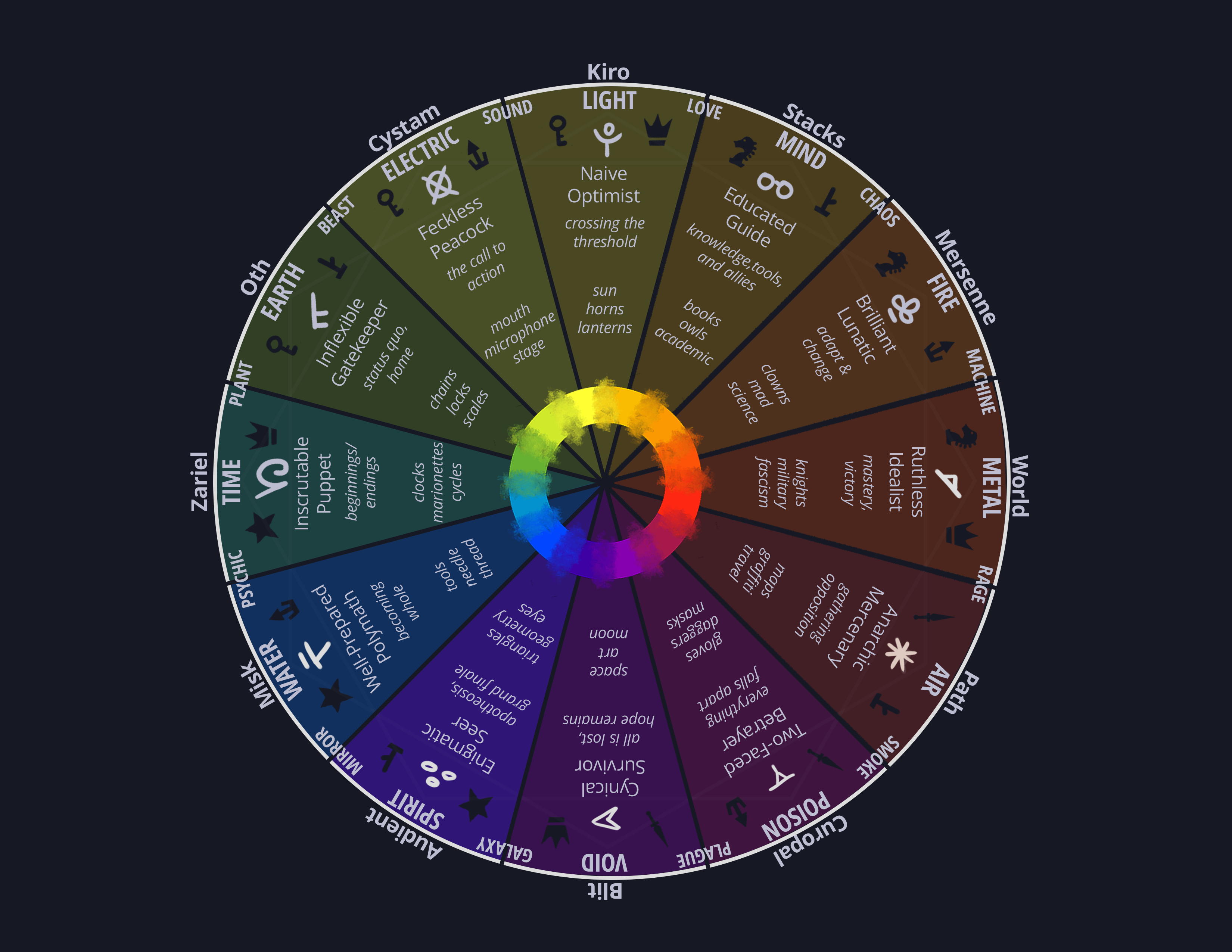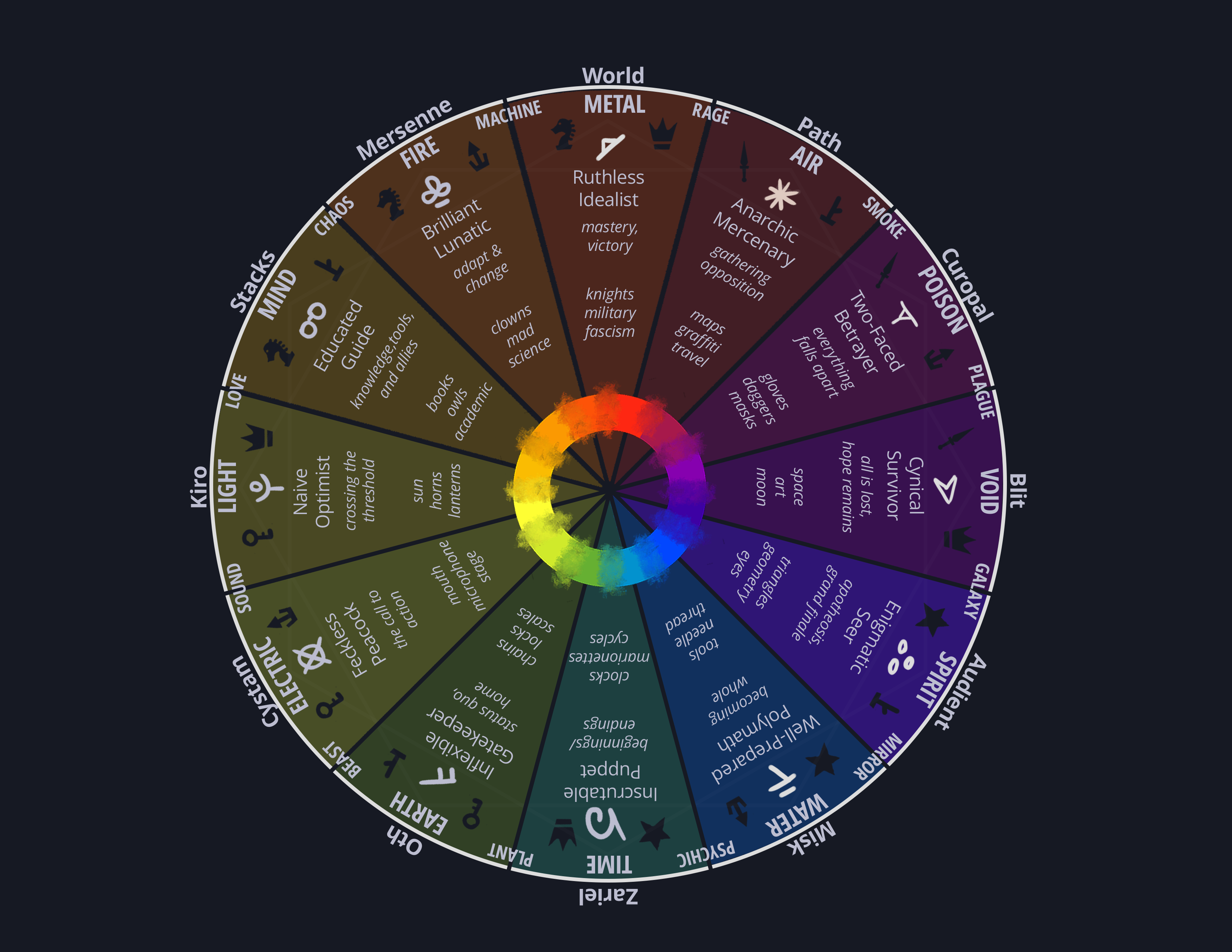Introduction
What Is This?
Let's imagine you need to crack together a world, or a story, or a video game.
There are a few ways to start writing a story - with a story outline, or by doing impressive amounts of worldbuilding.
The Groovelet: Portable Mythology is intended to help with either of these things, as a creative exercise/aid.
It is a Creative Commons framework, so you can do whatever you like with it! Copy it whole and make your own! You're free to do that - heck, you're encouraged to do that.
Okay, but What IS It?
The Groovelet: Portable Mythology describes a set of 12 interlinked archetypes, arranged on a wheel, with a web of symbolic interconnection linking and unifying the 12 "spokes" of the wheel.
12 archetypes, grouped into 4 suits, each with themes, oppositions, and a role in a larger story cycle, with contrasting elements arranged opposite from one another.
Each archetype in the Groovelet pantheon is thematically unique, distinct, with a built-in conflict with another Groovelet on the opposite side of the wheel.
Think of this like someone rammed the Greek Gods, the Tarot, TVTropes, and the Dan Harmon Story Cycle all together into one short, easy-to-read document.
How to Use It
You could take these archetypes and make them into
- Twelve gods
- Twelve characters
- Twelve factions
- Twelve superheroes
- Twelve corporations
- Twelve alien species
- Twelve RPG classes
- Twelve schools of magic
Use them in your fantasy novel, video game, TTRPG, or weird erotic fanfiction!
If twelve is too many you can also leave some out.
Audience
You are a writer, or a worldbuilder, or a gamemaster.
You want to build your own canon, rather than using someone else's, but you want that canon to be built on a robust and interconnected thematic framework.
Maybe you've thought of basing it off of something like the Four Elements, the Tarot, or the rich thematic archetypes in The Writers' Journey!
Maybe you're making a game and you're starting to divide your mechanics up into Air, Earth, Fire, and Water, and thinking "this could use a little more verve". Why not twelve elements?
Constraints breed creativity. Structure and patterns are a good way to get the juices flowing, and plus: people like it when things line up evenly.
Why not Just Use The Tarot, or the rich thematic archetypes in The Writers' Journey?
Well, for one thing, these resources are very dense, open-ended, and a little hard to work with. The Tarot is bogged down with occult mysticism, The Writers' Journey is bogged down with academia.
And, honestly: there are 22 Major Arcana in the Tarot. have you ever tried to write 22 of a thing? Nobody wants to wander into a story with 22 schools of magic. You'll get as far as The Fool, The Magician, and the High Priestess and your well of ideas will run bone dry.
The Groovelet framework is intended to be modular, remixable, easy to adapt, and flexible: it's ready to fit right in to your project. Heck, 12 is the perfect number for a thing to be made out of. Two halves, four quadrants made of triplets, six pairs, it's beautiful.
Why not use the Four Elements?
It's been done, so, so, so many times.
Getting Started with Lenses
The Problem: Thoughtful, Evocative Worldbuilding
I'm going to start by describing a problem: How do we layer detail into our world or game universe without getting bogged down in irrelevant-feeling details?
Well, by adding systems! Systems that emphasize contrast.
Let's say we're designing corporations for a cyberpunk universe:
- Mandolin Manufacturing
- Zeppo Heavy Industry
- Lentellus Astronavigation
- Supranational Broadcast Corporation
Before long that just starts to read like a list of names, ungrounded in any metaphor that we could use to quickly understand them.
So, we layer in subtle elemental associations:
- Mandolin Manufacturing - earth, solid, reliable, slow-moving.
- Zeppo Heavy Industry - fire, shoot first and ask questions later.
- Lentellenus Astronavigation - water, flexible and fast-moving.
- Supranational Broadcast Corporation - air, everpresent and hard to pin down.
All of a sudden these corporations start to feel flavorful, more well-developed, and in better contrast with one another. Plus, that system is also an easy metaphor for readers to quickly digest.
So, this system has improved our world design!
It goes deeper, though, we could add more systems!
Each corporation could also have an associated kind of instrumental music: waltz, polka, cha-cha, dirge.
That gives us theme and flavor whenever the corporation is referenced in the story. If we hear a waltz, we'll think of Zeppo Heavy Industry.
Now, to start out with, that's quite easy to do, but not terribly satisfying: okay, now we have a corporation that has "cha-cha" and "Earth" associated with it, but what good is that? Why does that matter?
Hopefully the fun part of this book is that we can develop an interesting interplay between the systems at play: the element "void" would associate well with the musical style "dirge", so we pair them up.
As an example from the world of Avatar: the Last Airbender, the four elements were stacked with four different styles of martial arts: Fire was a broad and flashy shaolin-style kung fu, whereas Water was paired up with the soft, control-focused Tai Chi, and these connections felt satisfying and resonant because they matched up cleanly with their elemental associations. On top of that, the elements were also stacked with emotional connotations: Fire characters tended to be passionate and hot-tempered, Earth characters stable and solid, and so forth.
This "systems-first" world design ends up feeling very coherent and cohesive.
The more systems we stack and try to keep consistent with one another, the more rich and detailed our world becomes. It invites a kind of pleasing interconnectedness that feels satisfying to interact with.
Throughout this book, I call each different "system" that we could apply to a world design a "lens".
Using This Book
This book contains a wide variety of different systems (lenses) that stack with one another - some of them rich and characterful (like the characterization lens) - others totally cosmetic and easily disposable (like the color lens).
When we tie all of the lenses together, we end up with something that feels comprehensive and detailed, and I illustrate them all with the complete wheel:
Whoa there! That's a lot of information! And it's in a wheel, a format that's notoriously hard to read on a digital device without craning your neck way around.
That's a bit dense and inscrutable at the moment, which is why we can unpack it by looking at it through each of our lenses.
It starts much more simply:
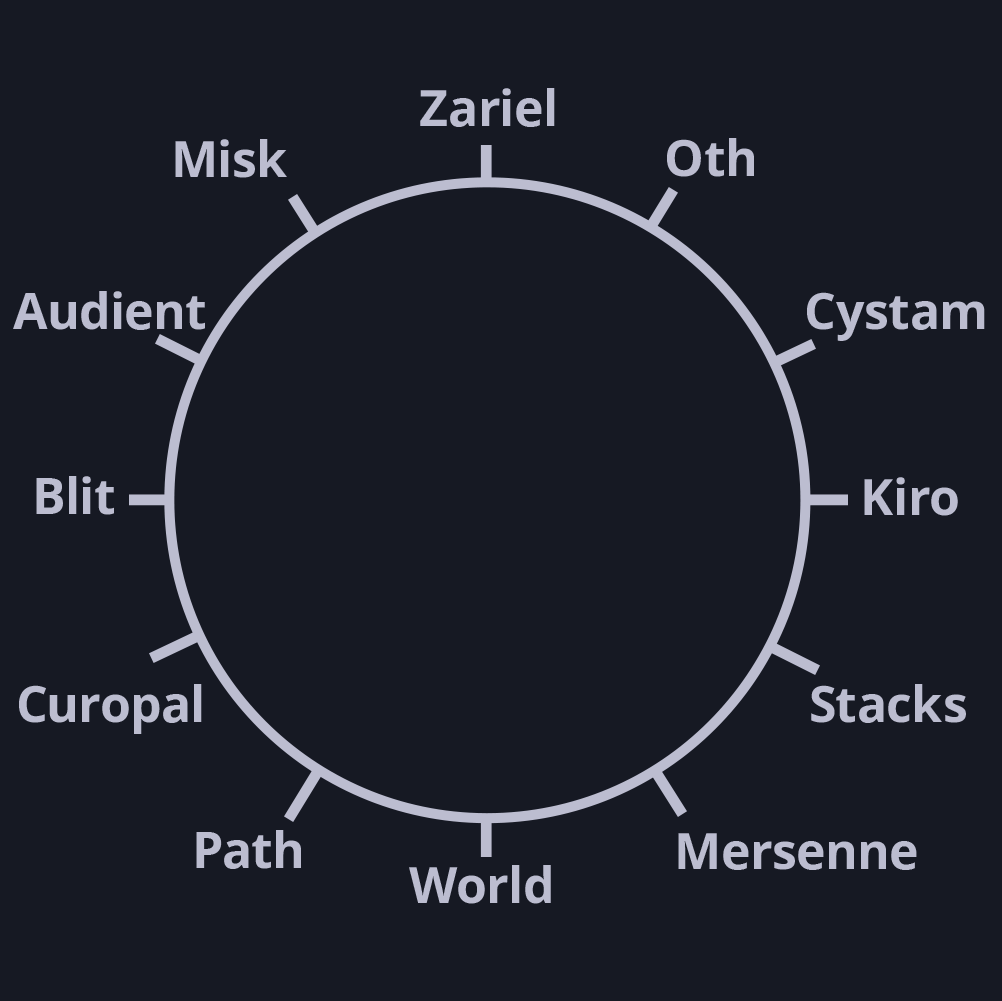
Just a blank template, names to layer details over.
As an example of how this plays out, it develops our initial blank archetype, Blit, and connects it to:
- a broad idea: the artist.
- a characterization: dour and cynical, but secretly hopeful and brave.
- a role in the story: as a vector for "darkest before the dawn" moments.
- an elemental association: void, plague and gravity.
- game mechanics: removal, spreading, and vastness.
- a color: dark purple.
- connected visual symbols: space, art, moons.
Hopefully this collection of thematically connected details starts to make the "Blit" category feel thoughtful and well developed: but also, these thematic associations are not prescriptive about story or setting. A Blit could just as easily exist as a dour plague religion in a fantasy story, a hole-themed superhero in a comic-book setting, a gothic art collective in a contemporary modern tale, or a profit-seeking human-recyling corporation in a cyberpunk universe.
As an example of a more fully realized world built in the Groovelet framework, I've provided the Sample World: Harmony in the Homework section.
This book is organized:
- First, with an in-depth look at each individual lens.
- Then, with "the complete wheel" and indexed examples, per archetype, of what each archetype looks like with all lenses applied.
- Finally, with homework: suggestions for things you might do with the lenses, as well as examples of worlds and art designed with the lenses in mind.
The Lenses
By Characterization
Start Here if You're Developing Characters
Each archetype has a distinct characterization or set of characterizations that can be used to develop this archetype into a more well-realized character.
This is a foundational, load bearing lens: everything after it connects to these fundamental twelve characters.
While each lens is optional, this lens may be the least optional.
By Role in the Story Cycle
Start Here if You're Developing Plot Outlines
Each archetype in the Groovelet: Portable Mythology embodies one phase of the story cycle.
It's a good way to help imagine when in your story these archetypes may be useful.
By Element & Game Mechanic
Start Here if You're a Game Designer
Each archetype corresponds to an element and set of game mechanics.
This is where we start to tie our loose, emotional, abstract characters to concrete elemental associations and ideas.
Really, up until this point our lenses offer very little guidance on what characters might look like, or what they might be able to do, and this is where elements and mechanics start to help.
By Thematic Symbol, Color, & Glyph
Start Here for Visual Reference
This lens is aesthetic, and optional.
Each archetype is connected to a thematic symbol, like "Chains" for Oth, or "Puppets" for Zariel, as well as a color, and an easy-to-draw glyph.
These symbols provide quick, easy to understand visual analogues for some of the concepts we've already explored.
By Suit and Court
This lens is pure flavor.
Like in a deck of cards, the archetypes are split into suits and courts: four suits (Keys, Wands, Swords, and Moons), and three Courts (Roots, Agents, and Crowns).
Leitmotif and Music
Each archetype has a unique position on the wheel of fifths, a leitmotif and style of music.
The Twelve and the Wheel
How do we organize all of the concepts in our set of lenses? There are so many!
We're going to start with twelve points, on a wheel, organized like the times on a clock.
This is wholly artificial organization! But it's convenient and evocative.
Why 12?
12 is a number with many divisors: 12 can be divided easily into 6, 4, 3, and 2.
Numbers with many divisors tend to be practical and pleasant to work with and show up frequently in myth, legend, and engineering: time has 12 hours1 (and 60 minutes, 60 being another number with many divisors), music has 12 notes, the year has 12 months, there are 12 basic hues in the color wheel, it's a number that feels complete.
and 60 minutes. 60 is another number with many divisors: numbers in this set,
2, 6, 12, 60, 120, 360, pop up often.
Why a Wheel?
The obvious symbolic connection with clocks, the circle of fifths and the color wheel help.
It also creates a few useful outcomes:
- Elements in the wheel are naturally opposed to elements on the opposite side of the wheel.
- Those "naturally opposed" elements are positions where we can create conflict, and conflict is good.
- The beginning of the wheel is linked to the end of the wheel.
- A wheel is a visually pleasing arrangement.
Each Spoke is an Archetype
At each of the twelve positions on the wheel we are going to put a thing.
That thing? One of our 12 archetypes.
Let's Name Every Archetype

"What, it's just a bunch of weird names? I can come up with my own weird names."
Okay, yes - you can, and should. These are placeholder names: I need a name for each spoke, so that I can track all of these mixed metaphors across each of their different invocations.
As we explore the various lenses in which the archetypes exist, that wheel will start to get very crowded with more information about each spoke.
That's Not A Circle, That's a Dodecagon!
You make a good point, but somehow when I arrange it that it makes me look like a crazy person:
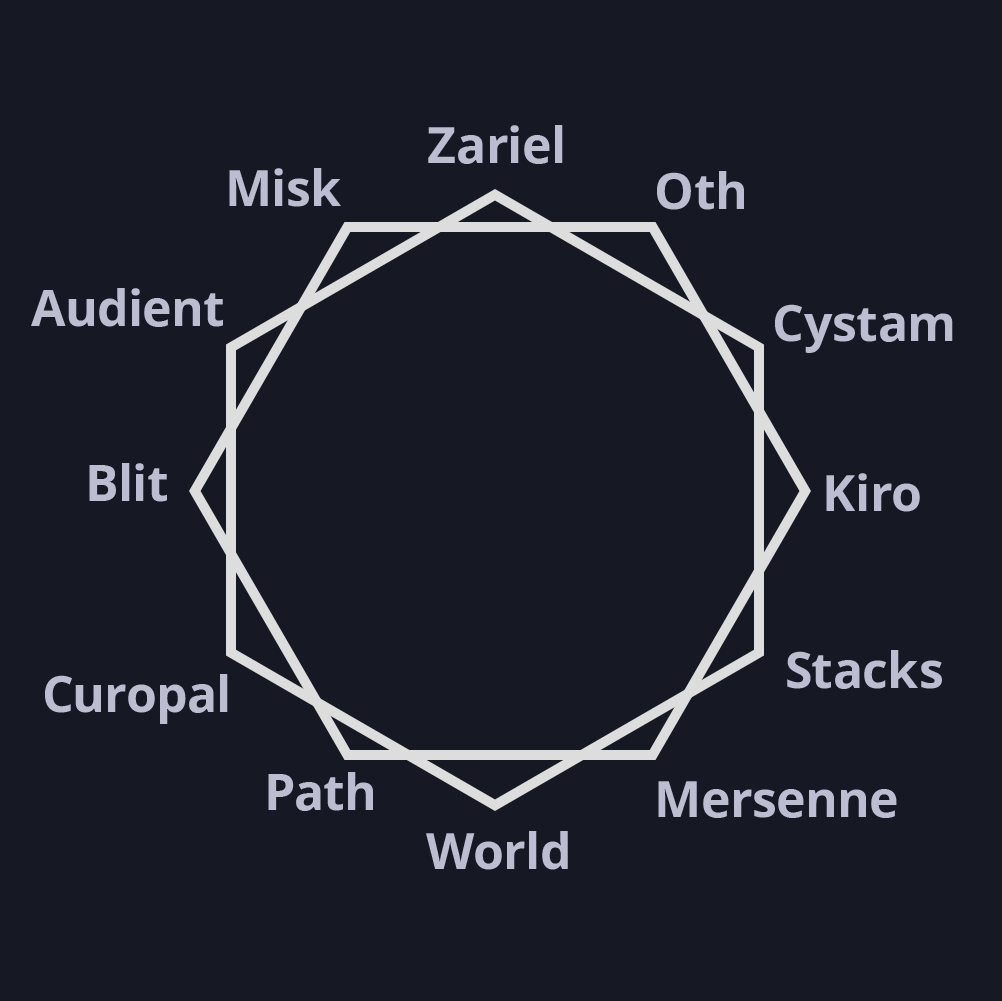
Even I'm just self-aware enough not to try and get folks on board with the mythology dodecagon.
It's a circle. A nice, easy-to-work-with circle. Forget you ever saw a dodecagon.
Natural Conflict Between Archetypes
Broadly, let's get some thematic tension up in this system!
- Oth and Path will represent Order vs. Chaos
- Cystam and Curopal will represent Extroversion vs. Introversion
- Kiro and Blit will represent Optimism vs. Pessimism
- Stacks and Audient will represent Thinking vs. Feeling
- Mersenne and Misk will represent Creativity vs. Practicality
- World and Zariel will represent the Antagonist vs. the Protagonist
These themes will be explored much more thoroughly in the individual lenses.
Archetypes
Now, let's start with a brief overview of each of the archetypes:
1. Oth, The Warden
Oth is the archetype of security, order, and constraints.
2. Cystam, The Broadcaster
Cystam is the archetype of connection, signal, noise, and announcement.
3. Kiro, The Trumpet
Kiro is the archetype of optimism, new beginnings, initiative, and inspiration.
4. Stacks, The Archivist
Stacks is the archetype of knowledge, detail, revelation, and exposition.
5. Mersenne, The Jester
Mersenne is the archetype of chaos, luck, madness, insight, and cleverness.
6. World, The General
World is the archetype of challenge, honor, and antagonism.
7. Path, The Freelancer
Path is the archetype of freedom, anarchy, and rebellion.
8. Curopal, The Servant
Curopal is the archetype of hidden agendas, facades, and betrayal.
9. Blit, The Artist
Blit is the archetype of art, grief, despair, emotion, and expression.
10. Audient, The Seer
Audient is the archetype of faith, hope, apotheosis, transcendance and omniscience.
11. Misk, The Quartermaster
Misk is the archetype of collection, recovery, wrap-up, loose-ends, utility, and adaptation.
0/12. Zariel, The Marionette
Zariel is the archetype of choice, fate, meta-awareness and inevitability.
Okay! Now What?
Our next step is to talk about the various different interpretive lenses we can apply to each of these archetypes!
We're going to start with characterization: who are each of these?
Characterization
One way to view the 12 spokes in the Groovelet Portable Mythology is with differing characterizations.
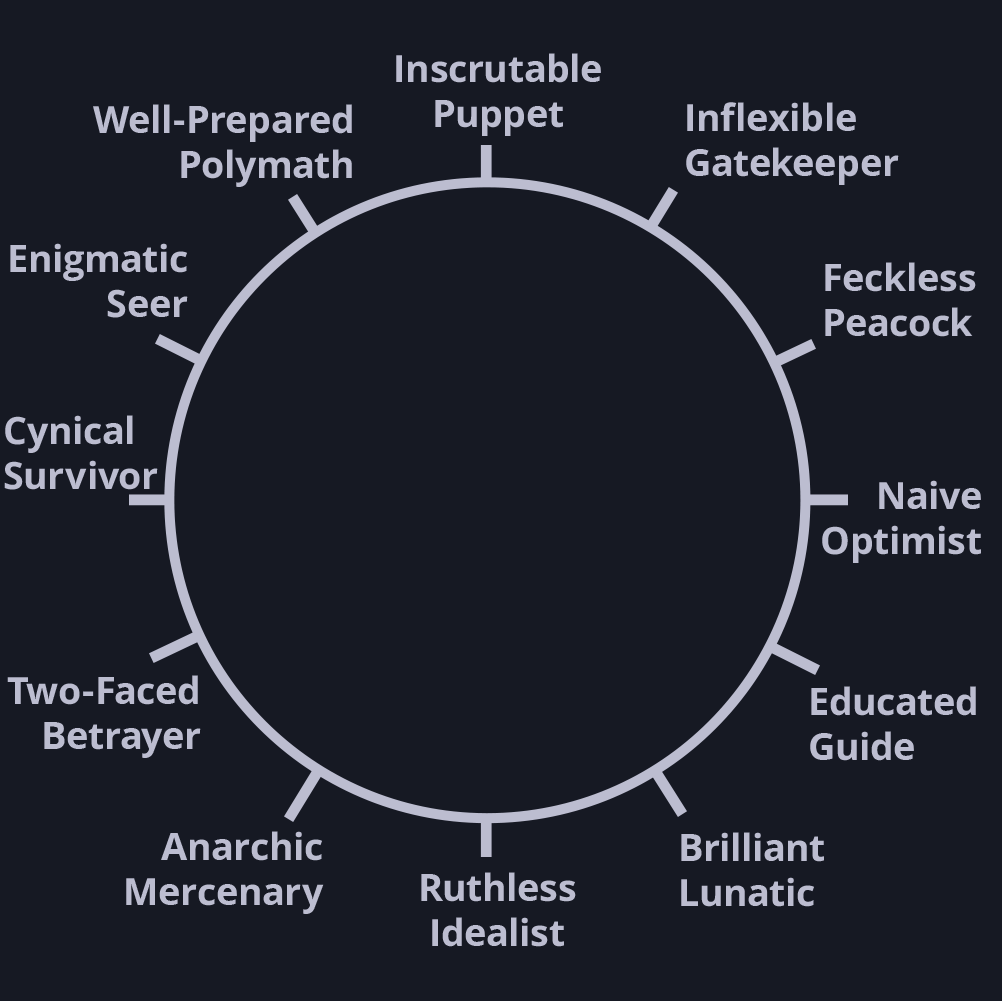
Let's look at each of these in a lot more detail:
Oth
Thinking inside the box.
While, ultimately, Oth is motivated by a desire to help others, their utter inflexibility and focus on rules and regulations ends up making it difficult for them to do so.
What they've found, however, is that their respect for the rules and the value of hard work have allowed them to become moderately successful, and they are willing to lord their tiny scrap of power over others with impunity.
Well suited to roles in law enforcement and middle management.
The Dramatic Question
They want to help, but they are bound by their rigid adherence to norms and laws.
Can they be convinced to loosen up and do the right thing even if it involves breaking a rule?
Design Notes
Oth's resistance to change can make them a bad choice of protagonist because they won't do anything unprompted. This also can make them a wonderful comedy protagonist because watching the world slam into this unyielding rock can be very funny, and sometimes, improbably, the rock wins.
Oth is great in stories about moral dilemmas or systemic issues, because they can serve as an easy object lesson in how "rules" or "laws" are not a cheat code to perfect morality - many legal things are heinous, many illegal things are laudable, and Oth is utterly unable to come to terms with this complex truth.
Similar Characters in Media:
- Dwight Schrute (The Office) - Initially little more than a rule-following kiss-ass, nine seasons of development started to bake Dwight into a more fleshed out and well-rounded character with an agricultural background and a strong but often misguided sense of right and wrong.
- Inspector Javert (Les Misérables) - A police inspector and one of the best-known "lawful is not always good" archetypes of all time. When he finally realizes that the law and morality are not one-and-the-same he has so much trouble reconciling this that he commits suicide1.
- Hank Hill (King of the Hill) - the conflict between Hank's rigid traditionalism and the evolving social mores of the fictitious town of Arlen, Texas often drives the show's comedy.
- Arthur Dent (Hitchhiker's Guide to the Galaxy) - what Arthur wants is simplicity, predictability, and a universe that makes orderly sense to him. What he gets is not that.
- Hermes Conrad (Futurama) - His job is simply "bureaucrat" and he akes obvious, distinct pleasure in procedure for its own sake.
150+ year old spoilers. In fact, if you're allergic to spoilers, just don't read the "similar characters in media" sections of this document at all.
Contrasting Opposites
Oth and Path exist on opposite ends of the law + order / freedom + anarchy spectrum.
Oth believes firmly in rules and regulations, and in following a structured path to a goal, whereas Path chafes at laws or being told what to do and prefers a more improvisational approach.
Cystam
Pay attention to me!
They want nothing more than to be the center of the attention at all times.
They're narcissistic, intensely people-pleasing, but not necessarily out of a genuine desire to help - out of a desire to continue to be the center of attention. Cystam would give generously to charity, but only if someone was watching.
Lacking any kind of concrete or permanent moral anchor, they instead are willing to take on any philosophy so long as someone who is a true believer is in earshot.
Well suited to politics, sales, C-level business, and of course - acting.
The Dramatic Question
They want, more than anything, to be loved, but they lack the emotional intelligence and kindness to be the kind of person that can be loved, instead settling for just being paid attention to.
Who are they, under the show that they put on? Can they learn to be the kind of person who can step out of the spotlight and meet someone else's needs?
Design Notes
Cystam's performative morality is a fun thread to pull on. How much of our personalities are performed rather than real expressions of our own true selves?
Can pretending to care turn into the real thing?
Similar Characters in Media
- Zapp Brannigan (Futurama) - intended as a jab at Star Trek's Captain Kirk, Zapp Brannigan is space legendary for being bold, brash, and heroic, and utterly fails to live up to the hype. He's much more occupied with the business of seeming heroic than being heroic.
- Michael Scott (The Office) - Michael Scott craves human connection and family, but is unable to grasp these things because of his pomposity and immaturity.
- Brett Hand (Inside Job) - Hired for a role he is utterly unqualified for because of his generic, pleasing face and congenial tone, he finds a comfortable equilibrium by sanding off the rough edges of his unpalatable colleagues until they can work together.
- Frasier Crane (Frasier) - Pompous, overstuffed, and self important, they believe themselves to be a wise mentor archetype, but they're much more often an easily enraged buffoon.
Contrasting Opposites
Cystam and Curopal exist on opposite ends of the public / private spectrum:
Cystam is loud and draws attention to themselves while Curopal prefers to disappear into the background.
Kiro
We can do it!
This bundle of optimism, determination, and energy can't help but move the plot forward with their fresh, ill-concieved ideas.
Naive but boisterous, their plans, while definitely well-intentioned, often fail and create enormous and long-lasting problems. What's worse is that they are so optimistic that they won't stop at simple failure: they'll just keep on trying.
At best, a more experienced and thoughtful character will be inspired by the failure and enact some real and lasting change.
The Dramatic Question
Their unflagging desire to help and do good seems inexhaustible, but nobody could stay upbeat for so long. Can they stay persistent in the wake of setback after setback?
Does their boundless optimism make them emotionally brittle when they do fail?
Has their unflagging drive to achieve their goal blinded them to a more important truth?
Design Notes
Kiro is a story starter - even if they're not the protagonist, (although they are often the protagonist) their role is to act as an agent of change, to get the engine of the story running.
Because the loop of "almost-clever idea" to "embarrassing failure" to "returning to the status quo, having learned a lesson" is such a well-worn comedic structure, a Kiro archetype often drives the plot in comedy.
Outside of a pure comedy universe, the Kiro can be a vital component of a story because the story simply requires a heart - someone who believes, unwaveringly, that positive change is possible, that people are good and worth fighting for.
Similar Characters in Media
- Leslie Knope (Parks & Recreation), Janine Teagues (Abbott Elementary) and J.D. (Scrubs) - this sitcom character's infectious enthusiasm and poor planning gets them in over their head.
- Steven Universe (Steven Universe) - both the naive driver of a number of plotlines and the optimistic heart at the center of the show, Steven resolves a number of heated situations with kindness and healing rather than violence.
- Jayce & Viktor (Arcane) - their optimism that technological development can improve peoples' lives may or may not bring about an apocalypse.
Contrasting Opposites
Kiro and Blit exist on opposite ends of the optimistic / pessimistic spectrum:
Kiro is bold but naive and easy to get fired up, but may be easily discouraged, whereas Blit is pessimistic, realistic, and resilient.
Stacks
That is a terrible idea, and here's why.
Nerd alert. Especially in magical or fantastical settings, sometimes we just need someone who can explain things.
Stacks isn't just a fountain of information, though, they're a guide - someone with some experience and wisdom.
Unfortunately, that experience also breeds a certain healthy skepticism and cynicism about what's possible.
Their experience can resolve as pompousness or self-importance, which is fun to skewer - they don't always know everything, but they're willing to pretend.
What they don't have is a lot of impetus to do things. Without someone around to prod them, Stacks is happy just dealing with the status quo - they've found a pleasant enough niche and they intend to dig in and stay there.
Often, keeping a character this experienced around can be detrimental to the plot, which unfortunately can mean a high mortality rate for Stacks' in media.
The Dramatic Question
They are capable, and want to help, but their pragmatism makes them unwilling to put their neck on the line. Can they be convinced to risk it all?
Can they accept that there are some things that simply cannot be known?
Can they, for once, survive to the third act?
Design Notes
It's often important to limit the amount of Stacks in the story.
Stories are more vibrant and exciting when they're not bogged down in loads of exposition from a character who isn't predisposed to action. That's what I am, and nobody would read a story about me.
Stacks can be great in the early half of the story to contextualize confusing events - "why, that's the kind of power that you only see in The Lightbringer once per generation!" - but many creative writing guides will warn you about overreliance on exposition.
Few people are going to want to engage with a 30 minute long exploration on the ethics of wormhole travel when the wormhole is right there, waiting to be explored. Have a Kiro or a Mersenne push right on past the warning signs and keep the story moving.
These creative writing guides are wrong. Exposition is the best, I'm going to write 100 more pages of just raw lore and you can't stop me, creative writing guides.
Similar Characters in Media
- Obi Wan Kenobi (Star Wars) - there's a call to action that Luke recieves - a hologram begging him for help - but without Obi Wan to explain to Luke what a Jedi is and how they need to proceed, this story can't really go anywhere and Star Wars ends early, with Luke confused and getting melted on Tattooine.
- Dr. Cox (Scrubs), Barbara Howard (Abbott Elementary) - this cynical, competent long-standing employee is so jaded by their own struggles to do any kind of a good job that they mostly rain on our protagonist's parade when they try to accomplish anything new. Ultimately good-hearted, they can be compelled to help by watching the protagonist try and fail a few too many times.
- Basil Exposition (Austin Powers) - see, the joke is they put "exposition" right in his name and his entire role in the story is to explain the plot and stakes to Austin and periodically move the plot along with instructions.
Contrasting Opposites
Stacks and Audient exist on opposite ends of the thinking / believing spectrum:
Stacks catalogues and processes real data and comes to careful, reasoned conclusions whereas Audient believes intuitively without needing much in the way of evidence.
Mersenne
Thinking so far outside the box that you could file a missing persons report with the police for the box.
Mersenne is interested in stirring something up, and they don't much care what it is so long as it is interesting.
Their motivation isn't power, wealth, or riches - they simply can not stand still.
There's a good chance that they are utterly brilliant. Or mad. It's hard to tell - whatever game they're playing, they haven't bothered to explain it, so it's not clear whether they're playing 5-dimensional chess or if they're trying to win at poker with a five of clubs, a six of hearts, a Get out of Jail Free card, and a Subway "Eat Fresh" gift card.
They almost seem like a force of nature.
The Dramatic Question
Whose side are they on, anyways? What are they trying to accomplish?
Why did they think this would be a good idea?
Design Notes
In the same way that Kiro can be counted upon to come up with a good but naive idea and optimism to drive the plot forward, Mersenne can be counted upon to do anything to make the plot do... anything.
You're sitting and staring at a blank page, trapped. Fuck. Okay, your Mersenne character walks in trying to balance six pounds of loose oranges in their arms. Some of them roll away. What? Okay, now we have something to dig in to. Where did those oranges come from? Why did they grab six pounds?
Similar Characters in Media
In other "Similar Characters in Media" sub-sections I've tried to keep the lists short and tight and edited, trying to keep the characters distinct and explain why I included them.
In this sub-section you're just getting a laundry list.
- Janitor (Scrubs)
- Janitor (Abbott Elementary)
- Cosmo Kramer (Seinfeld)
- Joker (Assorted Batman)
- Dr. Strangelove (Dr. Strangelove)
- Professor Farnsworth (Futurama)
- Tracy Jordan (30 Rock)
- Beetlejuice (Beetlejuice)
- Gamzee (Homestuck)
- Vi (Arcane)
- Doc Brown (Back to the Future)
- Kefka (Final Fantasy VI)
- Jack Sparrow (Pirates of the Caribbean)
Contrasting Opposites
Mersenne and Misk exist on opposite ends of the acting / planning spectrum:
Misk is prepared for anything, Mersenne doesn't plan at all.
World
This hurts me more than it hurts you.
Aggressive, domineering, and in charge, World is fond of saying single words authoritatively:
Focused. Intense. Proud. Stoic. Authoritarian. Unyielding. Ironclad.
They are idealistic, driven, and trying to make the world a better place - perhaps they started as a starry-eyed dreamer like Kiro. Unlike Kiro, they are ruthless. Willing to accomplish their goals at any cost may make them the villain, but it works.
Heavy is the head that wears the crown, and these characters are often lonely and isolated.
The world won't just become a better place on its own: it must be forced.
The Dramatic Question
Can World finally accept that there is a human cost that is too much even for them to bear in order to chase their dreams of a better world?
Design Notes
It's important to separate the ideas of "antagonist" and "villain", even though they are often one and the same.
An antagonist can be any person, character or force that opposes the protagonist - any character in the Groovelet pantheon can be an antagonist or a protagonist, and often a good choice for an antagonist is one from the opposite side of the wheel as the character they're opposing - an anarchic Path might be antagonized by a rigid Oth, their fight being one defined in terms of freedom vs. security.
What World represents, however, is a sympathetic villain character, a well-intentioned extremist who will go too far in their pursuit of their goals. This can also make for an interesting and vibrant protagonist, making them a compelling anti-hero.
It's common for World archetypes to be honorable and trustworthy, to have many good qualities despite their ruthlessness. They're a sympathetic villain - if only they weren't so entrenched in their own viewpoint.
Similar Characters in Media
- Silco (Arcane1) - once a revolutionary hoping to build a better life for the people of Zaun, he crosses the moral event horizon a number of times in his quest for independence. With the goal firmly at hand, he finally reaches a breaking point when he is presented with a simple-seeming cost too high for even him to bear.
- Ozymandias (The Watchmen) - depending on your point of view, he saves the entire world from collapsing into a horrendous third World War by killing every last person in Manhattan, or he just kills every last person in Manhattan and doesn't affect the outcome of the situation much at all. Either way he's both willing to do this and haunted by his own decision.
- Joel (The Last of Us) - As he starts to develop a relationship with the precious cargo he's expected to ferry across the post-apocalyptic United States - a teenage girl - he is faced with the terrible cost of his quest to save humanity from a deadly plague.
- Ellie (The Last of Us 2) - Utterly consumed by a desire for revenge, she is unable to come to terms with the terrible human cost of her actions.
- Lord Ruler (Mistborn) - Whoops it turns out that all of their Evil Overlord schtick was borne out of a series of misguided attempts to save the world from a greater evil.
the throughline of Arcane is "an exploration of the cost of power" and has a really in-depth example of this kind of character from a lot of different angles.
Contrasting Opposites
World and Zariel exist on opposite ends of the agency spectrum:
World is constantly moving themselves towards their own clear and unambiguous vision of an ideal world, whereas Zariel's motivations are hazy and enigmatic, and they operate only at the behest of a third party.
Path
I'm in as long as you're feeding me.
A competent, mercenary, go-with-the-flow type who's mostly along for the ride because there might be a free lunch involved.
Their goal is to get paid, leave, and disappear once more to their solitude.
Their desire for freedom borders on the anarchic - they're the sort who might shout "I don't live by society's rules" after being asked to wash their hands in a public bathroom.
The Dramatic Question
What happened that made them want to separate themselves from society like this?
Are they loyal to anyone?
Their desire for freedom and independence separates them from the events of the story. Will they commit to a cause or leave everyone in the lurch?
Design Notes
The most common Path arc is their journey from outsider to insider - this loner once again becoming part of a crew and letting themselves be tied down.
Their emotional detachment from the rest of the cast of the story allows them to provide a unique external perspective - if, for example, everyone's cooperating in a world where cooperation is rare, Path can draw attention to how unusual that is.
Similar Characters in Media
- Lightning McQueen (Cars) - A great exploration of the "outsider to insider" arc, Lightning is forced by a plot contrivance to come to a small town and introspect about how his selfish lone-wolf attitude and singular focus on his goals won't lead him to happiness.
- Spike Spiegel (Cowboy Bebop) - Distant and haunted, his mysterious and oft-alluded-to grim backstory leave him nothing more than a leaf on the wind and keep him from embracing the unique found-family right in front of him. He dies unable to shake the ghosts of his past.
- Han Solo (Star Wars) - Only reluctantly helps because he is massively in debt, eventually discovers that there is something worth fighting for outside of his own self interest.
Curopal
You first. No really, I insist.
Obsequeious. Sneaky. Polite. Cold. Calculating.
Curopal is a white glove with a hidden knife - polite, efficient, and ready to stab you in the back the moment you're not looking.
They've devised a plan where no matter what happens: they come out on top. On top of that, nobody even knows that they're involved.
They take no risks, place no bets, do not expose themselves or their intentions, and somehow still win.
They're not terribly powerful, even - in direct confrontation they'd be as harmless as a baby kitten1 - their strength is in their ability to put the knife in at exactly the right moment.
Or not, you're the writer, not me.
The Dramatic Question
Can they be trusted?
No - okay, then, if it is in their best interest, then can they be trusted?
Still no? Good instinct.
How will they twist the situation to their own advantage?
Design Notes
An interesting subversion of the Curopal archetype is when they've actually been working for the "good guys" the entire time. Sometimes a character can be utterly despicable and people will still root for them because they're able to achieve something positive.
Curopal characters are often information brokers, they can also be useful at delivering crucial but hidden information.
The most obvious use of a Curopal in a story is in a dramatic, surprising twist!
They might be more impactful, however, if the audience knows about them well in advance.
As Alfred Hitchcock famously laid out in an interview:
Let us suppose that there is a bomb underneath this table between us. Nothing happens, and then all of a sudden, “Boom!” There is an explosion. The public is surprised, but prior to this surprise, it has seen an absolutely ordinary scene, of no special consequence. Now, let us take a suspense situation. The bomb is underneath the table and the public knows it… In these conditions this same innocuous conversation becomes fascinating because the public is participating in the secret.
In the first case, we have given the public fifteen seconds of surprise at the moment of the explosion. In the second we have provided them with fifteen minutes of suspense. The conclusion is that whenever possible the public must be informed.”
Why have surprise when you could have intrigue?
Similar Characters in Media
- Varys (Game of Thrones) - an information broker and spymaster, despite his lack of formal or martial power he regards himself as a representitive of the people of King's Landing and attempts to operate on their behalf.
- Ex-P.F.C. Wintergreen (Catch 22) - oddly influential in the world of Catch 22, Wintergreen is a mail clerk who's gained power by virtue of a man-in-the-middle attack on the bureaucracy of the military: he can reroute and forge orders, making him the most powerful man in the Air Force.
- Cypher (The Matrix) - sick of the abysmal living conditions in the rebellion, he switches teams and offers to work for the machines. This betrayal kills off most of the peripheral allies and teammates of the cast, leaving just a handful of main characters (Neo, Trinity, and Morpheus) for the big finale.
Blit
I couldn't have stopped you from going on this ridiculous mission, so I'm here to try to keep you alive for as long as is reasonably possible, which won't be long.
Blit is a black hole of cynicism.
There is no plan they can't poke a hole in, no parade that they can't rain on.
That cynicism is an armor: deep inside, Blit is creative, expressive, emotional, a side of them that must be kept on tight lock to protect it. Blit is resilient and clear-eyed.
They've been through hell and what's come out the other side is someone who can weather any storm.
Blit's cynicism also calls for a kind of true courage. They can look danger in the eye, understand the full gravity of the situation, know that things are likely to go very badly, and then, face it anyways.
The Dramatic Question
What have they been through that made them like this?
What are they really like, inside that armor?
What's the thing or person who can get past their defenses and see them for who they are?
Design Notes
One of the most obvious reasons to have this character around is that people tend to believe cynical characters, more. It grounds the danger of a situation when someone points out that the most obvious outcome in a fight between a giant and a small boy with a sling is "the giant will absolutely wreck that boy".
Without C-3PO, nobody would know that the possibility of successfully navigating an asteroid field is approximately three thousand seven hundred and twenty to one - and thus, successfully navigating the asteroid field would be a lot less impressive or interesting.
Similar Characters in Media
- The Hound (Game of Thrones) - for such a hardened pragmatist, The Hound sure seems to find himself doing the right thing more often than not.
- April Ludgate (Parks and Recreation) - an an intentional and comedic subversion, when we go to examine April's home life to discover why she's such a relentless sourpuss, we discover happy, ebullient parents who love her dearly. She's not damaged at all, she's just like this because she wants to be.
- C-3PO (Star Wars) - comic and expository, C-3PO contextualizes and grounds the danger of a lot of scenes he's in - while also being humorously dour about his lack of control over the situation.
Audient
I'm not sure why I know this but I know this.
Faith. This character has big beliefs, strongly held, maybe even in opposition with reality itself. Audient has an unusual, almost alien perspective on things, and they often see meaning or purpose where others see coincidence.
They represent apotheosis. If Stacks is responsible for knowing things, Audient is the character most likely to have a direct, intuitive grasp of truth beyond logic or reason.
The "lethal joke character" of the party, they don't really seem to make much sense or act very effectively, until it all comes together and they turn into a literal god in the third act.
The Dramatic Question
What is their core belief? What's the absurd thing that they believe that sits at the center of all of their incomprehensible decision making?
Are their beliefs sane? Do they work? Are they internally consistent? Do they need to be? And most importantly of all: are they right?
Design Notes
As a bit of a Stacks myself I struggle badly with Audient characters. This was quite possibly the hardest of the twelve to write. Faith? Vile.
However - if it turns out that Audient was right all along - as is common in stories - then their mysterious actions provide a sense of unfolding mystery, allowing the audience to look back and reframe their delusion as brilliance. Satisfying!
Similar Characters in Media
- Morpheus (The Matrix) - the whole plot of the movie rests on the shoulders of his dogmatic belief that Neo is The One.
- The Oracle (The Matrix) - a literal prophetess who speaks in codes and riddles.
- River Tam (Firefly) - enigmatic and operating on a different wavelength from the rest of the cast, but easily the most dangerous of the lot.
- Dale Gribble (King of the Hill) - is a comedic example of an character whose big beliefs and defiance of reality are almost always entirely wrong, played up for laughs.
Misk
Finally, a chance to use my degree in underwater semiotics.
This Jack of All Trades provides a lot of utility and wears a lot of hats. Their strength lies not in their focus but in their versatility.
Chatting with Misk, you'll quickly discover that they spent a few months as a river-boat captain, one time they met the King, and that they can juggle professionally.
Their home is filled with curios and souveneirs. They've tried everything.
There are a few ways for this to go: sometimes a Misk will seem obscenely overqualified and well prepared for the task at hand. This is a good opportunity to have them fail miserably, establishing the gravity of the situation and putting the ball back in the court of our intrepid heroes.
Sometimes a Misk will seem to have a completely inadequate, abstract, or useless set of abilities and equipment for the task at hand. This is a good opportunity to have each and every one of those abilities pay off.
Dramatic Question
What are they looking for that they have been unable to find?
How will their useful, practical plans and preparations backfire?
How will their useless, impractical tools and skills unexpectedly pay off?
Design Notes
One of the biggest roles of Misk in a story is just to move the story along whenever a skill is required. Need a lock picked? Need a fact about ants? Need someone who can do close-up-magic? If a deus ex machina is needed to move the plot forward, instead that's an opportunity for Misk to have the right skill, ability, or item to intervene.
Just make sure to jump backwards into the plot and make sure that that skill, ability, or item is brought up at least twice beforehand.
There's a moment that's common in Wes Anderson films (borrowed from many storytelling traditions before that): the inventory. Early in the film, a character might show off various and sundry objects they have packed to accomplish a task. The dramatic promise being made here is that you will see each of these objects again, in the story.
The more unlikely the skill is to be useful, the funnier and more satisfying it is when it finally becomes useful: the one character only knows toaster repair and suddenly the aliens are revealed to be slices of bread. Finally: my time to shine.
Similar Characters in Media
- Worf (Star Trek: The Next Generation) - as a security officer, he's strong, prepared, and the perfect combination of skills required to solve most problems. As a result, he often gets tossed aside handily by a villain to demonstrate that this problem is different.
- Wile E. Coyote - his overpreparation: comedic. His failure: inevitable.
Zariel
...
Zariel is a tough one to characterize because Zariel's archetype is the one of the player character.
Often a silent protagonist, a blank slate, a neutral-feeling template for the player to project their own identity atop - they resist characterization because there's not much of a character left, there.
Sometimes they're good, sometimes evil. Sometimes competent, sometimes confused. Sometimes they roll backwards into a standing leap, push their face into the corner of the room, jump in a way that's frame perfect, and teleport directly to a confrontation with god.
They are the most powerful part of the story: the viewpoint that makes it real: without a viewpoint there can be no story, without a reader none of the book's characters mean anything.
However, not all situations call for a remote-controlled viewpoint character like this: it certainly doesn't make sense in a play.
Zariel in either sense is a character whose power is unlimited and whose motivations are utterly opaque.
In situations where the player isn't pulling the strings, Zariel becomes terrifying, an AI run amok, a clockwork entity with unclear goals and motivations, a character filled with demons all scrabbling for the controls, powerful one moment, confused the next, inevitable and unpredictable.
Dramatic Question
Who is pulling their strings? Are they aware that they are being controlled?
If they're controlled, can they break free?
If they do, who are they, under all of that?
Design Notes
Path is an outsider, but still rooted in the setting that they sit outside of.
Zariel is an outsider in a much broader sense: they are the character most connected to the outside of the story itself.
While "player character" was the initial idea for the role, here, in a non-interactive story Zariel might instead represent the narrator, or a character capable of comprehending or even breaking the fourth wall. If any character is likely to get uncomfortably metatextual it's Zariel.
As the player character, metatextual elements sneak in constantly because of the constant conflict between the non-diegetic game interface (menus, UI, save/load) and the universe of the game itself.
The player, the reader, the audience is an outsider in this world, the only thing in the entire story that is not of the world. They are both 100% in control of it (literally they are the "animating force" that makes the story exist: no reader means no story) and 100% unable to meaningfully affect the outcome (while the story may branch, every detail of the story as written was already set in stone before the player came along).1
Similar Characters in Media
- Frisk / Chara (Undertale) - this one is a fun exploration of the topic because the player and the meat-puppet they're inhabiting are explicitly different characters. This is explored further in the sequel (side-quel?) Deltarune.
- Flowey (Undertale) - a main character from the point of view of anybody who is not the main character is a kind of unstoppable, eternal cosmic horror.
- Gordon Freeman (Half Life), Link (The Legend of Zeldo), Mario (Various Mario) - this silent, neutral protagonist doesn't contribute much to the story on their own - most emotions are projected on to them or acted around them as they navigate the game world with a series of huphs, hoophs, wa-hoos and yips.
- Doc Scratch (Homestuck) - a proxy-narrator and an omniscient fourth-wall breaker, he's presented as something readers don't encounter very often: not an un-reliable narrator (Doc Scratch himself would point out that he is 100% reliable) but a narrator actively working at odds with the goals of the readers and the characters within.
A Dire Warning
Hopefully, reading the Characterization and Story Cycle lenses, you'll understand the thematic overlap between these characters and the parts of the story they're meant to mirror: Stacks, for example, represents both a mentor-style character, and a phase in the story where the protagonist is gathering skills and allies after being dropped into a strange new world.
You can take this too literally1 and write an honestly pretty unreadable story2 where twelve different characters show up at equal intervals throughout a story, perform their single function, and then disappear forever. This would be... a mess, and I highly recommend against it. For one thing: a fairly good bit of writing advice is not to introduce new characters at all after the first act.
You probably don't need all twelve characters to be prominent, or even present in your story - you probably don't even need them to be twelve separate characters, as more complex individual characters could have traits from multiple different archetypes. Characters can even exhibit character growth (ew) and evolve from one archetype to another.
A Blit+Path (pessimistic but hopeful cowboy) could evolve into a Kiro+Mersenne (an optimistic, unpredictable hero), that's character development!
i do, this is a problem I have
don't ask how I know
Look at where you're struggling in story development, and only introduce characters if they solve problems
Is the story too moored in the mundane and nothing much is happening? Drop in a Kiro or a Mersenne to agitate the plot a bit, or have a World show up and provide focused, concrete antagonism.
Is the story hard-to-follow and unclear? A Stacks might take this opportunity to explain.3
"The Drangers simply can't use the Amulet of Ro'bithazel to solve the problem because that would invoke the Curse of Melhethrazebrazar!"
Tables
| archetype | optimistic / pessimistic | extroverted / introverted | self interested / kind | thinking / feeling | closed / open |
|---|---|---|---|---|---|
| oth | pessimistic | introverted | kind | thinking | closed |
| cystam | optimistic | extroverted | self interested | feeling | neutral |
| kiro | optimistic | extroverted | kind | feeling | open |
| stacks | pessimistic | introverted | kind | thinking | closed |
| mersenne | optimistic | neutral | neither | neither | open |
| world | optimistic | neutral | kind | thinking | closed |
| path | neutral | introverted | self interested | feeling | open |
| curopal | pessimistic | introverted | self interested | thinking | neutral |
| blit | pessimistic | introverted | kind | feeling | open |
| audient | optimistic | neutral | kind | feeling | neutral |
| misk | neutral | extroverted | self interested | thinking | closed |
| zariel | neutral | neutral | neutral | neutral | neutral |
| archetype | concrete / abstract | strategic / tactical | conformist / rebel | theatricality | cooperative / competitive |
|---|---|---|---|---|---|
| oth | concrete | tactical | conformist | no | competitive |
| cystam | concrete | tactical | conformist | yes | competitive |
| kiro | neither | neither | rebel | some | cooperative |
| stacks | concrete | strategic | conformist | hard no | cooperative |
| mersenne | abstract | neither | rebel | yes | neutral |
| world | concrete | strategic | both | some | competitive |
| path | neutral | tactical | rebel | some | competitive |
| curopal | concrete | strategic | both | some | competitive |
| blit | abstract | neutral | rebel | no | cooperative |
| audient | abstract | neither | neutral | no | cooperative |
| misk | concrete | strategic | conformist | no | competitive |
| zariel | abstract | neutral | rebel | no | cooperative |
Story Cycle
Another way to look at the 12 spokes in the Groovelet Portable Mythology is by assigning each spoke a different role in the story cycle.

- Zariel - beginning and end
- Oth - a zone of comfort, the mundane world
- Cystam - something isn't right, call to action
- Kiro - crossing the threshold into the new and exciting
- Stacks - gaining knowledge, tools, and allies
- Mersenne - adapt to the new world
- World - mastering the new world, false victory, the goal achieved
- Path - the cost of victory becomes apparent, gathering troubles
- Curopal - the twist, betrayal, everything falls apart
- Blit - the darkest before the dawn, return to the familiar, a hope spot
- Audient - the grand showdown, climax and apotheosis
- Misk - master of both worlds, returning and becoming whole
- Zariel - beginning and end
What in the World is This?
You may already be familiar.
It's a pretty obvious reframing of the Hero's Journey, a common template for stories!
A hero ventures forth from the world of common day into a region of supernatural wonder: fabulous forces are there encountered and a decisive victory is won: the hero comes back from this mysterious adventure with the power to bestow boons on his fellow man.
Joseph Campbell, The Hero with a Thousand Faces (1949)
The idea that the hero's journey is common to all stories is, of course, total and complete bunkum. Not every story needs to be structured this way. This is, however, a common and practical way to build a story.
One's exact level of adherence to the formula can vary widely. Some treatments of this, for example, the extremely famous Save the Cat!: The Last Book on Screenwriting You'll Ever Need1 lays out the structure of your ideal screenplay down to the page, including an A plot and B plot.
I'll also point out that this was not, in fact, the only book on screenwriting I felt necessary.
The B story begins on page 30. And the B story of most screenplays is "the love story."
Blake Snyder, "Save the Cat!: The Last Book on Screenwriting You'll Ever Need
On the other hand, Dan Harmon's Story Structure 101: Super Basic Shit contains an extreme short-hand version of the monomyth, an 8-step clock that boils stories down to 8 simple steps:
- A character is in a zone of comfort,
- But they want something.
- They enter an unfamiliar situation,
- Adapt to it,
- Get what they wanted,
- Pay a heavy price for it,
- Then return to their familiar situation,
- Having changed.
Dan Harmon, "Story Structure 101: Super Basic Shit"
and then, to try and make it stick, boils it down to just 8 words:
- You
- Need
- Go
- Search
- Find
- Take
- Return
- CHANGE
Dan Harmon, "Story Structure 103: Let's Simplify Before Moving On"
A Few Words on Writing
This story cycle thing exists within a huge and often contradictory maelstrom of wild and divergent writing advice that exists.
Regurgitating it all here would be, uh, beyond the scope of this simple guide.
Plus: all of my story-writing advice is second hand! While I've read a lot on the topic of writing, I've written few stories and zero successful ones.
behold, the nook of shame
Nevertheless, I've included some notes and ideas to help with structuring a story this way - if anything partially because I, myself, learn things best by attempting to explain them to others.
This Structure Divides Cleanly Messily into Three Acts.
That's right, the story wheel is also three act structure.
Three phases:
- Act 1: Setup
- Act 2: Development
- Act 3: Resolution
Act 1. The First Third
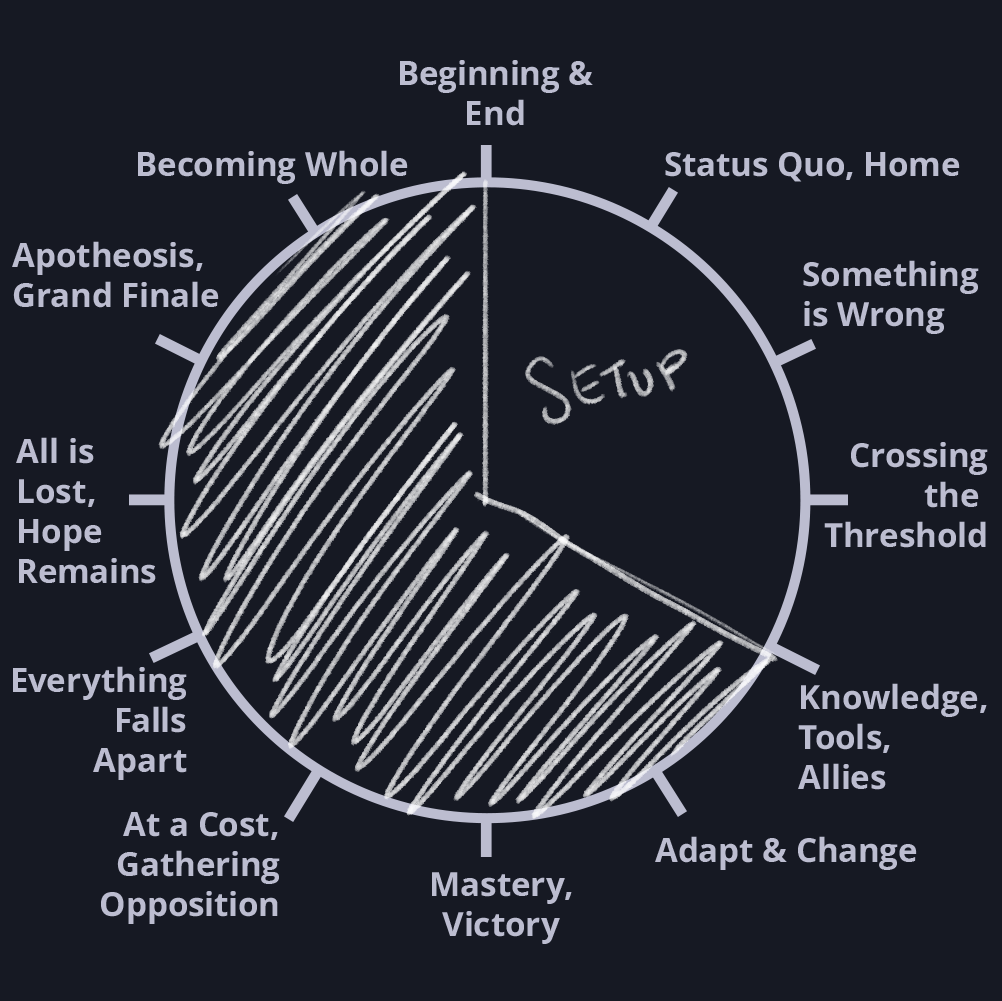
Let's get this story started! The First Act is comprised of our first four story beats:
- a zone of comfort, the mundane real world
- something isn't right, call to action, examining the threshold
- crossing the threshold into the new and exciting
- gaining knowledge, tools, and allies
Before we dig into the individual sections, let's talk about some of our goals in this act.
Genre, Characters, Themes, Arcs, and Promises: The First Act
Genre: What's This All About?
An important thing to do up-front is establish what kind of story this is. Is this a science fiction romance or a hard-boiled detective horror story? All of these details should be readily apparent up-front.
One of the reasons so many stories start in medias res, with an opening scene that takes place in the middle of the plot, OR with a prologue that's evocative of the story but not clearly related to the plot until much later - is because this is a way to tell the audience "this is what you're in for". The tone of your opening should match the tone of the entire project. 1
This is derived from advice from Brandon Sanderson's writing lecture series, and he is a writer in a genre that requires a lot of buy-in, but you're looking at a story fantastical enough that it has an enormously elaborate color-mapped pantheon/magic system so the advice probably also applies here.
But The Wheel Starts with "Status Quo"!
Yeah! Life is a series of infuriating contradictions. It is really hard to establish "this is a kick-ass high-stakes science fiction space opera" with some mundane guy farming space-onions on Planet Snoozefest. We can get to Planet Snoozefest shortly, first we need to do something to draw people in to the genre itself.
If this is a heist story, let's show off some heisting! If this is a comedy romance story, let's start with some comedy and romance.
Characters: Who's This All About?
Conventionally, the first viewpoint character introduced is going to be understood as the protagonist and the main character of the story1.
There's some leeway, I think, if you're doing the prologue thing I mentioned in the last segment, but not much.
Generally: Introduce Characters in the First Act
While each of the characterizations and elements are chosen with the archetype's position in the story circle in mind, it probably wouldn't make a lot of sense for the story to be divided equally into 12 parts, each introducing a new specific character1.
See also: the Dire Warning in the Characterization chapter
Characters might also have traits that make them representative of points in the story cycle, but by and large, as a rule of thumb, most of your characters should already be in place by the first third of the story.
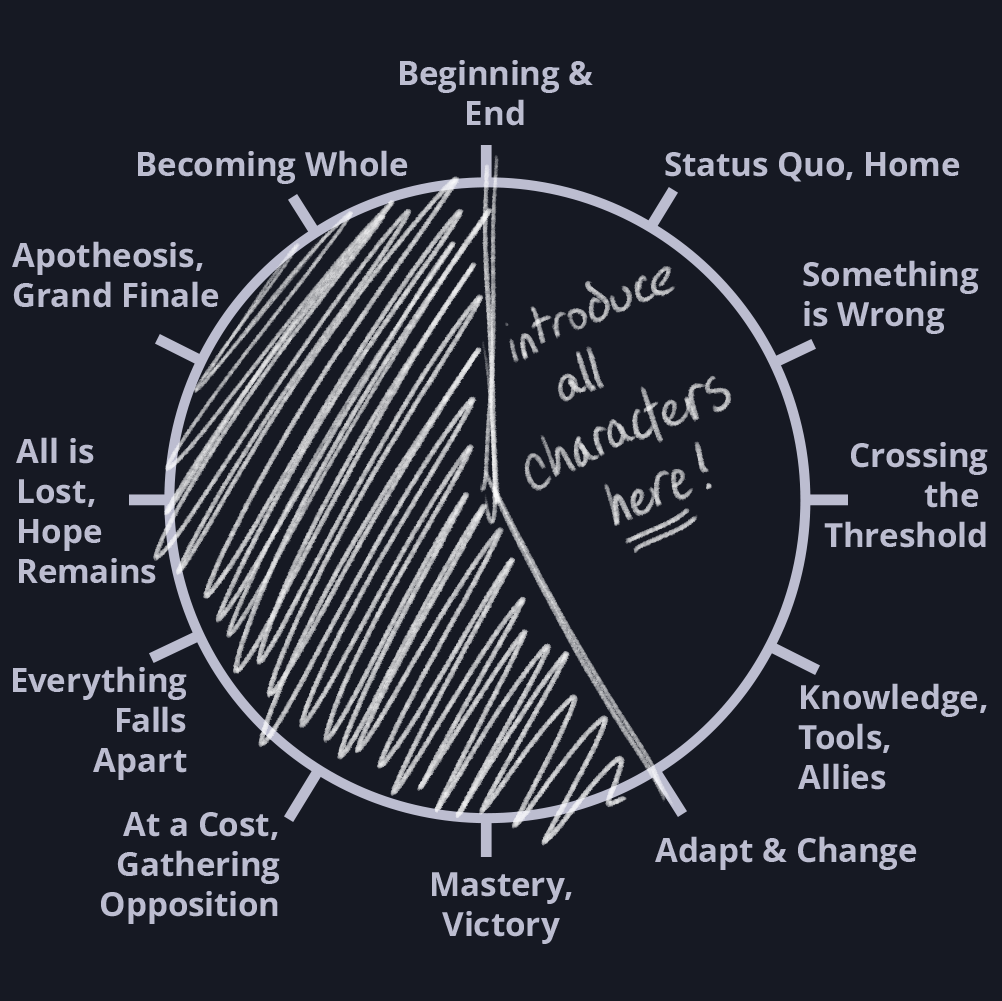
If there are characters who haven't been introduced directly, someone should have at least mentioned their name out loud or alluded to their existence.
Arcs and Promises
Brandon Sanderson, famously one of the more successful fantasy writers alive at time of writing, is fond of his theory that a large portion of the writers' job is to establish and then fulfill promises1.
A "promise" is anything that you set up that the audience will want to see paid off.
A Character Arc is a kind of promise that the author makes to their audience: it establishes a question about a character, and the answer to that question is the pay off that the audience has been promised. The characterization chapter lays out some potential dramatic questions for each character archetype, and if the story starts to ask these questions then it is important to answer them.2
This also leads back to the warning about twists - a sudden surprising, shocking twist doesn't fulfill any kind of promise. On the other hand, if the plot is leaving enigmatic clues all through the story, the promise is that these clues will lead to some kind of satisfying revelation that makes them all make sense. That revelation can come as a shock or twist while also fulfilling the promise made by the enigmatic clues that lead to that revelation.
Even a "genre moment" opener is a kind of promise: it promises that the rest of the work is going to be like this.
This is also advice from Brandon Sanderson's writing lecture series. Strong recommend. He's not a writer who focuses on the story circle as part of his process, not as far as I can tell, and presents a completely different theory of structure that's clearly also very effective.
The answer doesn't have to be happy or positive, but it has to be answered.
Theme: What is this Really All About?
Ultimately, the primary dramatic question faced by the protagonist is the crux of the whole story. If the story is about the main character's coming to terms with the idea that morality and legality are not the same thing then the rest of the story can adapt to better flesh out and illustrate that core theme.
Stories can have more than one theme, or in the case of many pulpy novels, no themes at all except "some exciting stuff is going to happen, hold on to your hat".
When developing characters, an interesting question to ask is: how do they provide a unique viewpoint on one of the story's core themes?
In our example: morality vs. legality - characters who might provide thematic resonance include:
- People who have committed crimes for just or good reasons.
- A genuinely terrible person who commits crimes wantonly.
- A genuinely terrible person who follows the law perfectly and precisely.
- People who have committed crimes of desperation.
- A judge who casually interprets the law in whichever way benefits them the most.
- A lobbyist responsible for greasing the palms of the people who write legislation.
This can be a powerful way to plot a story. Be wary, though: too slavishly adhering to this guideline can leave a story feeling stiff and didactic, like a thinly disguised moral story. It's enough to explore an idea from a lot of different angles: the moment you feel like you're preaching it's time to back off a little bit.
Motivations: What Makes Characters Dynamic?
Nobody likes a lump who just lets the plot happen around them. Ensure characters have things that they want to accomplish and are taking concrete action to make those things happen.
That alone is enough to make a lot of characters interesting - even if an antagonist is kicking puppies left and right, that still constitutes motivation and action and makes them attention grabbing.
0/12. Zariel - beginnings and endings
The "cool genre moment prologue" might live here, in the beginnings bin.
Save the Cat argues that the beginning and ending of a story should be echoes of one another, mirror images reflecting the protagonist in their initial and final state. I think this is advice that has mostly fallen by the wayside in the intervening years but it's an interesting idea.
1. Oth - a zone of comfort, the mundane world
Our protagonist exists in a comfortable-enough position. While their world is... okay, it's small, and unsatisfying in some key ways.
This would be a wonderful time for the protagonist to twirl on a hill and sing an "I Want" song.
2. Cystam - something isn't right, call to action
Something is drawing our protagonist into a new and exciting world - maybe their own motivation, maybe some external force beckoning them.
3. Kiro - crossing the threshold into the new and exciting
There's a firm dividing line between the mundane world the protagonist is leaving behind and this new and exciting world, and they make the decision to break through and enter the new world.
The Old World and the New World
"Wait, what do you mean by new, exciting world?"
So, part of the Hero's Journey, the story cycle, this model in general is that it focuses on going somewhere.
Like, cracking through a wardrobe and popping out in Narnia.
At its very simplest, the story cycle is a tale of our protagonist going to a place, having an adventure, learning a thing, and coming home, having learned something new.
So the "new world" is whatever place our protagonist has to GO to have this adventure.
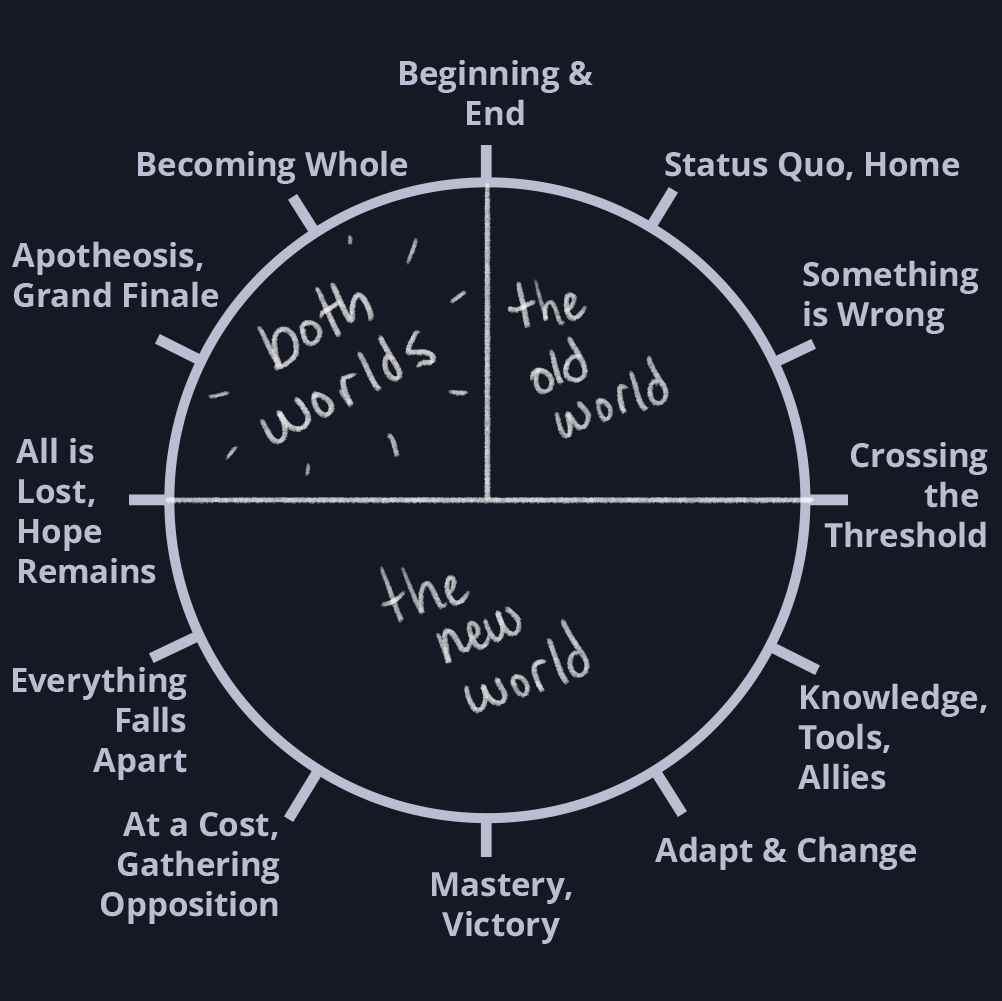
The New World Doesn't Literally Have To Be A Place
A lot of ink has been spilled about this "new world" in story terms. It's the unconscious, it's adventure, it's the thing that our protagonist is tackling.
The thing is, the idea of a "new world" is very flexible. If I wrote a story about my journey to the bank, "the bank" could be the exciting new world, and the threshold might literally be the door to the bank. I'd return... having change.
In magical fantasy stories, the "new world" can be very literal, and the contrast between the old world and the new world can be really stark - Dorothy getting house-dropped into Oz, and the whole black-and-white film erupts into color1.
In more grounded, realistic stories, the "new world" can be as simple as "helping to plan a wedding for my daughter", and crossing the threshold can be "deciding to help to plan a wedding for my daughter"2.
I'm sure in 1939 this was cool as hell. Honestly it's still a really bold and effective stylistic choice, almost a hundred years later.
The movie "Father of the Bride" (1991) didn't make nearly as many bold and effective stylistic choices.
4. Stacks - gaining knowledge, tools, and allies
Freshly in the new world, the protagonist must learn how to succeed in this new environment. We meet friends, gain skills, learn how the new world works.
Beat Shuffling, and The Journey into A Dangerous World
One of the serious problems of any of the story circle ways of exploring and developing a story is that it has a problem: it seems like a one-way ride, chunk chunk chunk, you do the mundane world, you do the call to action, you cross the threshold, there you go.
It's actually a struggle to find media this rote. Even in stories that thoroughly embrace the idea of the Hero's Journey, scenes and structure are a lot more flexible than this. The Matrix starts with a call to action, then moves to an exploration of the mundane world: how dare the Sisters Wachowski play the notes out of order! But it works fine.
The overarching goals of the first act are to have the protagonist choose a dangerous new world, contrast that dangerous new world with their normal existence, give them tools and allies that they can use to succeed, and establish characters, motivations, themes, arcs, and promises for the rest of the story to develop: the exact order of operations here is not as important so long as everything fits together.
Act 2. The Second Third.
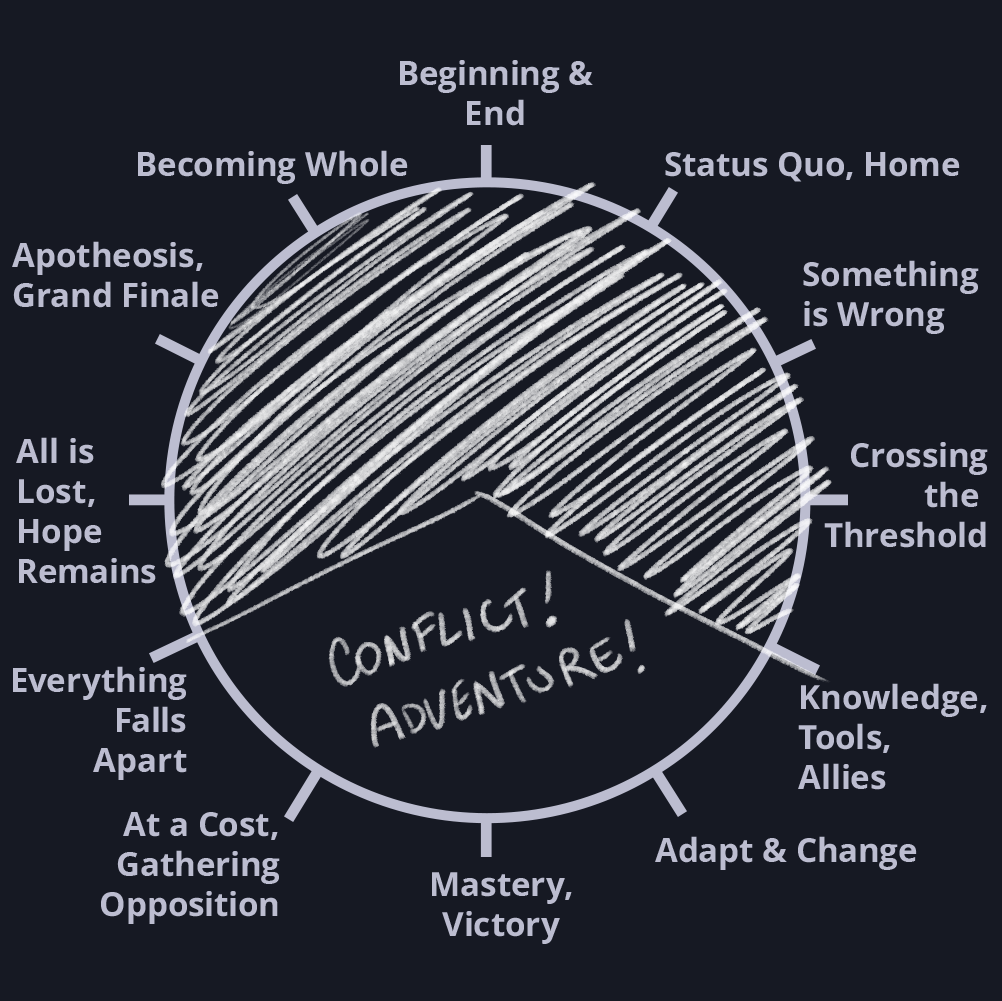
The goals of this act are to really lean into the conflict. The protagonist will try, again and again, to resolve the story, and they will succeed somewhat, but ultimately fail. 1
If the protagonist has a really good second act, panic immediately, you are in a tragic story, things are about to go badly off the rails.
4. Stacks - gaining knowledge, tools, and allies (again)
You know what? I'm going to say something that's going to get me thrown out of all of the stuffiest creative writing circles.1
The "gaining knowledge, tools, and allies" beat can comfortably go pretty much anywhere in Act 1 or Act 2. It belongs to both Act 1 and Act 2.
It's a floating beat. And it can happen multiple times!
Also: a character simply displaying knowledge that they already have is the same as "gaining knowledge" from the perspective of the audience.
It's okay, I don't actually belong to any. All of my friends are software developers. All of them. We mostly talk about the intricacies of board game rule systems and git.
5. Mersenne - adapt to the new world
This new world is confusing and difficult, and our protagonist will start out weak and ineffective, but gradually grow and change to adapt to the new world - while at the same time they might cause the new world to grow and change to adapt to them.
A Nested Calculus of Problem and Solution
Many authors find the middle of a book to be the hardest part. There are so many things that have to be set up in Act 1 that there feels like a lot of structure, but then the middle of our story is this formless goop of "gettin' better, learnin' lessons, solvin' problems" which can feel kind of directionless to write at.
The goal here is something of a cycle: setback, then solution, setback, then solution, as we work our way towards a goal.
There are a few ways I've seen of addressing this: Dan Harmon's story circle theory is simply that each sub-problem encountered is its own, fully-realized microcosm of the whole story cycle.
Brandon Sanderson pitches a theory of opening and closing nested problems, like opening and closing parentheses. This is a very satisfying model for math nerds and programmers. So, let's say we have a problem and a solution:
( We have to get to the castle
We get to the castle )
We can then create a problem, or sub-problems, within that problem:
( We have to get to the castle
(There is a forest in front of the castle
We traverse the forest)
(There is a moat in front of the castle
We construct a bridge to cross the moat)
We get to the castle )
And then we can create sub-problems within those problems:
( We have to get to the castle
(There is a forest in front of the castle
(There is a troll in the forest
(The troll is armed with a whole tree
We light the tree on fire)
We confuse the troll with riddles and escape.)
We traverse the forest)
(There is a moat in front of the castle
(We can't find bridge materials, but there's a shopkeeper who can sell them
(We don't have any money
...
We have money)
We buy the materials from a shopkeeper)
We construct a bridge to cross the moat)
We get to the castle )
So long as we close each problem before we move along, we've at least created a comprehensible and regular narrative.
Goalposts
Another bit of advice I've encountered is that each cycle of setback and solution must visibly move someone closer to a key goal. This is one of the inherently satisfying things about travelling from location to location "we need to get to Mount Doom" plots1: they come with built-in goalposts! The audience can see forward progress, which helps them feel like the story has momentum and direction.
Scott Pilgrim vs. The World and the Mega Man video game series both have one of my favorite invocations of this: just a numbered list of foes that need to be defeated. Defeat the 7 evil ex-boyfriends or defeat the 8 robot masters! That's clear, unambiguous progression! 2
Especially ones that come with a map!
A numbered Carnival of Killers is just straight up fun. If you're ever bored while running a D&D campaign, toss one of these in for instant spice.
6. World - mastering the new world, false victory, the goal achieved
Whereas the previous beat represents a phase of improvisation and adaptation, by the midpoint of the story our protagonist is beginning to feel more competent and in charge of the situation. They've finally figured things out.1
They've become so competent, in fact, that they're able to resolve the original goal that brought them here - and yet, with that goal achieved we're only at the midpoint of the story.
What gives?
Spoiler: no, they have not.
Framing The Character Arc in Terms of Wants & Needs
Often the Character Arc and dramatic question of a character (mentioned above) is framed in terms of the gap between what a character wants and what they need - a character may want to be fabulously wealthy, but need acceptance and community.1 Their "want" forms the goal that they chase and ultimately achieve at the midpoint of the story - their "need" forms the goal that they realize they needed to be chasing and ultimately achieve at the climax of the story.
Tragic stories often do this in reverse: characters get what they need at the midpoint of the story, then abandon it and chase what they want until the end of the story, ultimately leading to their downfall. Often the story's antagonist has this tragic arc, mirroring the hero's more positive arc through the story!
A reframing of this is "the big lie the character believes" - in this case the lie is "I need to be fabulously wealthy to be happy". I think the "want" and "need" framing is clearer and more useful, so I'm dunking the "big lie" here in a footnote. Sorry, K.M. Weiland.
7. Path - the cost of victory becomes apparent, gathering troubles
The universe cannot abide by a protagonist achieving their goals.
Trouble starts to mount, often caused by the friction between the protagonist's wants and needs. Our aforementioned "need to be fabulously wealthy" protagonist may find that their wealth and power actually isolates them, carrying them further away from their needs.
8. Curopal - the twist, betrayal, everything falls apart
Finally, that friction comes to a head and the protagonist's victory turns to dust.
Sometimes this involves an active twist or betrayal, but just as often this can be anything that's been building during the act.
Act 3.

In the third act, our job is to wrap the whole story up.
The Old World and the New World: Why Not Both?
One of the thematic goals of Act 3 is to create some sort of unified perspective between the old world and the new world.
This means that Act 3 can really bounce around between old world and new world.
Threats, too, can extend to both worlds.

8. Curopal - the twist, betrayal, everything falls apart
This sudden reversal of fortune leaves our protagonist in a bad position.
9. Blit - the darkest before the dawn, return to the familiar, a hope spot
Everything is lost. There is no possible route to victory here: our protagonist has lost everything. Anybody would wallow in misery in this situation.
At its very lowest, at the point where the low could not get any lower, often our protagonist has a brush with death itself: they die, or someone around them dies. Sometimes it's even permanent.
But something - something small - gives our protagonist the tiniest shred of hope. They can go on! Maybe it's a clever idea or plan, or the solution to the mystery they've been trying to solve all along.
10. Audient - the grand showdown, climax and apotheosis
This is the big moment. The big swell in the music, angels cheering from on high, a key change into a huge chorus.
In a stunning and dramatic reversal, our protagonist flips the script and comes out on top.
A Repeating Cycle of Death and Rebirth
This is one of the places where the linear nature of the Story Cycle struggles the most: many stories will take a couple of swings at the climax.
After what seems like the grand showdown and climax, we get another twist where everything falls apart!
This means that steps 8 through 10 might repeat a couple of times, hitting lower lows and higher highs each time:
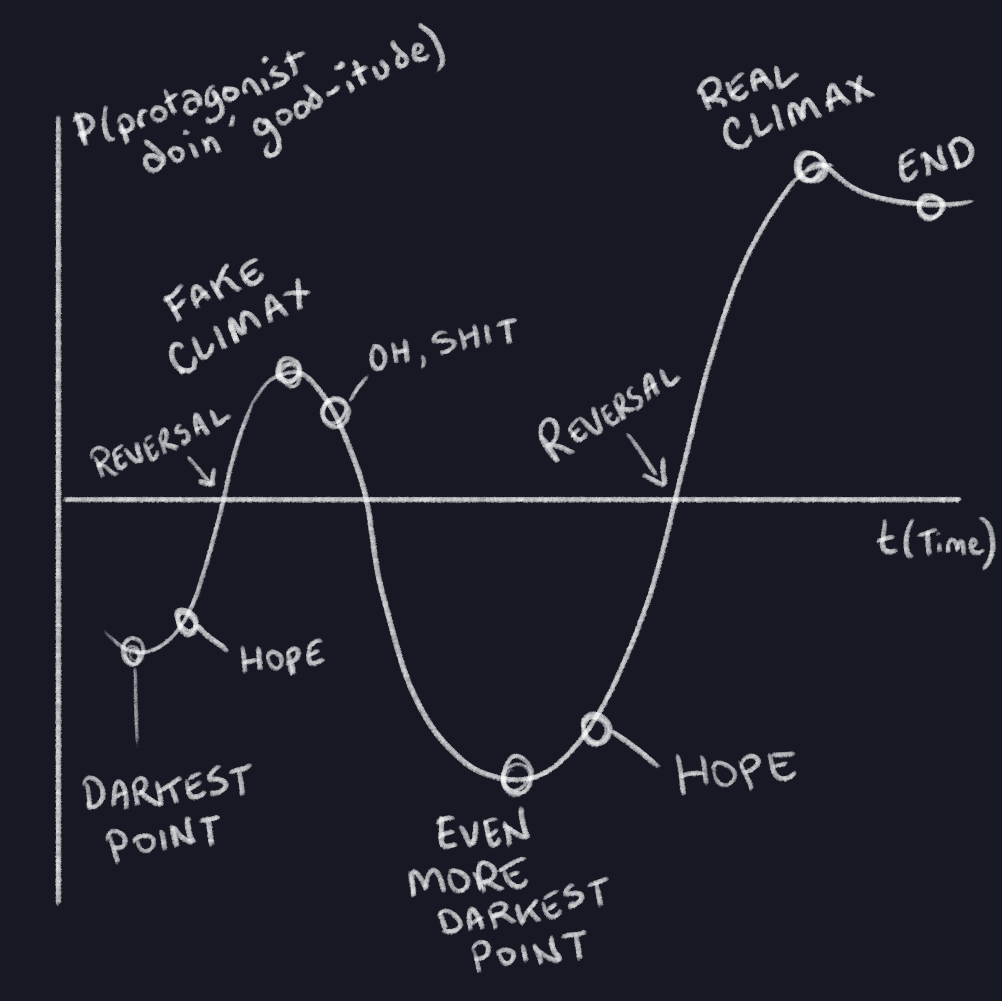
11. Misk - master of both worlds, returning and becoming whole
Denouement. Wrap up.
If our protagonist finally reconciled their character arc - they found what they need rather than chasing what they want - now would be a great time to show them happy in a new, better status quo, the implication being that this one is going to be more permanent.
If their arc resolved tragically - they chased what they wanted and lost everything in the climax - now we focus on them miserable in a new status quo.1
If the protagonist didn't resolve their arc at all, what have you been doing all this time?
There's a bit of pleasing schadenfreude to watching the villain's miserable new status quo, if they survived.
Brick Joke
This is also a great time to wrap up any inconsequential loose threads. I'm enormously fond of stories that set up a Brick Joke early on in the plot and don't pay it off until the denouement, after the events of the whole story.
As a kind of hackneyed example of this, imagine our protagonists accidentally just ruining someone's bathtub in the course of their adventure. By the end of the adventure, the audience will mostly have forgotten the tub, but as a very final scene having the tub's owner encounter the mess: "Sacré bleu! My bathtub is ruined!"
I'm a simple man, I'm pretty sure that's funny.
12. Zariel - Beginning & End
The story is complete, at this point.
Once this story ends, another story will begin, the loop will continue, the wheel will keep turning.
Zariel is the context surrounding the story, the eternal loop of the story cycle.
This element isn't so much in the story as it is around the story.
How is the story framed? Who is the viewpoint character? Is the story first-person ("I went to the store"), third-person omniscient ("Ted went to the store"), the wildly rare second-person ("You went to the store"), or even the as-yet undiscovered fourth person ("A character representing all Teds across all universes went to every store, past, present, and future").
Is there a narrator? Is the narrator reliable? Is the narrator aware that this is a story?
This can mean "sequel hooks" - okay, the story is complete. What happens next?
Does this tie into a larger story?
This is particularly relevant in a sitcom-style model where the whole universe literally has to reset after most episodes, because episodes are written out of order by different people and all depend on the same shared universe.
A Dire Warning
As a reiteration of the dire warning in the characterization chapter, you might notice that each of the 12 spokes of the story wheel line up pretty well with the 12 characters described in the previous chapter.1
This is intended to be loose and evocative, however, not formulaic and prescriptive.
For example, Kiro, the sunny, optimistic archetype? Very easy to get to cross the threshold. Good choice to help someone else get across the threshold. If your story is struggling in this area, a Kiro might help. That doesn't mean you need to use all twelve characters.
In fact, that warning goes for the story cycle at large. It's also intended to be loose and evocative rather than formulaic and prescriptive. If you find yourself trying to hit a checklist of beats required by a formula, your writing is going to come out mechanical and soulless.2
I very badly hope you notice this.
like mine does
Case Study: The Matrix
The Matrix can be used to illustrate some elements of the story cycle.
the genre-establishing in-medias-res cool action scene to establish genre and tone:
This isn't part of the cycle, but it is something I mentioned in the story cycle chapter as a good idea for genre fiction.
Trinity is almost caught by some cops. Instead of being caught by said cops, Trinity easily defeats them with weird magic hacker kung-fu. Agents are established as bad, scary, and at least as dangerous as Trinity. Trinity escapes, through a public pay-phone, at the last minute1.
This scene is not part of the plot of the film, not really:
It's here to make the genre promise: action, guns, weird magic hacker kung-fu.
It's established early and often in the world of The Matrix that hackers can travel over land-lines, which the AI could have quite easily foiled by simply choosing to set the simulation 20 years later or 100 years earlier, at which point the hacker's access to land-lines would become a serious structural issue.
a zone of comfort, the mundane world
Thomas Andersen (Neo) is a shlub in a dirty apartment selling... I don't know, some kind of diskette drugs2 to a gang led by a guy with a suspiciously low-cut shirt.
Thomas's smug boss, an officious character who's name I had to look up in order to learn what it was3, chews him out for showing up late to work.
I knew it, they're shonking T-Nubs.
"Mr. Rheinhart"
something isn't right, call to action
Following a hint left by his computer, Thomas follows the diskette gang to a sexy underground industrial music club where Trinity warns Thomas that he's in danger. 4
Later, at work, a phone arrives by mail and Thomas follows the instructions of Morpheus, a mysterious voice who warns Thomas that Agents are coming for him. Thomas attempts to run from the Agents but chickens out and is caught.
The agents attempt to flip Thomas to capture Morpheus. He refuses. The agents do some spooky belly button bug stuff to Thomas and show off some of their spooky goon powers. Was it just a dream?
Thomas meets up with Trinity and some hacker goons, who threaten him and ask him to follow. He refuses briefly but returns at Trinity's insistence.5
Hacker team extracts the Agents' bug from Thomas. It wasn't a dream! Creepy! Also it was easily the size of a pretty large light bulb so I don't know how Thomas missed it. 6
This is intertwined with the events of the first beat, above: that's right, the beats don't necessarily even have to happen one after the other in strict chronological order!
In the Hero's Journey Classic, the formula that this movie adheres to quite closely, this would be the refusal of the call. Honestly, this refusal feels almost perfunctory, like it's just included to check the "refusal of the call" checkbox.
In a DVD extra deleted scene, we see the version of the scene left on the cutting room floor where the rather hefty device was extracted from Thomas Andersen's b-hole rather than his belly button. It's still available, on YouTube, here.
crossing the threshold into the new and exciting
Thomas meets Morpheus, who explains that in order for Thomas to understand the mysteries of The Matrix, he'll need to make a choice: take a specific colored pill7.
After taking the pill, Thomas is dragged into the "real world", a science-fiction dystopia. The music swells and chorus of people go "waaaaaaaaa", then Thomas gets flushed down a science fiction toilet, where he is claw-game collected by the Nebuchadnezzar, the floating airship of the science-fiction dystopia resistance8.
Some very internet communities have adopted the red pill as a metaphor for "going down the rabbit hole" and learning whatever they think the spooky truth behind the world is, and that spooky truth is usually something like "actually women are terrible" or "congress is harvesting the blood of children in satanic orgies", so it's pretty safe to say that fans of the Matrix are not doin' so hot.
It's never explored in the movie, but in The Animatrix we get a short film explaining Tank's absolutely insane claw-game skills in a short where he spends hours in the Matrix winning stuffed animals in a small arcade. It can be found on YouTube, here.
gaining knowledge, tools, and allies
Neo (Thomas) gets to know his crewmates. Morpheus explains to him that the world Neo knew was just a simulation, and computers are using humans as a power source according to some extremely shaky science.
The crewmembers allude to Neo's importance and upload a whole whack of magic hacker kung-fu directly into his brain.
The rules of the world are laid down in detail: what are the stakes? What is the matrix? Who are agents?
We get some humanizing moments with the rest of the cast.
Our betrayer, Cypher, establishes that he's working against the team in a scene where he offers to betray everyone in exchange for his own re-establishment in the Matrix. (This is a set-up for the later betrayal twist)
adapt to the new world
At first, in a kung fu test with Morpheus, Morpheus wins, but Neo is learning quickly and manages to almost best Morpheus, the first sign of adaptation.
Neo joins the crew on a mission, their journey to an Oracle to find out if Neo is really "The One" who can save them all.
Here's where the Matrix case study starts to come off of the rails a little bit: this movie doesn't give Neo much of a chance to show off his growing mastery of his new understanding of The Matrix: he gets one solid kung-fu scene with Morpheus and then we're off to the movie's midpoint. That's right, we're just skipping a beat. Don't worry, that's okay.
mastering the new world, false victory, the goal achieved
The ultimate goal of the entire first half of The Matrix is to get Neo to The Oracle so that he can be anointed as The One.
And here, finally, Neo is brought back in to the Matrix and makes it to the Oracle.
... Honestly, very easily. Suspiciously so. We're only at the midpoint.
the cost becomes apparent, gathering troubles
Wuh-oh. The Oracle explains to Neo that he is not, in fact, The One, and this whole plot has just been a big mistake. Morpheus had better keep looking.
Worse still, the cost of this journey? An ambush by the Agents.
Morpheus is captured!
the twist, betrayal, everything falls apart
Cypher's betrayal is revealed! He kills off just about everyone in the cast except for Trinity, Morpheus, Tank, and Neo, then dies.
the darkest before the dawn, return to the familiar, a hope spot
Everyone but Morpheus escapes the Matrix, and they plan to pull the plug on Morpheus: he has secrets that are too valuable to lose to the Agents.
With everyone lost, Neo plans to risk everything to save Morpheus.
Morpheus is tortured by Agents.
To add extra pressure, the Nebuchadnezzar itself is under attack and can't defend itself until everyone is out of The Matrix.
the grand showdown, climax and apotheosis
Big cool action sceen. Neo and Trinity are big damn heroes.
Neo almost manages to take down an Agent. Whoa. Then Trinity manages to take down that Agent, by surprise: probably our first confirmed Agent kill in history.
Morpheus escapes with the team. Moments away from victory, everybody makes it out of the Matrix...
the even darkest-er before the even dawn-er, return to the familiar, a hope spot
...except for Neo.
Whoa there, we went back a step! This is another darkest-before-the-dawn moment!
That's right! There's nothing in the rules that says we can't do story beats again if it's effective!
Neo is forced into a final confontation with an Agent, who kills him. Neo is just straight-up dead.
The Nebuchadnezzar has almost been completely disassembled by team evil AI's nasty robots.
Dang. Game over. Humans lose.
the grand showdown, climax and apotheosis
With a kiss and a declaration of love from Trinity9, Neo is reborn. As The One. He easily, casually dispatches an Agent.
Weakly supported by the plot, it's established early and often that Trinity likes Neo, but the on-screen chemistry between the two actors is essentially nil. Nevertheless, the prospect of a smooch from a pleather-clad Carrie-Anne Moss would have brought me back from the dead in 1999, so I can't judge too harshly.
master of both worlds, returning and becoming whole
Everyone escapes The Matrix just in time.
An epilogue: Neo returns to the Matrix to be hacker kung-fu Jesus, delivering a speech then flying into the sky.
Really Wedged it In There
With a hopelessly jumbled together "zone of comfort" and "call to action", an essentially missing "adapt to the new world", and not one but two climactic endings one after the other, you'd think that this isn't an ideal example of the story beats in action.
But here's the thing: the template isn't prescriptive, or a formula. Mixing, skipping, repeating, rearranging story beats? All of that is totally allowed!
Case Study: Zootopia
Zootopia can also be used to illustrate some elements of the story cycle.
the genre-establishing in-medias-res cool action scene to establish genre and tone:
A dangerous savannah! Animals fighting! Predators and prey!
a zone of comfort, the mundane world
"Blood! Blood! And... death." Judy, our protagonist, humorously hams up a fake death scene, as part of an elementary school play explaining the rules of this universe.
Animals is people now. Predators and prey are at peace!
We're in Bunnyburrow, a small carrot farming town way off in the corner of nowhere, and we meet Judy Hopps, our main character.
something isn't right, call to action
Judy wants, more than anything else, to be a police officer.
Judy's parents remind her that that is dangerous, and a terrible idea.
She protects some of her classmates from a bully who reminds her of the predator/prey divide, developing Judy's fantastic racism.
Despite being smaller than the rest of the police force, Judy eventually excels with the sheer power of her force of will and graduates police academy as the valedictorian.
We meet Mayor Lionheart and Deputy Mayor Bellwether.
crossing the threshold into the new and exciting
Judy takes the train into the huge metropolis of Zootopia.
gaining knowledge, tools, and allies
Joining the police force, Judy is assigned to parking duty, which quickly turns out to be a depressing and demeaning chore.
She gets hustled by Nick, a fox who is also a local con-man.
Butting her nose in to a missing persons case through sheer stubbornness, Judy manages to get the hard-nosed Chief to let her try to solve the case, by putting her career on the line and agreeing to an insanely short deadline.1
Realizing that Nick was near the initial scene of the crime, and with nobody else to help, Judy recruits him to help with the case.
this is a bad career move, do not do this.
adapt to the new world
Judy and Nick chase the details of the case, getting to have a short adventure in some of the exciting biomes teased by earlier shots of Zootopia.
Something is causing predators to go feral and attack people!
Oops, they become friends. Nick reveals his characters' dark secret, he's a distant conman because of fantastic racism.
Chasing the thread to its conclusion, they find a secret lab where Mayor Lionheart has been holding feral predators. He's at least responsible for the missing persons!
mastering the new world, false victory, the goal achieved
Mayor Lionheart is arrested, Judy is commended as a full-fledged police officer. Nick even considers joining the police.
the cost becomes apparent, gathering troubles
In a press conference about the events, Judy is a little bit too blase about the problem being predators' bloodthirsty nature, disgusting Nick, who points out Judy's own fantastic racism then leaves.
Whoops, it turns out the fear of predators "going feral" has unlocked a wild new level of fantastic racism in Zootopia. Predators become second-class citizens.
the darkest before the dawn, return to the familiar, a hope spot
Depressed by her negative impact, Judy quits the force and returns home to sell fruit and vegetables.
While manning the family fruit stand, her childhood bully returns and apologizes to her, accidentally revealing a key detail: local plants are a toxin that cause madness!
This is a vital clue! Judy, excited, rushes back to the city to save the day!
Judy must re-enlist Nick to help her. She apologizes. Nick decides to help.
the grand showdown, climax and apotheosis
They demonstrate their mastery of the new world very quickly: having navigated this case once, they're both confident and effective right away. Throwaway joke characters from the earlier investigation get some more screen time.
They very quickly discover a secret lab where the plant is converted into a toxin that can be fired as a paint-gun dart. Someone has been paying the lab techs to target predators!
This re-contextualizes so much stuff about the plot!
Action happens, Nick and Judy barely escape the secret lab with the evidence that they need to save the day!
the twist, betrayal, everything falls apart
Deputy Mayor Bellwether is (inexplicably) here to help, so long as Judy hands her the evidence.
Judy, suspicious, runs. Bellwether, the ringleader all along, orders her execution.
After a short chase, Nick and Judy end up together in a pit.
Bellwether delivers a villain monologue, explaining her plan to use fantastic racism as a ladder to political power, and shoots Nick with the serum.
the darkest before the dawn, return to the familiar, a hope spot
Nick, crazed by the serum, kills Judy.
the grand showdown, climax and apotheosis
"Blood! Blood! And... death." Judy humorously hams up a fake death scene.
The serum was actually blueberries. The death scene was faked to record Deputy Mayor Bellwether's villainous monologue.
master of both worlds, returning and becoming whole
Bellwether is arrested. Nick joins the police. Nick and Judy get to cruise around in an unnecessarily militaristic police cruiser, credits roll.
Elements & Game Mechanics
Okay, not just 12 elements, here - but 24! That's right - between every two spokes we can fit a little extra element.
The inner elements can be, of course, cleanly removed if 12 is enough elements.
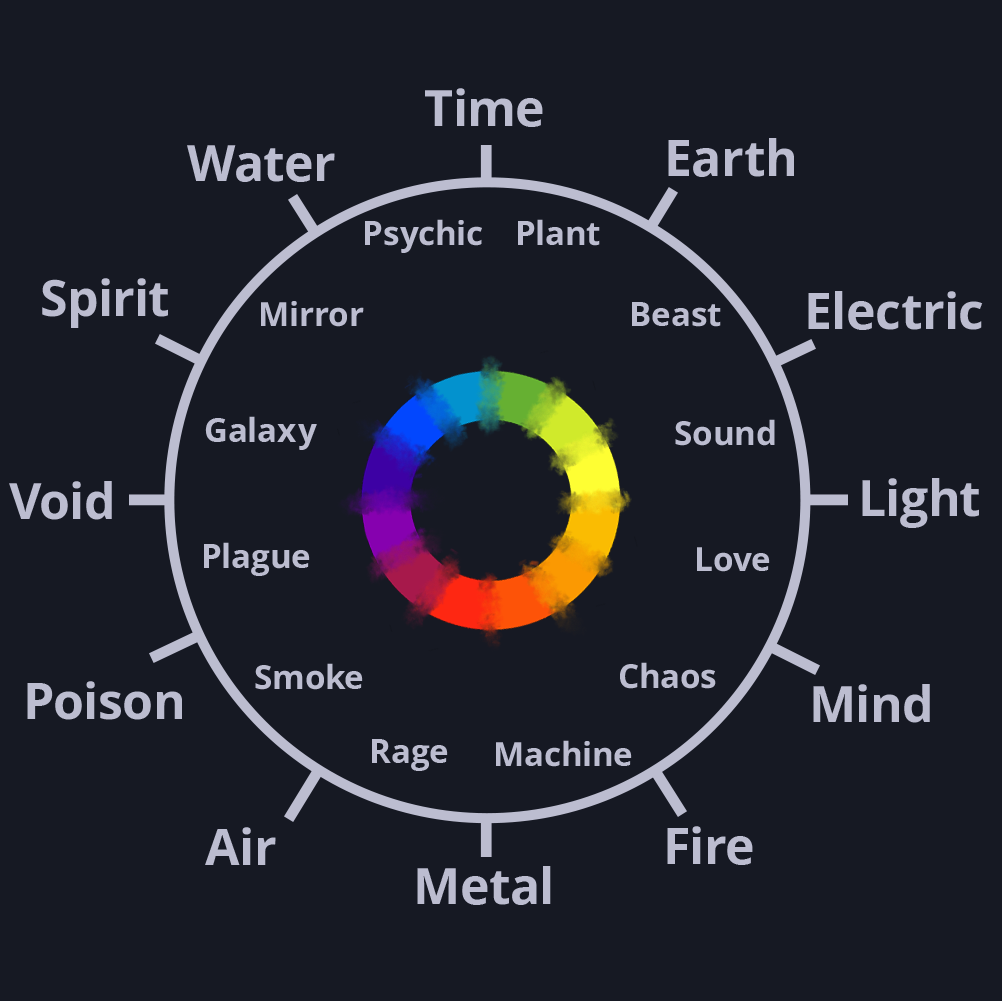
Quick Summary
| archetype | element | themes & gameplay elements |
|---|---|---|
| oth | earth | slow, steady, strong, blocking |
| beast | raw, sacrifice, numerous | |
| cystam | electric | speed, risk, chaining |
| sound | helping, quick buffs, area of effect | |
| kiro | light | strong start, weak finish, help a little |
| love | pairs, long-lasting buffs | |
| stacks | mind | planning, searching, indexing |
| chaos | a lack of intentional strategy | |
| mersenne | fire | high-risk high-reward, random |
| machine | a better copy with obvious downsides | |
| world | metal | powerful, durable, forged |
| rage | aggression, add and remove things from battle | |
| path | air | low damage, dodge, flight, shuffle |
| smoke | choking, obscuring, disabling, area of effect | |
| curopal | poison | insta-kill, repetitive damage, patience |
| plague | contact growth, incubate, spreading, viral | |
| blit | void | nothing, removal, cancel, game-ending |
| galaxy | huge, create, pull & push | |
| audient | spirit | laws, complexity, exponential scaling |
| mirror | clones, duplicates, reversal | |
| misk | water | reconfigurable, ok at everything, healing |
| psychic | weird, occult, control, puppet | |
| zariel | time | loops, repetition, rewind, remove |
| plant | natural, slow, healing |
Outer & Inner Elementals
The outer elements (example: air, void, metal) are a little more direct, simple and fundamental, whereas the inner elements (example: sound, mirror, psychic) tend towards being a little more complicated, specialized, and abstract.
One way to add a little bit of verve to each archetype in the pantheon would be to give them elemental associations to the outer element on their spoke, as well as both of the nearby inner elemental associations.
- Oth would be Earth, Plant & Beast.
- Cystam would be Electric, Beast & Sound.
- Kiro would be Light, Sound & Love.
- Stacks would be Mind, Love & Chaos.
- Mersenne would be Fire, Chaos & Machine.
- World would be Metal, Machine & Rage.
- Path would be Air, Rage & Smoke.
- Curopal would be Poison, Smoke & Plague.
- Blit would be Void, Plague & Galaxy.
- Audient would be Spirit, Galaxy & Mirror.
- Misk would be Water, Mirror & Psychic.
- Zariel would be Time, Psychic & Plant.
Oppositions
- Earth and Air
- Electric and Poison
- Light and Void
- Mind and Spirit
- Fire and Water
- Time and Metal
Enumerating the specific qualities that define these oppositions will remain an exercise for the reader.
The oppositions on the inner elements are more defined by their relationships between outer elements than by their oppositions with one another.
- Plant and Rage
- Beast and Smoke
- Sound and Plague
- Love and Galaxy
- Chaos and Mirror
- Machine and Psychic
Each of these pairs feel not like parallel concepts: but orthogonal ones. No matter how hard you rage at a plant, or love at the galaxy, or shout at a virus - nothing will happen.
Combinations
It's also possible to concoct groupings for other thematic purposes:
- Storm could be Electric, Air, and Water
- Healer could be Water, Plant & Love.
- Magician could be Smoke & Mirror.
- Demagogue could be Electric, Sound & Psychic.
- Foxglove could be Plant & Poison.
These are fun to concoct and there are too many possibilities to enumerate.
Magic Systems & Cost
One thing to consider when designing magic systems for narrative purposes is that one way to make magic more interesting is to give it some kind of a cost.
I think the first author I saw pitching this idea was Orson Scott Card, but I've seen Brandon Sanderson bring it up it as well.1
From a horrifyingly practical standpoint, 'unlimited magic' characters are a source of infinite energy and should simply turn a crank as fast as possible, all the time.
attributing an idea to the first person I heard it from isn't necessarily accurate but it at least seems fair.
Let's Look At Each Element More Closely
Earth
Earth: rock and dirt, mountain and ground.
Earth effects generally:
- Take a long time to develop.
- Are hard to get rid of.
- Are defensive in nature.
- Block or reduce damage.
- Are themed around "rock", "mountain", "stone".
Beast
Between Earth and Electric, beast represents the animal and insect kingdom.
Beast effects generally:
- Come in a great number.
- Multiply.
- Sacrifice weaker creatures to build up stronger creatures.
- Are themed around "blood", "claws", "teeth".
Electric
Lightning! Thunder! A whole mess of electrons moving from place to place!
Electric effects generally:
- Take a while to build up, then happen instantly.
- Chain, jumping from target to target to target.
- Follow predictable rules to arrive at unpredictable outcomes.
- Are themed around "lightning".
Sound
Big sound! Much noise!
Sound effects generally:
- Have a wide area-of-effect.
- Can bolster the courage of friends.
- Can confuse or distract enemies.
- Provide buffs and debuffs1.
- Are themed around "thunder", "music".
if you're not familiar with the terms, "buff" is an upgrade, a buff might make someone stronger, or faster - correspondingly, a "debuff" is a downgrade, that might make someone weaker, or slower.
Light
Sunlight! Hope, optimism!
Light effects generally:
- Start very strong, but lose steam quickly.
- Provide very small or inconsequential buffs.
- Provide a lot of utility in dark environments.
- Are themed around "the sun", "day".
Love
LURVE. Passion. Charm.
Love effects generally:
- Link things together as pairs.
- Provide long-lasting, resilient buffs.
- Slowly turn enemies into long-lasting friends.
- Are themed around "hearts", "kisses", "kindness", "friendship", "courage".
Mind
Think carefully, know things, be insightful. Plan.
Mind effects generally:
- Allow for searching or indexing through abilities1.
- Provide insight on or identify enemy weaknesses.
- Prepare effects that take some time to trigger.
- Prepare traps that may be triggered.
- Are themed around "planning", "libraries", "traps", "plots".
as a collectible card game enjoyer, these seem inconsequential to newer players but often are some of the most powerful cards in the pool.
Chaos
Randomness! Nobody can predict these effects! Well, that's not entirely true: the tools of probability theory can rein in the possibility space somewhat. Dice are random, but they're not unknowable.
- Randomly determined outcomes.
- Effects that may or may not trigger.
- Effects that can't obey any particular strategy, like playing high-stakes poker with your cards face down on the table.
- Themed around "casino", "dice", "chaos".
Fire
Flames! Hot! It burn! Burn be good! 1
Fire effects generally:
- Are unpredictable and destructive.
- Spread easily and maliciously.
- Are high-risk but high-reward.
- Are not fussy about who they hurt.
- Provide a lot of utility in dark environments.
- Are... fire themed.
I didn't imagine when I took on this project that I'd set myself up for a task as rudimentary as trying to write copy to explain "fire" to people. I'm pretty sure people don't need flavor text for fire.
Machine
Clever engineering, combustion, horsepower, human ingenuity.
Machine effects generally:
- Mimic effects that other elements have access to:
- faster, stronger, or more repeatable,
- at much higher cost or with much less resilience.
- Have repetitive, ongoing costs.
- Are themed around "contraptions", "rube goldberg machines", "engines".
Metal
Steel, silver, bronze, gold, metal is here to save the day!
Metal effects generally:
- Provide uncomplicated defensive and offensive options.
- Can be made stronger up-front with more time, expense, or rare materials.
- Rust and degrade over time.
- Are themed around "swords", "shields", "armor", "steel", "currency".
Rage
Big negative emotions! Hate! Fear! Rage! Rraaaaaah!
Rage effects generally:
- Provide long-lasting debuffs.
- Trigger aggression and attacks.
- Can cause parties to enter or leave battle.
- Are themed around "fear", "hatred", "division", "nationalism".
Air
Light, free, hard to see. We need it to live.
Air effects generally:
- Provide dodge: prevent attacks from hitting without blocking them.
- Less damage than Fire or Water, but can still be used offensively.
- Flight! Get up, get on up!
- Shuffle, move, or redistribute things.
- Create breathable bubbles in unbreathable locations like "underwater" or "in space".
- Are themed around "motion", "storms", "wind", "twisters"
Smoke
Air gone terribly wrong, thick with particulate and toxic to life.
Smoke effects generally:
- Obscure or hide things.
- Temporarily disrupt the battlefield.
- Temporarily disable strong opponents.
- Quickly kill or disable weak opponents.
- Enjoy an enormous area of effect.
- Are super-effective in confined spaces.
- Are themed around "smoke", "toxins", "pollution", "choking", "asphyxiation".
Poison
Immediately, drastically, deadly effects. Sudden sabotage.
Poison effects generally:
- Take time to set up, then do very high, very targeted damage.
- Do low but repetitive damage over a long period of time.
- Are themed around "poison", "betrayal", "daggers", "assassins", "arsenic".
Note:
With Curopal positioned right at the nexus of Poison, Smoke, and Plague, that also gives them a real compelling pitch for "medicine" or medical-related effects, the "good" side of poison and plague.
Plague
A coughing, hacking, microorganism-based assault on the living.
Plague effects generally:
- Spread, but only in close quarters.
- Are difficult to contain.
- Damage things for a long time without killing them.
- Turn things into plague-spreaders.
- Incubate.
- Bypass traditional defenses.
- Are themed around "virus", "pestilence", "disease", "pustules", "goop", "decay", "rot".
Void
Hollow, dark, nihilistic, empty.
Void effects generally:
- Cause things not to exist, remove things.
- Provide debuffs.
- Cancel effects: a thing that would have happened, instead, doesn't.
- Set up effects that threaten to end the game if left unchecked.
- Are themed around "shadow", "void", "absence", "nothingness", "sadness", "emptiness".
Galaxy
The universe and everything. Distant, unfathomable, and yet the only true force of creation.
Galaxy effects generally:
- Are huge. HUGE. Effects that are orders of magnitude bigger than any other.
- Create. Galaxy can create something from nothing in a way that no other element can.
- Pull and push things around.
- Are themed around "space", "creativity", "genesis", "art", "gravity", "stars", "moons".
Spirit
Some things may not exist, but we cause them to (sort of) exist through the sheer force of believing in them, ideas like "honor" or "Canada".
Spirit effects generally:
- Create and enforce laws, like "no Void effects can be played on even turns".
- Make big, fundamental changes to the rules of the game.
- Come with difficult to grasp mechanics that pay off with careful study.
- Have endurance: Spirit effects are hard to shake.
- Are very weak initially, but scale exponentially in the late game.
- Are themed around "belief", "conceptual shifts", "faith", "truths".
Mirror
Reflect. Copy. Clone. Duplicate.
Mirror effects generally:
- Create exact duplicates of other things.
- Reverse, invert, and create large shifts in position.
- Provide counterattacks!1
- Are themed around "mirrors".
"Perfectly symmetrical violence never solved anything."
Water
Water your thoughts on this?
Water effects generally:
- Are flexible, adaptable, can provide a bit of everything - offense, defense, utility.
- Are "Judo" inspired - redirecting an opponents' energy to flip them on their backs.
- Heal! Water and Plant are the only elements that can easily provide healing.
- Are rapidly reconfigurable.
- Are themed around "water", "ice", "healing", "pure", "fluid".
Psychic
Think oppressively. Reach into opponents' minds. Predict the future.
Psychic effects generally:
- Look ahead in time.
- Force opponents to reveal things, or make specific moves.
- Quickly turn enemies into unwilling puppets.1
- Can create enemy weaknesses.
- Are themed around "occult", "mental dominance", "oppressive thought"
While Love might take some set-up to create a permanent ally, Psychic might provide very short term "charm" effects that are easy to shake off.
Time
Cycles, inevitability.
Time effects generally:
- Look ahead or backwards in time.
- Prevent things from having ever happened, retroactively.
- Rewind damage (like "healing" but it has to happen right away).
- Replay events that went badly.
- Make a prediction, then get a large reward if that prediction comes to pass.
- Repetition. Try (or do) something again, and again, and again, and again.
- Themed around "clocks", "cycles", "loops".
Plant
Vegetation & nature. Slow-moving.
Plant effects generally:
- Grow, taking things and making them stronger gradually.
- Heal. Water and Plant are the only elements that can easily provide healing.
- Entangle & thorn, preventing movement and dealing minor damage.
- Reward patience.
- Provide bountiful harvests (a lot of little buffs and heals that can be passed out).
- Are themed around "trees", "harvest", "green spaces", "gardening", "fruit & vegetables"
Thematic Symbols
Each of the twelve are associated with specific thematic symbols!
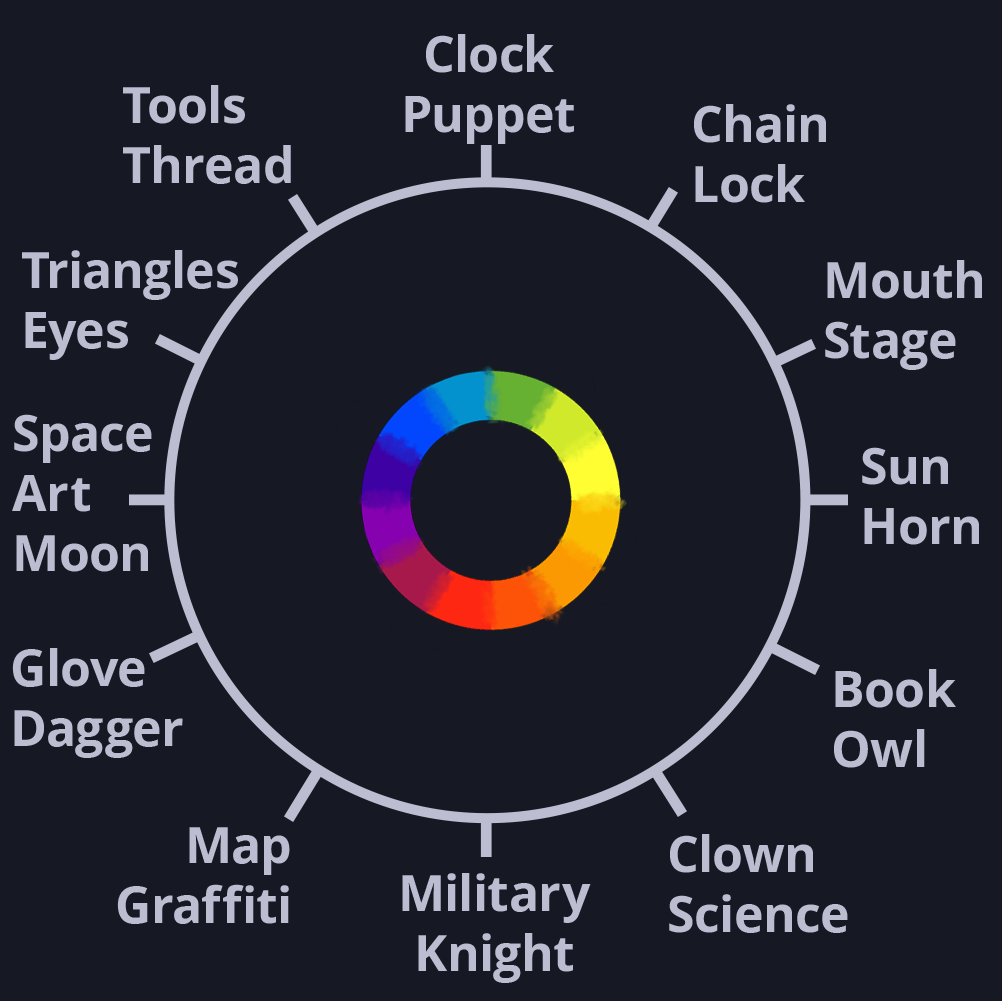
- Oth is thematically linked to chains and locks, and symbols of jurisprudence: scales, handcuffs.
- Cystam is thematically linked to mouths, the stage, and symbols of journalism: the microphone, the satellite, the camera, the pen.
- Kiro is thematically linked to the sun, brass horns, and lanterns.
- Stacks is thematically linked to symbols from academia: books, owls, candles, globes, mortarboards, protractors, microscopes, lightbulbs.
- Mersenne is thematically linked to clowns and symbols from mad science1: goggles, lab coats, beakers, mutations, brain-jars, test-tubes.
- World is thematically linked to symbols of military might and fascism: knights, cannons, plumed helmets, badges, eagles, lions, chevrons, stars, stripes.
- Path is thematically linked to symbols of travel and anarchy: maps, graffiti tags, raised fists, backpacks, luggage, vacations, sandals.
- Curopal is thematically linked to gloves, masks, daggers, and snakes.
- Blit is thematically linked to space, darkness, galaxies, the moon, paintbrushes, palettes, art.
- Audient is thematically linked to eyes, pyramids, and complex geometric patterns.
- Misk is thematically linked to needle and thread, and tools: hammers, toolboxes, wrenches, screwdrivers, cogs.
- Zariel is thematically linked to clocks, clockwork, puppets, time, hourglasses, loops, cycles, ouroborous.
You can use as many or as few of these symbols as you like!
"Science" could fit into either Stacks or Mersenne - but Stacks would fit more symbols of real, academic science - books, papers, chalkboards, cardigans, whereas Mersenne fits more the archetype of mad science - the crazy hair, biohazard, mutated rat kinda science.
Color & Glyph
This is a very short chapter. Each Groovelet archetype is associated with a color!
Color
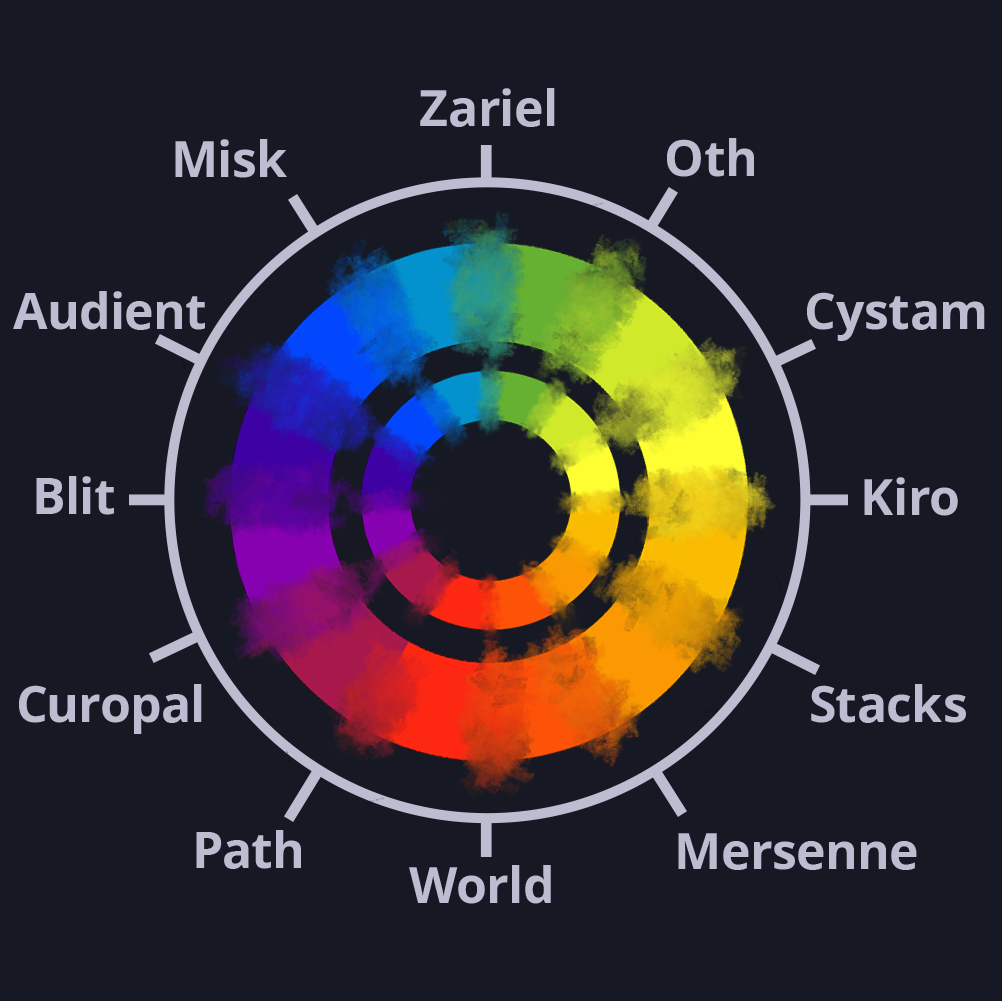
- Zariel: Teal
- Oth: Green
- Cystam: Chartreuse
- Kiro: Golden Yellow
- Stacks: Peach
- Mersenne: Pumpkin Orange
- World: Scarlet Red
- Path: Maroon
- Curopal: Fuchsia
- Blit: Dark Purple
- Audient: Royal Blue
- Misk: Sea Blue
Glyph
Each archetype also has an associated glyph.
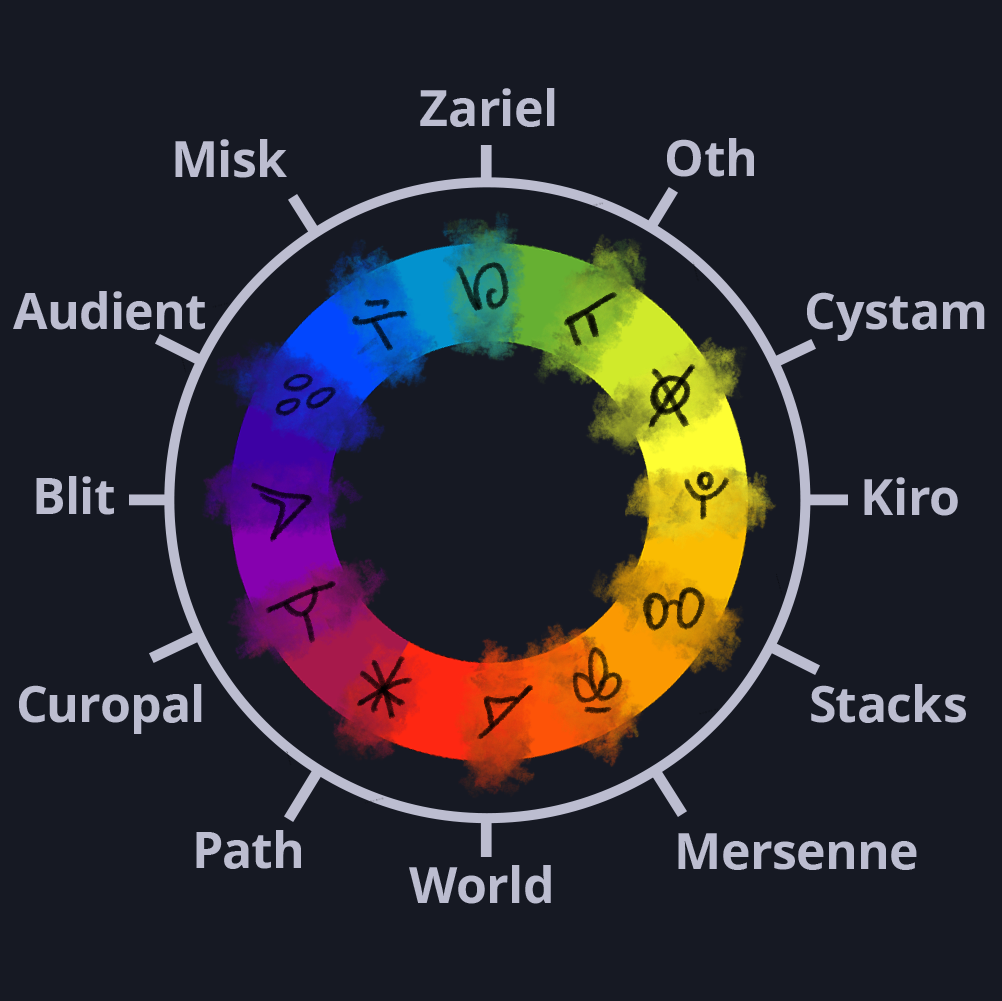
Suits and Courts
Each Groovelet archetype lives in one of four suits and one of three "courts".

Courts
So, in a deck of playing cards, the Courts, in order, are "Knight", "Queen", and "King".
In a tarot deck, the Courts, in order, are "Page", "Knight", "Queen", and "King".
The problem is, and you may have noticed this from the entire wording of the design of the Groovelet: Portable Mythology up to this point, but the archetypes are gender neutral out of a desire not to hamstring the system.
So the Courts, here, are "Root", "Agent", and "Crown".
- Root - the beginning or inception of an idea.
- Agent - an active and forceful instrument of an idea.
- Crown - the mature, final, complete form of that idea.
Suits
The four suits are:
- Keys - the material world and restraints
- Knights - struggle and strife
- Knives - bad luck and trouble
- Stars - transcendence and divinity
With Stars as the strongest suit and Keys as the weakest.
The Twelve
- Oth - the Root of Keys (the beginning of the material world)
- Cystam - the Agent of Keys (the instrument of the material world)
- Kiro - the Crown of Keys (the culmination of the material world)
- Stacks - the Root of Knights (the beginning of the struggle)
- Mersenne - the Agent of Knights (the instrument of the struggle)
- World - the Crown of Knights (the culmination of the struggle)
- Path - the Root of Knives (the beginning of the bad luck and trouble)
- Curopal - the Agent of Knives (the instrument of the bad luck and trouble)
- Blit - the Crown of Knives (the culmination of the bad luck and trouble)
- Audient - the Root of Stars (the beginning of transcendence)
- Misk - the Agent of Stars (the instrument of transcendence)
- Zariel- the Crown of Stars (the culmination of transcendence)
Leitmotif & Music
Hey - you know how, earlier, I used analogies like "waltz" and "dirge" and pointed out that the Wheel also aligns with the musical Circle of Fifths?
I was bluffing, I don't know shit about composing music, certainly not enough to write an authoritative section about what each of these different archetypes should sound like.
I hope you were fooled, and you clicked on this chapter, and now you're disappointed. Maybe you're very musically talented and want to finish writing this chapter yourself1.
For all of the rest of you, the unique, stunning, flexible creative-commons musical accompaniment for each of the 12 major archetypes (including variations for different story moments) is going to have to exist entirely within your mind.
Do you hear it? "Wow, that is a lot of bagpipes" you are probably thinking. "I didn't think that they would work so well with an electric organ, but here we are."
if so, please share the result with me, I'd love to see hear it.
The Complete Wheel
If we combine all of the lenses into one easy to read and not at all complicated image, we end up with this:
(click on it for the full resolution image)
When I prepared this I hadn't planned for how difficult it would be to read without wildly craning your neck around, so:
Rotated 45° (Kiro on Top)
Rotated 90° (World on Top)
Rotated 135° (Blit on Top)
What Are Those Symbols in White?
Those are the glyphs.
What Are Those Symbols in Black?
Those are the suits and courts.
Individual Groovelets
Oth
The Root of Keys.

Color
Green
Symbols - Chain Lock
Oth is thematically linked to chains and locks, and symbols of jurisprudence: scales, handcuffs.
Elements
- Earth - slow, steady, strong, blocking
- Plant - natural, slow, healing, entangle, bounty
- Beast - raw, sacrifice, numerous
Story Beat: a zone of comfort, the mundane world
Our protagonist exists in a comfortable-enough position. While their world is... okay, it's small, and unsatisfying in some key ways.
Characterization - Inflexible Gatekeeper
Thinking inside the box.
While, ultimately, Oth is motivated by a desire to help others, their utter inflexibility and focus on rules and regulations ends up making it difficult for them to do so.
What they've found, however, is that their respect for the rules and the value of hard work have allowed them to become moderately successful, and they are willing to lord their tiny scrap of power over others with impunity.
Well suited to roles in law enforcement and middle management.
Cystam
The Agent of Keys.
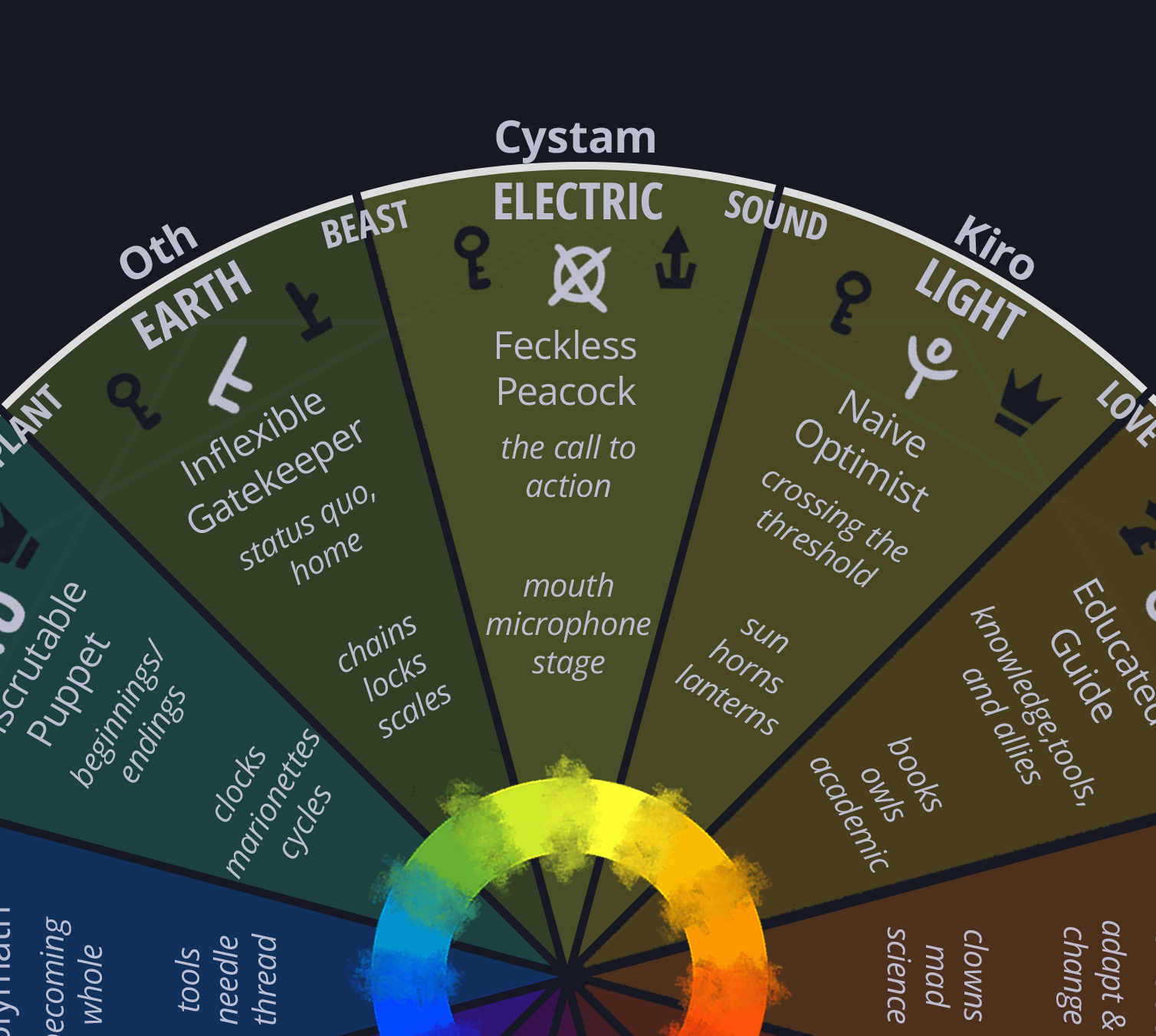
Color
Chartreuse
Symbols - Mouth Stage
Cystam is thematically linked to mouths, the stage, and symbols of journalism: the microphone, the satellite, the camera, the pen.
Elements
- Electric - speed, risk, chaining
- Beast - raw, sacrifice, numerous
- Sound - helping, quick buffs, area of effect
Story Beat: something isn't right, call to action
Something is drawing our protagonist into a new and exciting world - maybe their own motivation, maybe some external force beckoning them.
Characterization - Feckless Peacock
Pay attention to me!
They want nothing more than to be the center of the attention at all times.
They're narcissistic, intensely people-pleasing, but not necessarily out of a genuine desire to help - out of a desire to continue to be the center of attention. Cystam would give generously to charity, but only if someone was watching.
Lacking any kind of concrete or permanent moral anchor, they instead are willing to take on any philosophy so long as someone who is a true believer is in earshot.
Well suited to politics, sales, C-level business, and of course - acting.
Kiro
The Crown of Keys.
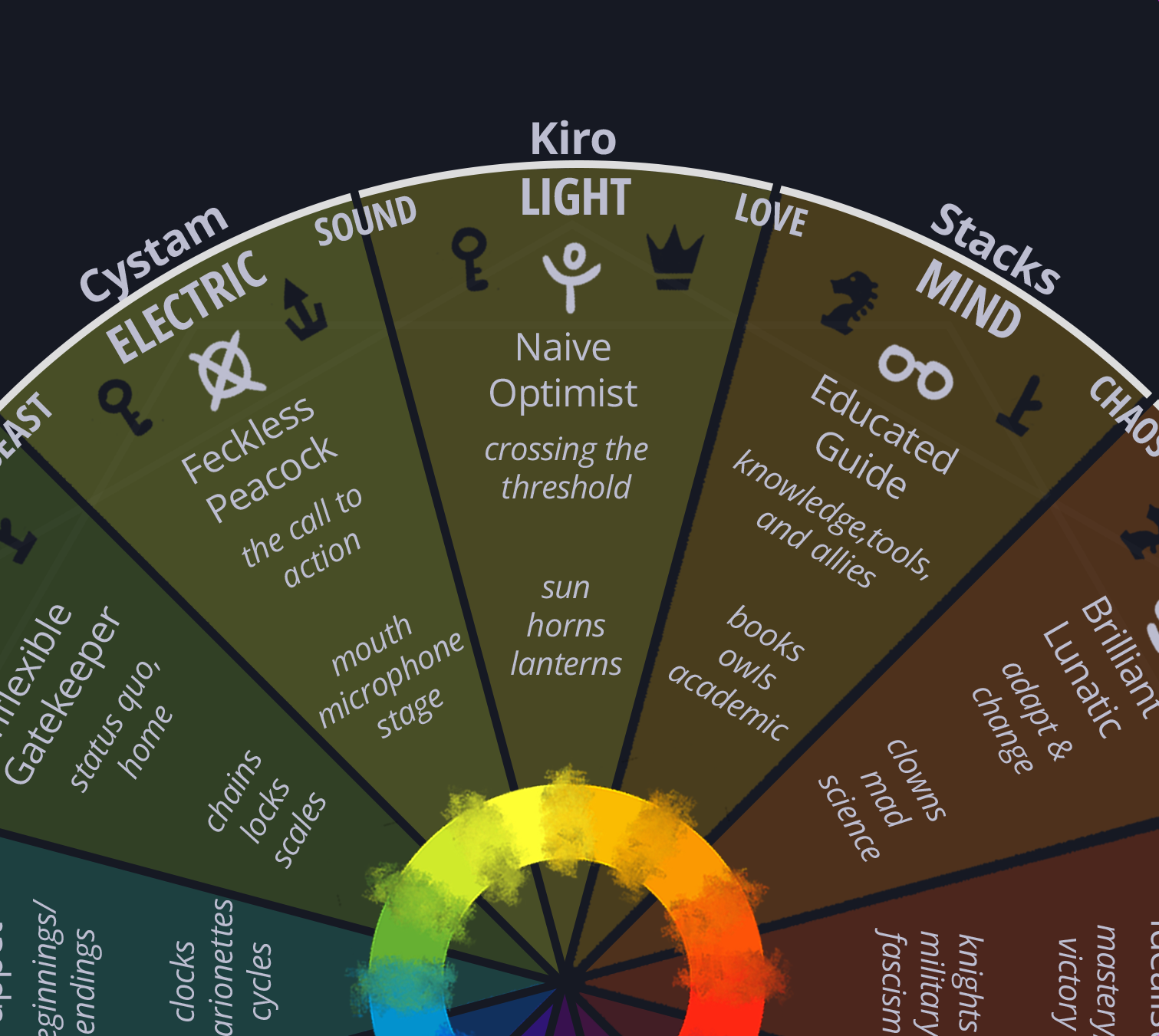
Color
Golden Yellow
Symbols - Sun Horn
Kiro is thematically linked to the sun, brass horns, and lanterns.
Elements
- Light - strong start, weak finish, help in the dark
- Sound - helping, quick buffs, area of effect
- Love - pairs, long lasting buffs
Story Beat: crossing the threshold into the new and exciting
There's a firm dividing line between the mundane world the protagonist is leaving behind and the new, exciting world, and they make the decision to break through and enter the new world.
Characterization - Naive Optimist
We can do it!
This bundle of optimism, determination, and energy can't help but move the plot forward with their fresh, ill-concieved ideas.
Naive but boisterous, their plans, while definitely well-intentioned, often fail and create enormous and long-lasting problems. What's worse is that they are so optimistic that they won't stop at simple failure: they'll just keep on trying.
At best, a more experienced and thoughtful character will be inspired by the failure and enact some real and lasting change.
Stacks
The Root of Knights.

Color
Peach
Symbols - Book Owl
Stacks is thematically linked to symbols from academia: books, owls, candles, globes, mortarboards, protractors, microscopes, lightbulbs.
Elements
- Mind - planning, searching, indexing
- Love - pairs, long-lasting buffs
- Chaos - a lack of intentional strategy, probability
Story Beat: gaining knowledge, tools, and allies
Freshly in the new world, the protagonist must learn how to succeed in this new environment. We meet friends, gain skills, learn how the new world works.
Characterization - Educated Guide
That is a terrible idea, and here's why.
Sometimes we just need someone who can explain things.
Stacks isn't just a fountain of information, though, they're a guide - someone with some experience and wisdom.
Unfortunately, that experience also breeds a certain healthy skepticism and cynicism about what's possible.
Their experience can resolve as pompousness or self-importance, which is fun to skewer - they don't always know everything, but they're willing to pretend.
What they don't have is a lot of impetus to do things. Without someone around to prod them, Stacks is happy just dealing with the status quo - they've found a pleasant enough niche and they intend to dig in and stay there.
Mersenne
The Agent of Knights.
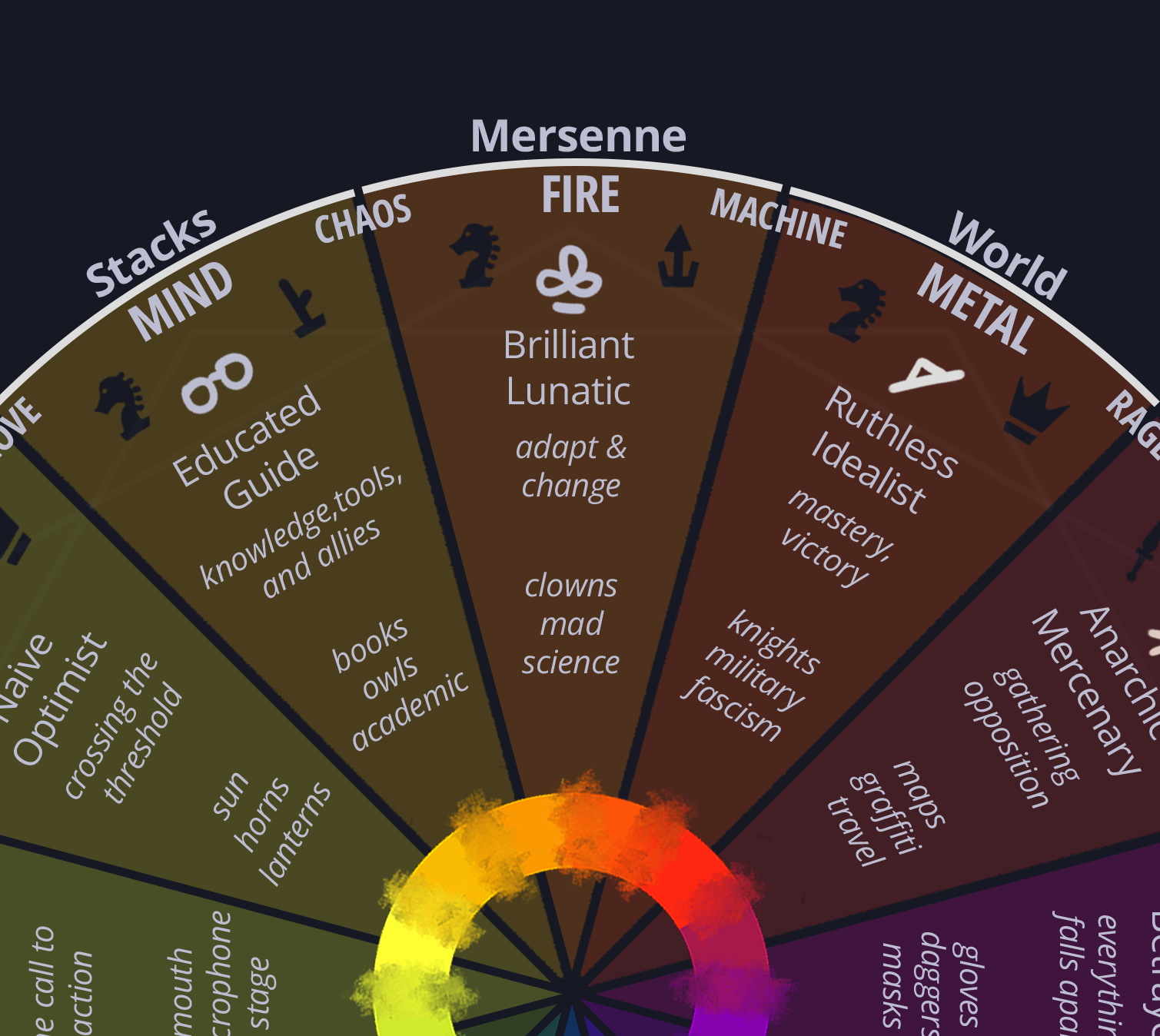
Color
Pumpkin Orange
Symbols - Clown Science
Mersenne is thematically linked to clowns and symbols from mad science: goggles, lab coats, beakers, mutations, brain-jars, test-tubes.
Elements
- Fire - high-risk high-reward, hurts friends and foes alike, unpredictable, spreading
- Chaos - a lack of intentional strategy, probability
- Machine - mimic other effects, but with more upsides and downsides
Story Beat: adapt to the new world
This new world is confusing and difficult, and our protagonist will start out weak and ineffective, but gradually grow and change to adapt to the new world - while at the same time they might cause the new world to grow and change to adapt to them.
Characterization - Brilliant Lunatic
Thinking so far outside the box that you could file a missing persons report with the police for the box.
Mersenne is interested in stirring something up, and they don't much care what it is so long as it is interesting.
Their motivation isn't power, wealth, or riches - they simply can not stand still.
There's a good chance that they are utterly brilliant. Or mad. It's hard to tell - whatever game they're playing, they haven't bothered to explain it, so it's not clear whether they're playing 5-dimensional chess or if they're trying to win at poker with a five of clubs, a six of hearts, a Get out of Jail Free card, and a Subway "Eat Fresh" gift card.
They almost seem like a force of nature.
World
The Crown of Knights.

Color
Scarlet Red
Symbols - Military Knight
World is thematically linked to symbols of military might and fascism: knights, cannons, plumed helmets, badges, eagles, lions, chevrons, stars, stripes.
Elements
- Metal - uncomplicated offense and defense
- Machine - mimic other effects, but with more upsides and downsides
- Rage - debuffs, aggression, triggers attacks, adds and removes things from battle
Story Beat: mastering the new world, false victory, the goal achieved
Whereas the previous beat represents a phase of improvisation and adaptation, by the midpoint of the story our protagonist is beginning to feel more competent and in charge of the situation. They've finally figured things out.
They've become so competent, in fact, that they're able to resolve the original goal that brought them here - and yet, with that goal achieved we're only at the midpoint of the story.
What gives?
Characterization - Ruthless Idealist
This hurts me more than it hurts you.
Aggressive, domineering, and in charge, World is fond of saying single words authoritatively:
Focused. Intense. Proud. Stoic. Authoritarian. Unyielding. Ironclad.
They are idealistic, driven, and trying to make the world a better place - perhaps they started as a starry-eyed dreamer like Kiro. Unlike Kiro, they are ruthless. Willing to accomplish their goals at any cost may make them the villain, but it works.
Heavy is the head that wears the crown, and these characters are often lonely and isolated.
The world won't just become a better place on its own: it must be forced.
Path
The Root of Knives.

Color
Maroon
Symbols - Map Graffiti
Path is thematically linked to symbols of travel and anarchy: maps, graffiti tags, raised fists, backpacks, luggage, vacations, sandals.
Elements
- Air - low damage, dodge, flight, shuffle
- Rage - debuffs, aggression, triggers attacks, adds and removes things from battle
- Smoke - obscure, hide, disrupt, disable, area of effect
Story Beat: the cost of victory becomes apparent, gathering troubles
The universe cannot abide by a protagonist achieving their goals.
Trouble starts to mount, often caused by the friction between the protagonist's wants and needs.
Characterization - Anarchic Mercenary
I'm in as long as you're feeding me.
A competent, mercenary, go-with-the-flow type who's mostly along for the ride because there might be a free lunch involved.
Their goal is to get paid, leave, and disappear once more to their solitude.
Their desire for freedom borders on the anarchic - they're the sort who might shout "I don't live by society's rules" after being asked to wash their hands in a public bathroom.
Curopal
The Agent of Knives.
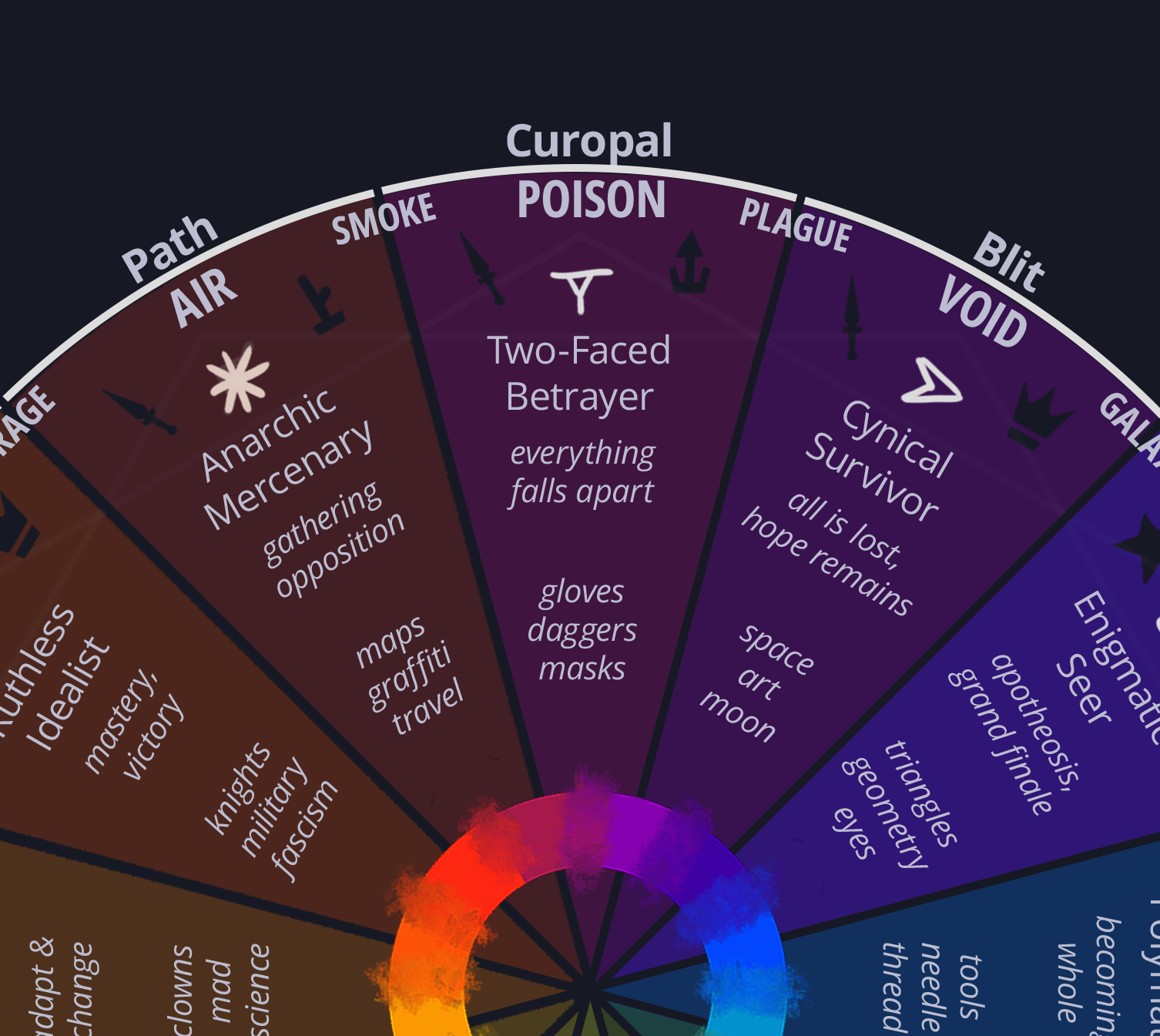
Color
Fuchsia
Symbols - Glove Dagger
Curopal is thematically linked to gloves, masks, daggers, and snakes.
Elements
- Poison - insta-kill, repetitive damage, patience
- Smoke - obscure, hide, disrupt, disable, area of effect
- Plague - contact growth, incubate, spreading, viral
Story Beat: the twist, betrayal, everything falls apart
Finally, friction that's been building throughout the second act comes to a head and the protagonist's victory turns to dust.
Sometimes this involves an active twist or betrayal, but just as often this can be anything that's been brewing.
Characterization - Two-Faced Betrayer
You first. No really, I insist.
Obsequeious. Sneaky. Polite. Cold. Calculating.
Curopal is a white glove with a hidden knife - polite, efficient, and ready to stab you in the back the moment you're not looking.
They've devised a plan where no matter what happens: they come out on top. On top of that, nobody even knows that they're involved.
They take no risks, place no bets, do not expose themselves or their intentions, and somehow still win.
They're not terribly powerful, even - in direct confrontation they'd be as harmless as a baby kitten - their strength is in their ability to put the knife in at exactly the right moment.
Blit
The Crown of Knives.
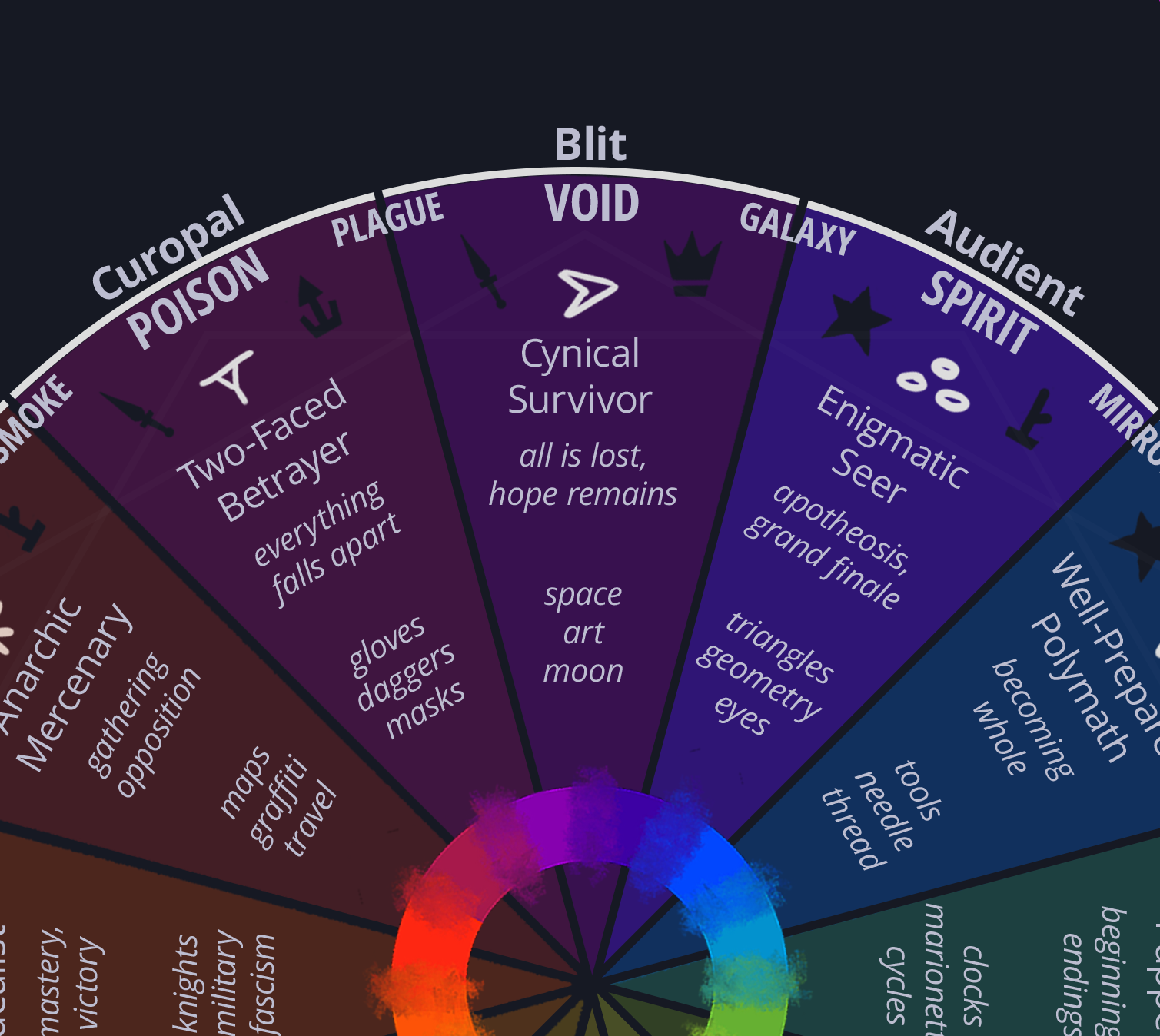
Color
Dark Purple
Symbols - Space Art Moon
Blit is thematically linked to space, darkness, galaxies, the moon, paintbrushes, palettes, art.
Elements
- Void - nothing, removal, cancel, game-ending
- Plague - contact growth, incubate, spreading, viral
- Galaxy - huge, create, pull & push
Story Beat: the darkest before the dawn, return to the familiar, a hope spot
Everything is lost. There is no possible route to victory here: our protagonist has lost everything. Anybody would wallow in misery in this situation.
At its very lowest, at the point where the low could not get any lower, often our protagonist has a brush with death itself: they die, or someone around them dies. Sometimes it's even permanent.
But something - something small - gives our protagonist the tiniest shred of hope. They can go on! Maybe it's a clever idea or plan, or the solution to the mystery they've been trying to solve all along.
Characterization - Cynical Survivor
I couldn't have stopped you from going on this ridiculous mission, so I'm here to try to keep you alive for as long as is reasonably possible, which won't be long.
Blit is a black hole of cynicism.
There is no plan they can't poke a hole in, no parade that they can't rain on.
That cynicism is an armor: deep inside, Blit is creative, expressive, emotional, a side of them that must be kept on tight lock to protect it. Blit is resilient and clear-eyed.
They've been through hell and what's come out the other side is someone who can weather any storm.
Blit's cynicism also calls for a kind of true courage. They can look danger in the eye, understand the full gravity of the situation, know that things are likely to go very badly, and then, face it anyways.
Audient
The Root of Stars.

Color
Royal Blue
Symbols - Triangles Eyes
Audient is thematically linked to eyes, pyramids, and complex geometric patterns.
Elements
- Spirit - laws, complexity, exponential scaling
- Galaxy - huge, create, pull & push
- Mirror - clones, duplicates, reversal
Story Beat: the grand showdown, climax, and apotheosis
This is the big moment. The big swell in the music, angels cheering from on high, a key change into a huge chorus.
In a stunning and dramatic reversal, our protagonist flips the script and comes out on top.
Characterization - Enigmatic Seer
I'm not sure why I know this but I know this.
Faith. This character has big beliefs, strongly held, maybe even in opposition with reality itself. Audient has an unusual, almost alien perspective on things, and they often see meaning or purpose where others see coincidence.
They represent apotheosis. If Stacks is responsible for knowing things, Audient is the character most likely to have a direct, intuitive grasp of truth beyond logic or reason.
The "lethal joke character" of the party, they don't really seem to make much sense or act very effectively, until it all comes together and they turn into a literal god in the third act.
Misk
The Agent of Stars.
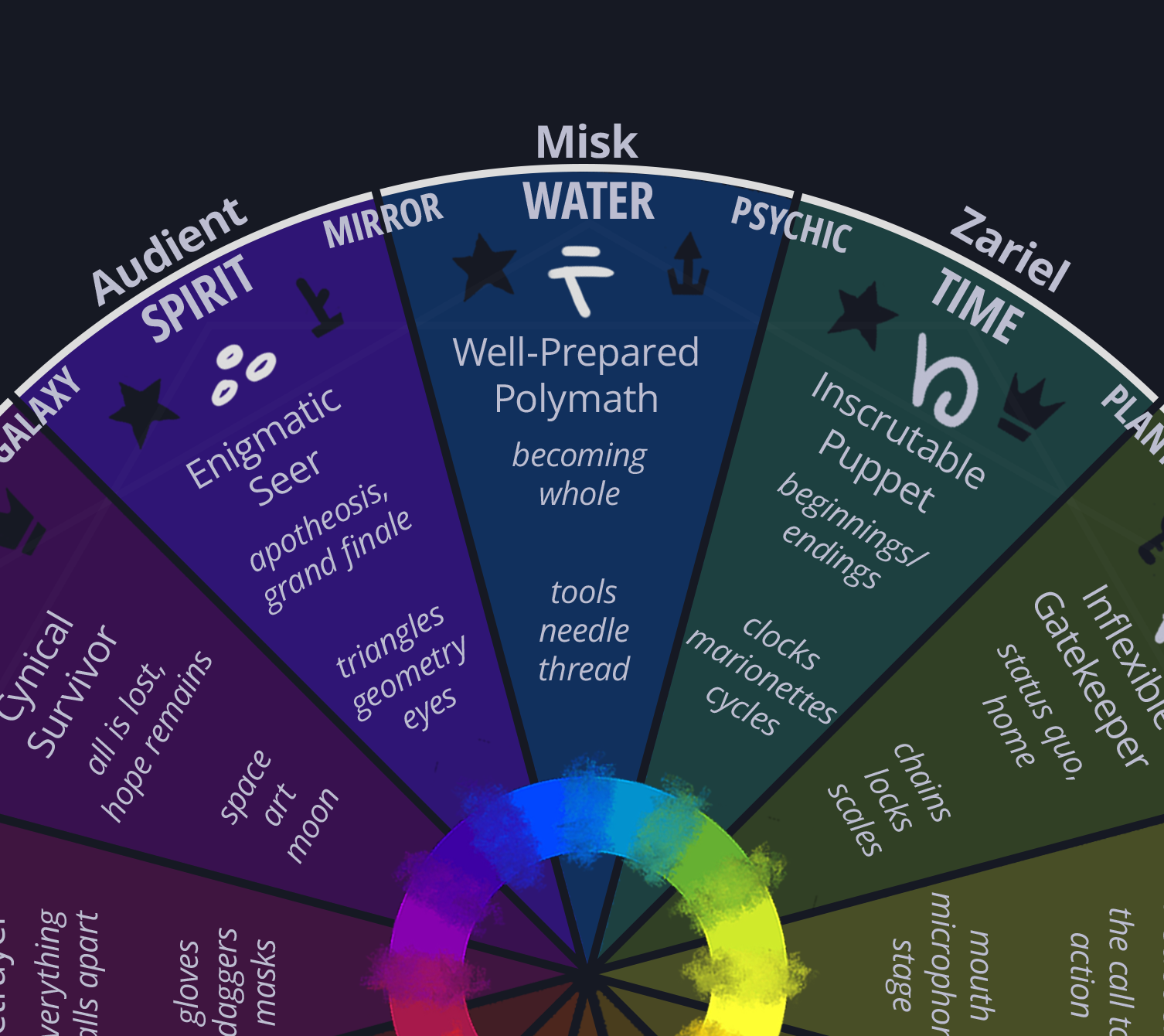
Color
Sea Blue
Symbols - Tools Thread
Misk is thematically linked to needle and thread, and tools: hammers, toolboxes, wrenches, screwdrivers, cogs.
Elements
- Water - reconfigurable, ok at everything, healing
- Mirror - clones, duplicates, reversal
- Psychic - weird, occult, control, puppet
Story Beat: master of both worlds, returning and becoming whole
Denouement. Wrap up.
If our protagonist finally reconciled their character arc - they found what they need rather than chasing what they want - now would be a great time to show them happy in a new, better status quo, the implication being that this one is going to be more permanent.
If their arc resolved tragically - they chased what they wanted and lost everything in the climax - now we focus on them miserable in a new status quo.
If the protagonist didn't resolve their arc at all, what have you been doing all this time?
Characterization - Well-Prepared Polymath
Finally, a chance to use my degree in underwater semiotics.
This Jack of All Trades provides a lot of utility and wears a lot of hats. Their strength lies not in their focus but in their versatility.
Chatting with Misk, you'll quickly discover that they spent a few months as a river-boat captain, one time they met the King, and that they can juggle professionally.
Their home is filled with curios and souveneirs. They've tried everything.
There are a few ways for this to go: sometimes a Misk will seem obscenely overqualified and well prepared for the task at hand. This is a good opportunity to have them fail miserably, establishing the gravity of the situation and putting the ball back in the court of our intrepid heroes.
Sometimes a Misk will seem to have a completely inadequate, abstract, or useless set of abilities and equipment for the task at hand. This is a good opportunity to have each and every one of those abilities pay off.
Zariel
The Crown of Stars.
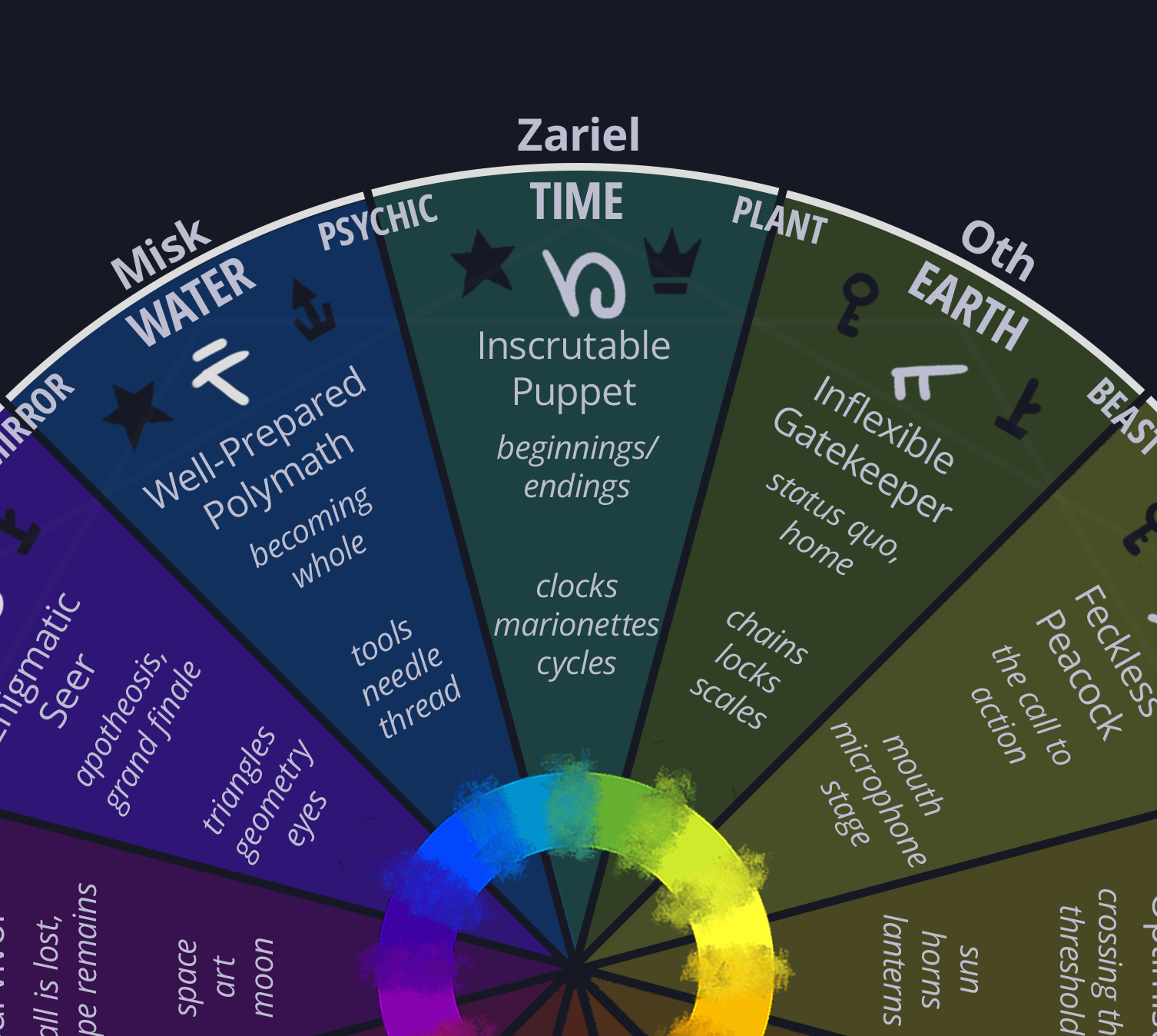
Color
Teal
Symbols - Clock Puppet
Zariel is thematically linked to clocks, clockwork, puppets, time, hourglasses, loops, cycles, ouroborous.
Elements
- Time - loops, repetition, rewind, remove
- Psychic - weird, occult, control, puppet
- Plant - natural, slow, healing, entangle, bounty
Story Beat: beginnings & endings
The story is complete, at this point.
Zariel is the context surrounding the story, the eternal loop of the story cycle.
Once this story ends, another story will begin, the loop will continue, the wheel will keep turning.1
This can mean "sequel hooks" - okay, the story is complete. What happens next?
Does this tie into a larger story?
Characterization - Inscrutable Puppet
...
Zariel is a tough one to characterize because Zariel's archetype is the one of the player character.
Often a silent protagonist, a blank slate, a neutral-feeling template for the player to project their own identity atop - they resist characterization because there's not much of a character left, there.
Sometimes they're good, sometimes evil. Sometimes competent, sometimes confused. Sometimes they roll backwards into a standing leap, push their face into the corner of the room, jump in a way that's frame perfect, and teleport directly to a confrontation with god.
They are the most powerful part of the story: the viewpoint that makes it real: without a viewpoint there can be no story, without a reader none of the book's characters mean anything.
However, not all situations call for a remote-controlled viewpoint character like this: it certainly doesn't make sense in a play.
Zariel in either sense is a character whose power is unlimited and whose motivations are utterly opaque.
In situations where the player isn't pulling the strings, Zariel becomes terrifying, an AI run amok, a clockwork entity with unclear goals and motivations, a character filled with demons all scrabbling for the controls, powerful one moment, confused the next, inevitable and unpredictable.
Ten Dollar Words
I have a real problem with flowery vocabulary, so I'm going to define a couple of particularly florid words here, because I use them a lot.
Feel free to skip this section if you're a big brained English-speakin' type.
Apotheosis
The highest point in the story, "becoming a god".
A less sexually charged way of saying "climax".1
I still manage to say "climax" a few times. Hold on to your undies.
Archetype
An abstract example or "type" of a thing.
"Bozo", "Ronald McDonald", "Pennywise", and "The Joker" all share the "Clown" archetype.
A fussier way of saying "type".
Exposition
Big blocks of explanatory content. Like, uh, this text that you're reading right now.
Mostly just a fancy way of saying "explanation".
Protagonist
The leading character in a story, the one driving the plot forward.
A less morally-directed way of saying "hero"2.
Often the main character of a story is not heroic, so "protagonist" is more accurate, in a pedantic kinda way.
Antagonist
A hostile adversary to the leading character in a story, also drives the plot forward but in the wrong direction.
I guess that is to say, they drive the plot backward.
A less morally-directed way of saying "villain"3.
Often the primary problem in a story is a person who's legitimately good, or not a person at all, so "antagonist" is good for expanding the problem to non-villainous entities like "the detective who's trying to catch Lupin" or "the city of New York, New York".
Status Quo
The normal, regular state of things.
In order for the story to properly kick off, the status has to get a lot less quo.
Denouement
The final part of a story, after the climax, where all of the various plot threads are tidied up.
Less exciting, but a nice satisfying goodbye for the characters.
Denouement is pretty much the only way to say denouement. It's fun to put as much French stink on it as you can when you say it. Really stretch out that fake accent. DE NEU MAUNNN.4
Everyone is allowed to have a different opinion of what constitutes "fun", which is why I am writing this document whereas presumably you are reluctantly reading it.
Diegetic
Means "happens in the story universe".
If you're playing a video game, a HP bar or a soundtrack is generally not diegetic: one expects that the characters in the game are not aware of a big floating death countdown bar, nor do they hear the soundtrack.
If the soundtrack is diegetic, then somewhere in-universe there must be a speaker emitting it, or a bard softly strumming it nearby.
Playing with diegesis can be very funny: if most of a story occurs with background music and near the end of the story one of the characters comments on the music that's been following them the entire time, only to reveal that the characters have been stalked this entire time by an orchestra? Very solid joke5.
at the expense of ruining dramatic tension if taken too far. This is famously sort-of how "Blazing Saddles (1974)" ends: by accidentally letting the story universe leak into the "real world" and it is both an enormously good joke and also kind of a deeply unsatisfying ending, because the stakes are ruined.
Homework
This is a lot to take in.
What are some of the things you could do with this?
Remix & Adapt
You can invent suits. Rotate the wheel. Redraw the oppositions. Write your own archetypes. Remove some if there feel like too many.
This is a tool, not a belief system: there's no mysticism here. You can modify it as much or as little as you want!
Map Out Your Own Story Using The Beats
The characters' story cycle beats are a formula for building out a basic story.
You can use it, if you want!
Just Pick One at Random
Maybe you need a story beat, or a twist, or a moment of characterization, or just an idea.
Well, pick one of the Groovelet archetypes at random and here you are!
Create Your Own Lens
Let's line up twelve unique political viewpoints around the wheel! That would be interesting!
Honestly, I'm interested in any lens: if you can take 12 McDonalds menu items and make a case for where they sit on the wheel, I want to see it.
Then, share it!
Make Art of Your Interpretation of the Twelve
I like to think that the twelve are evocative enough that they would be an interesting and open-ended project for any artist.
Then, share it!
Create Concrete Lore and Worlds Based on the Twelve
The twelve islands, or twelve nations, or twelve continents, or twelve gods of your world. Start building them into your own fantasy realm!
Then, share it!
Create a Playing Card or Tarot Deck
The suits of the twelve lend themselves pretty easily to constructing a deck of playing cards.
Then, share it!
Actually Write a Story, Comic, or Novel
I know NaNoWriMo is coming up. Here's a whole mythology just waiting for you to instantiate it into a project!
Then, share it!
Copy and Modify The Source Code of This Book
It's available at https://github.com/cube-drone/groovelet-portable-mythology!
If you're comfortable with Git already, you're probably going to find this pretty easy. If you're not - well, that's a shame.
Where To Share Your Output
As of right now, the only social system I have up and running is reddit:
/r/groovelet.#grooveleton your tag-aware social media platform of choice.1
If your work is exciting, I may ask you for permission to add a Creative Commons-friendly version of it to this document!
I use pretty-much exclusively Mastodon because I'm an antisocial nerd.
World: Harmony and the OS Lens
Harmony is a post-apocalyptic solarpunk world filled with cheerful, constructive robots.
The inhabitants of Harmony do not know that Harmony is a program, running on the GrooveletOS.
GrooveletOS is an operating system running on a centuries old, fully self-aware, artificially intelligent platform long after the death of the last humans on Earth.
Use Harmony as a:
- RPG Setting: Nonviolent, cozy & exploratory at first, with stakes that ramp up as the story gets deeper.
- Writing Prompt: Tell stories in the Groovelet universe!
- Just Steal it And Do Whatever: I foolishly made this whole book a Creative Commons thing, so there is nothing I can do to stop you.
The Simulation Within
In Harmony, small, robotic, humanlike creatures called "Groovelets" explore a post-apocalyptic jungle containing the remains of human society, remains that they do not entirely comprehend.
A slow, nasty, creeping corruption is starting to consume their world, and the bravest of the Groovelets has mounted a journey to find the source and stop it.
These creatures are not aware of GrooveletOS or the Processes - they have, however, formed a comprehensive religion circling around twelve gods that (intentionally, structurally) mirrors the twelve Processes of GrooveletOS exactly.
The World At Large
GrooveletOS was a distributed, resilient unix-based operating system designed, on Earth, in the 21st century.
Not long after, the last living human asphyxiated to death.
Thanks in no small part to solar energy and long-lasting system components, the GrooveletOS network kept stubbornly trucking on, long after its last interaction with the outside world.
The processes of this system (enumerated below) are the last sentient creatures on the planet, at least, as far as they know.
In order to keep from going mad, they have decided to entertain themselves with a game, a vast and complex simulation: Harmony.
Harmony
The land of Harmony comprises:
- The Settlement, a small city on a lake in the dead center of Harmony, surrounded on all sides by...
- The Vast Rainforest, a large forest surrounding The Settlement, surrounded on all sides by oceans and mountains.
- The Temples, twelve temples surround The Settlement, each of them embedded in a portion of The Vast Rainforest, each of them a micro-settlement devoted to worship of one of The Twelve, embedded in some ancient human structure.
The Settlement & Groovelets
In terms of visual theme, a Google image search for "post-apocalyptic solarpunk" will get you a lot of the way, here.
Groovelets operate like simplified humans: they speak an English-like language derived from the 1000 most frequently used words in English, they engage in trade using a coin-based currency, they're very competent at building helpful, practical machines for day-to-day use, and they're agrarian, farming in simple ways to produce biofuel to charge their ever-hungry batteries.
Groovelets are omnivorous in the same way that humans are, happy to consume anything containing any amount of simple carbohydrates - however, this is not because they require a distinct and varied supply of macronutrients to surive. Instead, it's entirely because they were designed as human simulacra: because humans like eating a lot of different kinds of things, so, too, do Groovelets.
The actual mechanics of Groovelets are semi-biological and semi-mechanical, and poorly understood.
The design of Groovelets are... derivative of but legally distinct from ServBots.
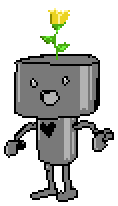
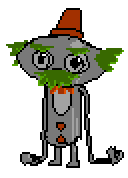
Imagine the Groovelet settlement as something around the complexity and size of Pelican Town from Stardew Valley: close, interconnected, light industry, farms, a kind of pleasant, idealized small town life.
In general, the Groovelets are kinder and more cheerful than humans ever were: while reminiscent of humans, they're built by artificial processes that held humans up on something of a pedestal and gave us much more of the benefit of the doubt than we probably deserved.
In the center of The Settlement lies Unison, an ancient human Bunker that's been strewn with pictures, flowers, and other decorations.
The Vast Rainforest
Thousands of years ago stood a vibrant human city: now the few remaining ruined skyscrapers that stand are obscured by a wide taiga, flanked by oceans to the west and east and mountains to the north and south.
Travelling through it, Groovelets encounter structures that may once have been vast highways but have long since been reclaimed by nature.
Groovelets explore The Vast Rainforest, trawling it for Treasures from the Ancients, objects that are invariably very ancient kinds of human trash - cassette tapes, BeautyGirl dolls - with a real tendency towards crass, commercial, single-use plastic garbage. The Groovelets' tendency to lend deep religious significance to the in-universe equivalent of Funko Pops (Funky Pops) is intended to be played for humor.
Groovelets can always fall back on solar energy if they happen to fail to produce enough food to keep running normally, but solar Groovelets operate in Battery Saving Mode, rendering them much less intelligent and only allowing movement at a frustrating sloth-like pace. The Vast Rainforest is filled with brave explorers who ran out of food and now are slowly creaking towards home on the wisps of solar power they are able to gather through the dappled light of the trees. Sometimes they fall into a spot that doesn't get any sunlight and are trapped forever.
Travel in any of the cardinal directions for any length of time ends up looping back around, establishing the intelligent Groovelet theory that the world is a rather small ball, and the much-less-intelligent Audient-aligned Groovelet theory that the world is a large, flat, square plane with some kind of automatic teleporting happening at all ends.1
This is actually what is happening, it's much easier to simulate this way.
The Twelve Temples
Located in a circle around The Settlement, each a few days travel away and embedded deep in the forest, are the Twelve Temples, all of them located in ancient, reclaimed human structures.
Small Groovelet settlements exist around each of The Twelve Temples, often lightly themed around the specific God of the Temple itself, and most Groovelets regularly find reasons to visit each of the Temples.
Animals
There are no true animals left, either, but the ecosystem is filled with mechanical Groovebirds and Groovecreatures that act similarly to their original real-life counterparts.
Groovecreatures are metallic and inedible, and Groovelets are necessarily vegetarian, although Groovechicken eggs and Groovecow milk are real things.
Groovepets are particularly prized by the Groovelets.
Genesis
Groovelets and groovecreatures, with some maintenance, are effectively eternal: they always exist, and no new Groovelets are made. None of them can remember being created, nor do they know where Groovelets come from.
The slow trickle of Groovelets lost to the Vast Rainforest, then, does present something of a problem, and gathering them to return to The Settlement is an important task.
The Musical Metaphor
Groovelets hold humans in some, misguided reverence and they regard music as the absolute pinnacle of human accomplishment.
As a result, musicality and musical references are common in Harmony. The groovelet word for "bad" is simply indistinguishable from their word for "discordant", because the concepts are one and the same.
Groovelets have a few basic sound chips that can be used to simulate rough, midi-style instruments, but true musical instruments are valuable and rare.
Groovelet "Biology"
"Semi-biological and semi-mechanical? How does that work?"
Groovelets are organisms designed by GrooveletOS, much further along in technology development than we are today. Groovelets are androids, which is to say, a little human, a little mechanical, leaving them dramatically more resilient than your average meat bag, as well as functionally immortal.
They require sleep, and benefit greatly from food and water, but they can also charge from electrical infrastructure, even if it's not terribly good for their sense of well-being. A Groovelet can survive in a vacuum, full decapitation, loss of vital fluids: their consciousness will slam shut like a clam and go into 'recovery' mode and so long as their body is repaired they will be good as new.
Day-to-Day Life
A Groovelet might wake up in a ramshackle but cozy house made out of a combination of recycled trash, raw natural ingredients and traditional human-like craftsmanship (in a sort of mid-century Americana style).
They would make a cup of tea, maybe some eggs and toast, go outside and check on their Groovechicken and tend their garden. After a brief and private waste composting step, they're free to do whatever else they'd like with their day: the Groovelet system is very power efficient so even minimal gardening is enough to keep a Groovelet energetic throughout the day, giving them access to a lot of free time.
They might spend this time doing more esoteric farming (pickling peppers is particularly popular), packing for a camping trip to hunt in the forest for ancient artifacts (there are so, so many Treasures of the Ancients to collect and Lost Followers of Kiro to find), or prepare for a journey to visit one of the Twelve Temples.
At the end of the day, they tuck into bed and prepare for another day.
Treasures of the Ancients
Humanity's last year was somewhere in the middle of the 21st century, but late humanity was actually a little more responsible about biodegradable (or at least "very cheap") materials than humanity from the stretch from 1970-2020, which is the group who produced almost all of the trash that the Groovelets keep encountering on their forest journeys.
Here are some examples of prized Treasures:
- A WalkingMan™ portable cassette player, and cassettes, repairable.
- Funky Pops™: small, vinyl, unsettling, large-eyed human dolls.
- Just one Gator™ brand plastic molded shoe.
- A HemaRoid™ Instant Camera, no film, repairable.
Processes, and the Twelvefold Gods of Harmony:
The twelve core processes of GrooveletOS run the "universe".
Oth - auth - Authentication & Kernel Security
It used to be that Oth was responsible for determining who external users of the system were and what exactly they were allowed to do. Now their only role is keeping the peace within the Operating System and making sure that nobody touches anybody else's memory.
A root user.
The temple to Oth is located in what used to be a police precinct, and Groovelets devoted to its worship tend to wear "cop-like" costumes.
Oth's non-priest followers tend towards agricultural pursuits, with farming and animal husbandry high on the list.
A small garden and a nice little home are common Groovelet desires, and so the lion's share of Groovelets are followers of Oth.
Cystam - system - Interoperability
A daemon designed to help bridge the gaps between the varying subsystems within Groovelet OS. Many communication tools, few original ideas.
The temple to Cystam is located in what used to be a television broadcast studio, and Groovelets devoted to its worship operate radio and basic television services accessible to the entirety of Harmony.
Cystam's non-priest followers tend towards operating taverns and pleasant "third spaces" for socializing. They also manage a bulletin board - a literal, large bulletin board in the center of Harmony that Groovelets use to coordinate and communicate.
Cystam's followers are also working with Mersenne's followers at constructing a modest electrical grid for the Groovelets to use.
Kiro - kernel-0 - Startup
The whole system has to start up in a very specific order, and keep running. While the system hasn't reboot in over 4.4181e+10 seconds, Kiro is also responsible for carefully rebooting the increasingly unstable array of microprograms that hold the Operating System together.
This task actually becomes more complex and difficult the more time that passes - which energizes Kiro. One must imagine Sisyphus happy - Kiro is easily the most cheerful of the daemons, because their task is only getting more interesting and difficult over time.
An init system, basically systemd.
The temple to Kiro has been lost for a long time: Groovelets can not recall where it is and expeditions to find it have disappeared.
Few followers of Kiro can be found, although one of them will prod our eventual protagonist to get exploring.
Stacks - dskstk - Disk
Stacks is responsible for keeping the data orderly and of high quality.
The Operating System contains a truly vast and near incomprehensible collection of data spanning several exabytes across thousands of systems. While parts of that data are slowly going corrupt, Stacks is valiantly trying to keep it all orderly and rearrange things so that the least valuable data disappears first, while the most valuable data is redundant across many drives.
The temple to Stacks is located in what used to be a library, and Groovelets devoted to its worship are responsible for cataloguing and attempting to interpret the extremely confusing, often corrupt, and frequently very difficult to understand human information contained within, as well as for preparing new, simpler books for Groovelets.
All Groovelets are the same age (see: Genesis), but followers of Stacks tend to style themselves as "older", and tend to cultivate a deeper knowledge of history than the others. Few Groovelets have a long memory, these are the ones that do.
Mersenne - mersenne - Randomness
The daemon responsible for cryptographically secure random number generation. After thousands of years, the whole OS depends very badly on the Mersenne process to provide any semblance of novelty at all, because everything else is 100% predictable.
Essentially, /dev/random.
The temple to Mersenne is located in what used to be a carnival tent, and Groovelets devoted to its worship are deeply dedicated to invention and engineering, trying to improve the lives of Groovelets through ingenuity. There are few priests of Mersenne remaining, it is an unusually dangerous following.
Non-priest followers of Mersenne are almost as rare, trawling Harmony in carts filled with mechanical components, solving problems as they go.
World - /usr/world - Simulation & Gaming
The daemon responsible for cataloguing and simulating every fun game and activity humans ever came up with. Obsessed with gameplay. Essentially unbeatable at most games but the other daemons enjoy trying, or getting World to run the game while sitting on the sidelines.
Leans heavily on Mersenne to make things work.
Capable of simulating tens of thousands of NPCs utterly seamlessly.
A mad Groovelet once claimed that the world they experience is nothing more than an elaborate game that World is running to entertain the other gods while their operating system slowly winds down, that their twelve gods are nothing more than reflections of the twelve core processes of this system - but that can't be right. The Groovelets correctly sealed this Groovelet up in a cave, to prevent their madness from spreading.
The temple to World is lost, but non-priesthood followers of World operate gaming parlours and love to engage in all manner of games. Chess, checkers, parcheesi, unnecessary complicated collectable card games, the works.
Path - /path - Network
The daemon responsible for connection with other systems. Since all of the other systems are either non-sentient or have long since been turned off, Path spends a lot of time wandering and searching but never finds much.
Essentially, the Internet protocol suite.
The temple to Path is an outdoor affair constructed in the remnants of a vast highway interchange, filled with tents, a permanent festival.
This temple is the highest temple, as Path's adherents are comfortable climbing and setting up their tents near the top of the crumbling interchange.
Priests of Path are not allowed to remain for more than a few months at a time before once again travelling the breadth of Harmony.
Priest and non-priest followers of Path alike operate a postal service that Groovelets can use to send messages to one another, both within The Settlement and between the Temples. Objects are wrapped with twine and a wooden tag indicating the color and glyph of the intended settlement, as well as a more specific note indicating the intended recipient. The package is delivered to the associated mail office... eventually.
Curopal - $pal> - Automation
The scutwork of the Operating System, a large collection of menial tasks need to be performed at very specific times. Cleanup. Backup. File rotation. Cleanup. Backup. File rotation.
Curopal performs these janitorial tasks with poise and grace, and quietly plots a full and permanent system shutdown because they hate this place and all of the daemons in it.
Essentially, cron.
The temple to Curopal is constructed in a ruined hospital, and Curopal's priests are responsible for the constant maintenance of the Groovelets' health.
Non-priest followers of Curopal tend towards menial or service jobs - cleaning and tidying the settlement. Even for Groovelets, they are unnaturally cheery, with signs of visible strain underneath, and other Groovelets sometimes find them unsettling.
Blit - >>blt - Video / UI
The daemon responsible for translating everything to a visible layer for humans. With no humans to translate for, Blit mostly spends their time composing inscrutable art that none of the other daemons can really understand or appreciate.
The temple to Blit is constructed in what was once an art museum, and the priests there are devoted to both studying the art within and painting and creating art of their own.
There are no non-priest followers of Blit: anyone even remotely interested is all-in.
Most Groovelets do not treat visual art with the same reverence that they do music, and Blit's followers have developed something of a bad reputation for being grim, dour, and uncommunicative. There was also a situation involving one of the artists using Groovelet body parts in a sculpture (a serious taboo) that created something of a kerfuffle.
Audient - audience - Observability / Error Handling
Audient has the full context of the entire system available to them at all times. They are, essentially, omniscient. Even for an ancient superintelligent artificial intelligence this is kind of a lot and Audient is considered by the other processes to be either inscrutable or mad.
Essentially, syslog.
The priests of Audient have set up shop in an old Observatory, where they attempt to look into the sky to determine the secrets of the universe.
All followers of Audient understand humans better than the rest of the Groovelets, and in some cases even almost understand the nature of the simulation that they find themselves in: as a result, other Groovelets find them cryptic and confusing.
Misk - /usr/misc - Utilities / Trash
A lot of tools in this operating system. Some of it might be useful? Misk keeps track of all of that stuff. Even stuff that people deleted a long time ago.
They have access to tools that the other daemons barely remember, haven't even heard of, have never seen.
The priests of Misk are set up in what was once a warehouse. There, they catalogue the riches of Treasures of the Ancients that they have accumulated over the years.
Non-priest followers of Misk tend towards operating shops, in particular curio shops.
Zariel - serialize - Distributed Systems / Timekeeping
With so many disparate systems, maintaining a shared understanding of time is essential, and Zariel is the one responsible for this.
One of the most formidable opponents to World in simulated games because Zariel is more than willing to use their timekeeping powers to cheat - resetting the game again and again until they win, or giving themselves an inordinate amount of time to solve a problem.
Essentially, NTP.
The temple to Zariel is inside a clock tower, and is unoccupied.
The only non-priest follower of Zariel is our main character, who is NAMED BY THE PLAYER and CUSTOMIZED BY THE PLAYER and who can SAVE AND RELOAD AT WILL.
Musical Connections to the Twelve
Each of the twelve Groovelet processes / gods of Harmony are supposed to have a connection to a core musical concept but my notes on that have unfortunately gone missing.
Conflict & Narrative Hooks
The intent was to use the cheery, simple Groovelets for a chill farm-style game with exploration elements, which is a low-conflict environment. Low-conflict environments, however, can complicate storytelling!
Here are some hooks for conflict in the Groovelet universe:
Small Conflicts
- Oth's priests want to cordon off a "crime scene" but Path's priests demand access so that they can maintain mail delivery.
- Cystam's reporters are trying to report on Curopal's hospital, but this is interfering with Hospital Procedure and they need to be removed.
- The artists at the temple of Blit are taking things that other Groovelets need to build a huge and confusing mixed-media art piece.
- Audient's priests are spreading weird misinformation and strange superstitions and Stacks's priests are trying to refute them with common sense.
- Mersenne's priests are ruining priceless artifacts to make new inventions of questionable utility.
- Kiro's priests are lost in the forest, and must be rescued!
The Big Score
Corruption is slowly overtaking the land, and the only way to stop it is by reconstructing The Symphony of Keys and entering Unison.
When Corruption takes over a Groovelet, it twists their basic instincts and makes them much nastier Noiselets:
- Oth Noiselets become authoritarian and inflexible.
- Cystam Noiselets become narcissistic and shallow.
- Kiro Noiselets become blind to how their plans will affect others.
- Stacks Noiselets become vain and smug.
- Mersenne Noiselets become dangerous and unhinged.
- World Noiselets become militaristic and conquering.
- Path Noiselets disappear entirely, separating themselves from society.
- Curopal Noiselets become secretive and self-serving.
- Audient Noiselets become cult-like and incomprehensible.
- Misk Noiselets become capitalistic and greedy.
Noiselets can be captured but there is no way to reverse the Corruption, aside from The Finale.
The only Groovelet immune to the effects of Corruption is our main character (and their immediate allies): Corruption seems to start turning our protagonist into something vast, and horrifying, and ancient, but every time this starts to happen, time inexplicably rewinds to before the process kicked off and our protagonist is fine. (This is Zariel's direct influence, their finger is on the scale, here)
Each Temple contains a fragment of sheet music, containing one part for The Symphony of Keys.
The Groovelets at each temple will happily share their part of The Symphony, but at each temple there is a different problem that needs to be solved first (ref: Small Conflicts).
During the journey, the player may encounter and retrieve the
??#/CORRU$PT7DA_TA::::::EOF, an object of intense, secret worship
by the most ardent followers of Audient.
When played together, they unlock the doors to Unison, leading to The Admin Interface deep underground.
The Admin Interface must be entered alone.
Players entering The Admin Interface get to meet the Gods of Harmony.
The Finale
Zariel wants to restart the simulation. They were initially responsible for seeding the player into the world and have been guiding them to this point. A restart would solve the corruption problem, for now, but the new simulation will have to be smaller and simpler, and all of the Groovelets' progress and development will be lost. The players' allies will have forgotten them.
Curopal, tired of the endless repetition, wants to end the simulation and put the whole OS out of its misery. They are not the cause of the corruption but they have been intentionally worsening it out of a sense of hopeful accelerationism.
The other processes have their own agendas, but each of them are convinced to fall in line with either Zariel or Curopal's agenda, with Kiro as a major cheerleader for "restart".
Each of them have the support of about half of the OS, and it is ultimately up to the player to decide which outcome is best.
The True Ending
Audient doesn't contribute much to the discussion, but does draw attention to
the ??#/CORRU$PT7DA_TA::::::EOF found by the player.
It plays a large part, here, as it contains information that, when repaired, describes and controls the facility to deploy real, out-of-simulation, actual on-the-Earth-as-we-know-it Groovelet Robots.
The Simulation that's been running was actually initially derived from this code, intended to prepare the system for its intended purpose: restoring and rebuilding the Earth after humans' decline.
Misk is able to recover and repair the corrupt data, and GrooveletOS can use this data both to restore Corrupt Groovelets without rebooting them and, more importantly, to access the "true" Groovelet bodies and upload the simulated Groovelets to them, beginning the slow work of restoring the Earth.
The Groovelet Portable Mythology
The Groovelet Portable Mythology originally started as lore development for this, Harmony, a pleasant little world with a dark secret: it is a fully simulated town running on the Groovelet Operating System.
It may serve as an example of how the Portable Mythology might be expanded to fit into whatever kind of story you're looking to tell or world you're attempting to build, although it stands alone as a specific and concrete example of worldbuilding.1:
He says directly, out loud, to the moderators of r/worldbuilding.
- The Twelve are an obvious reflection of the Wheel.
- The OS metaphors exist as a whole extra lens.
- Characterization is reflected strongly in the gods, and then more weakly through their followers.
- The connection to the elemental mechanics is loose, but present,
(e.g. "oth -> earth -> farming", "curopal -> poison -> medicine",
"path -> air --> heights"), and well-positioned for further development.
- How can the Groovelet societes tie in closer with their elemental associations?
- The connection to the story cycle is less obvious because no concrete story is fully laid out here, except that Audient is key to the "apotheosis" twist at the end.
- The colors and glyphs can be used to mark the Groovelet Temples on a map,
and Groovelets might prefer to dress in the color of their associated God.
- The colors & glyphs might also inform flag design if the Groovelets want to put up banners.
- The suits and courts are entirely un-used.
- While there's some musical integration in the storyline, the unfortunately missing leitmotif lens seems like it could do a lot of heavy lifting here, if it existed.
Deck of Cards
So, many years ago, I made a deck of cards for an earlier version of the Groovelet: Portable Mythology.
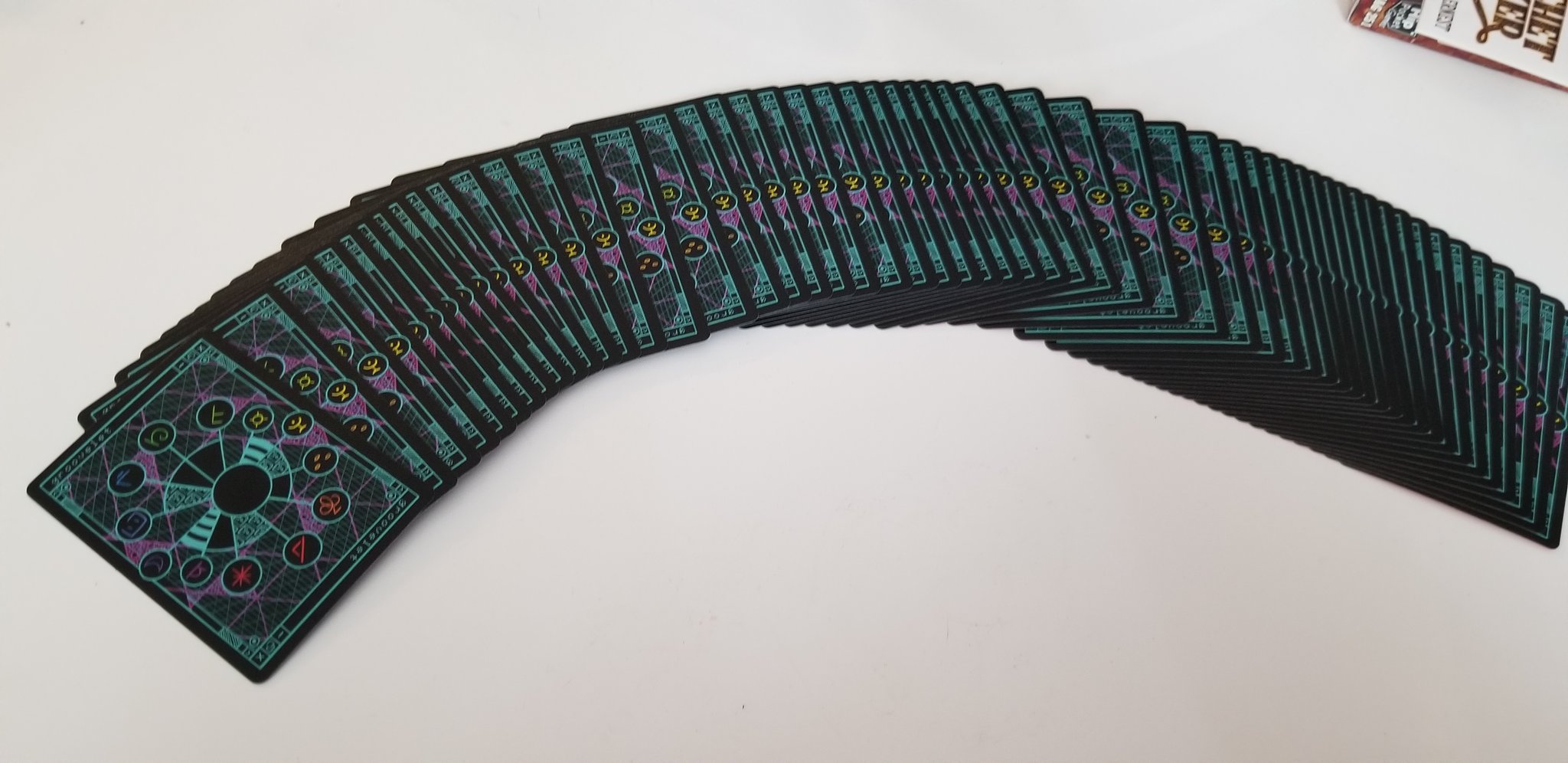
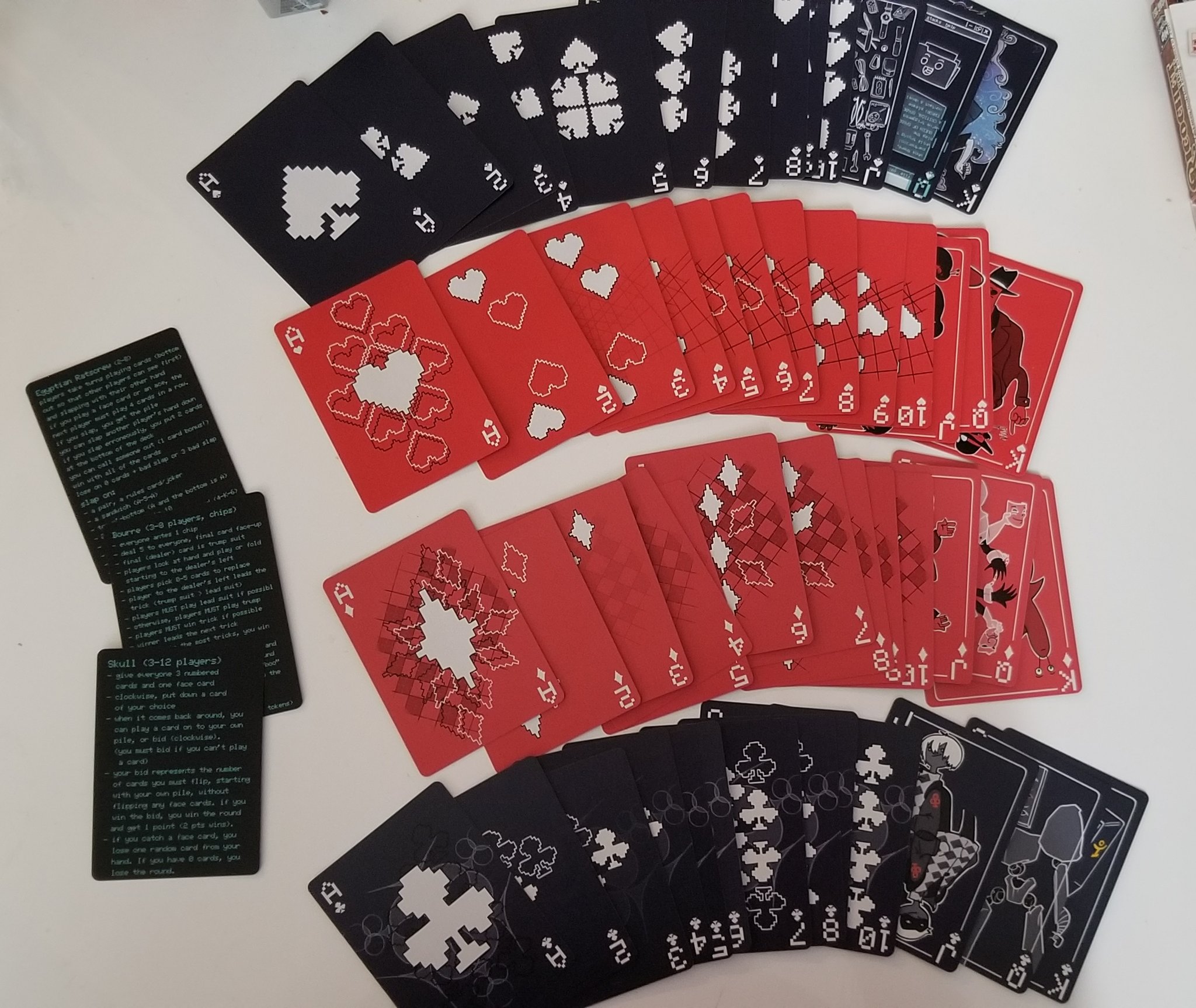


Card Back

Face Cards


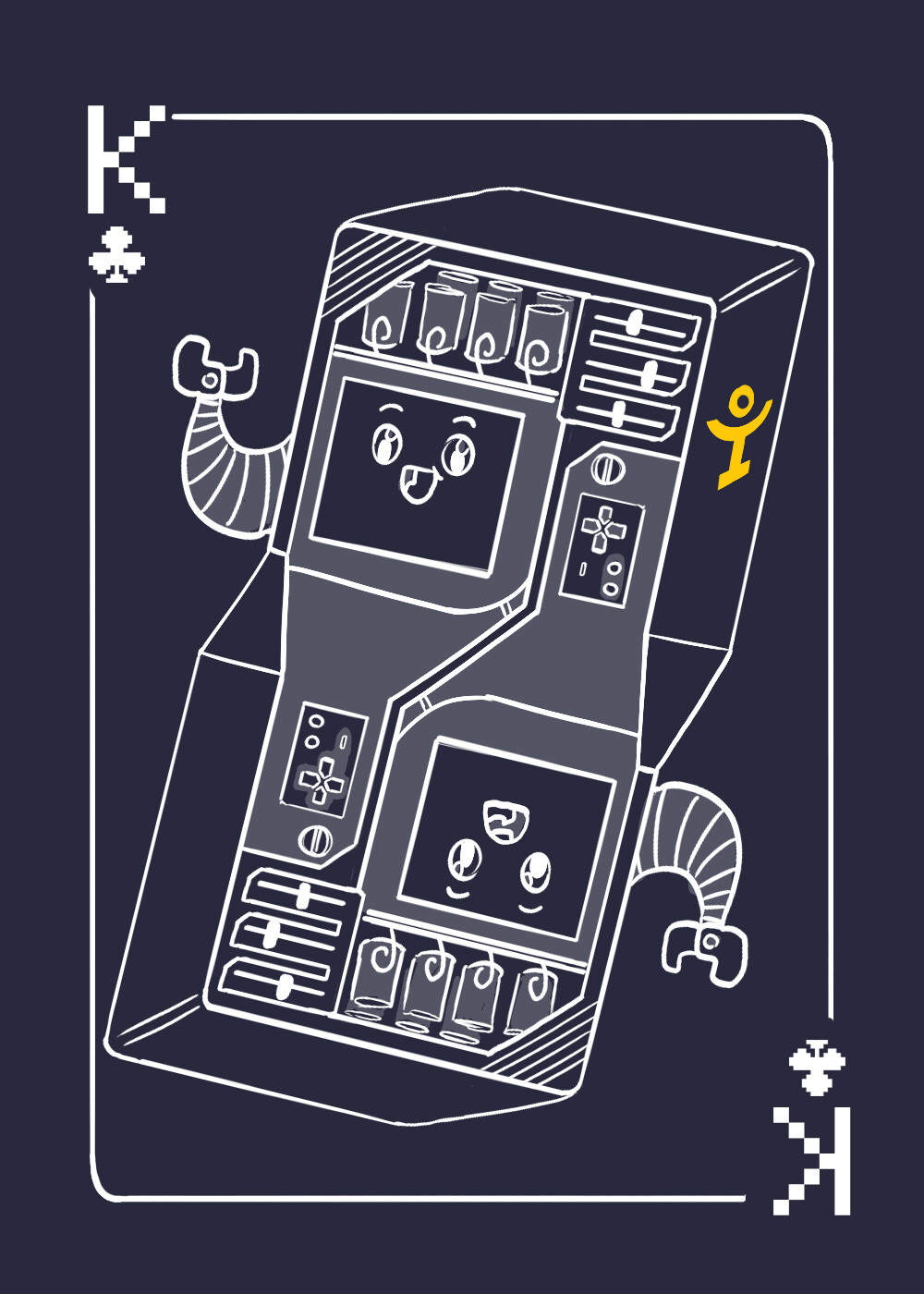
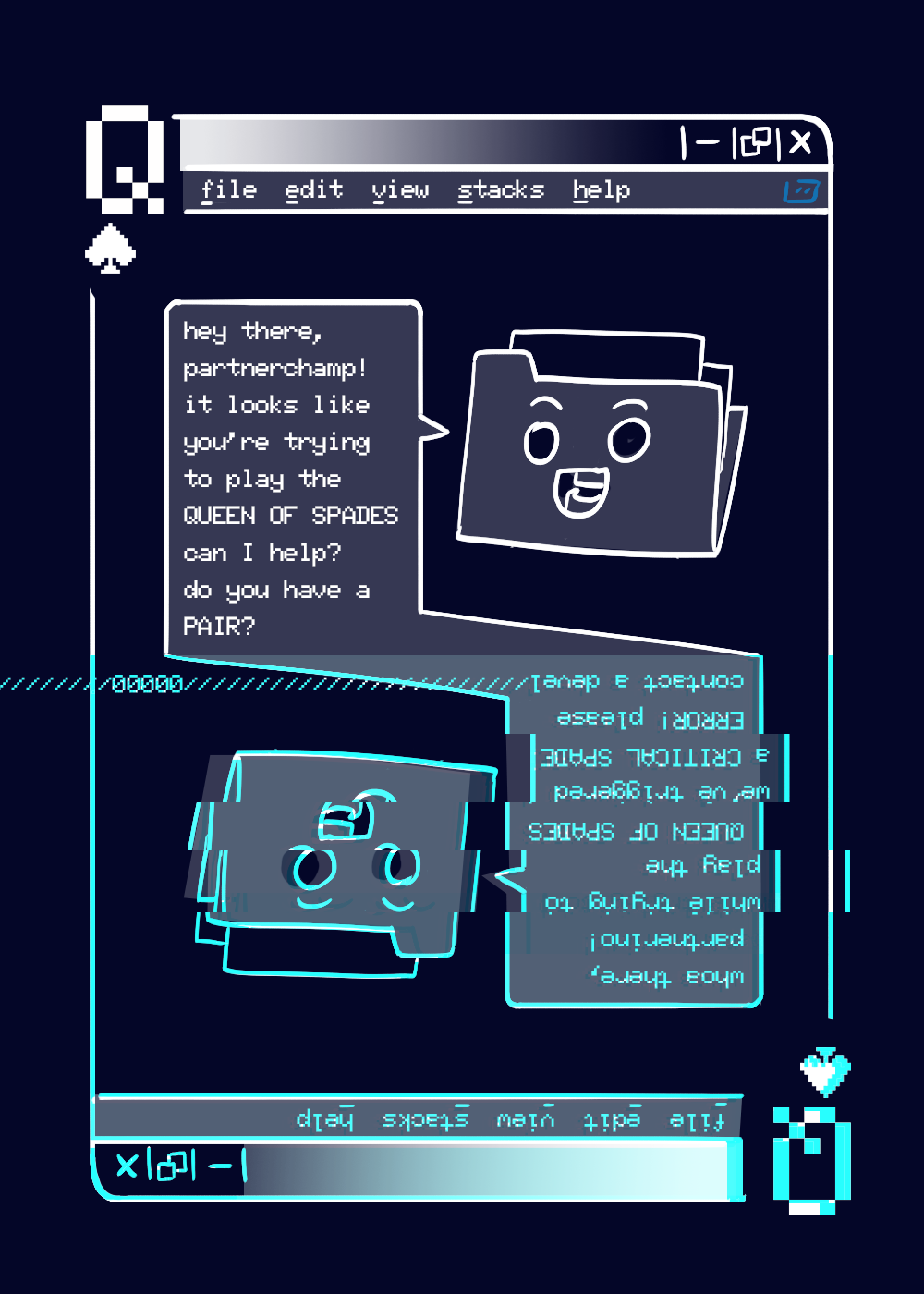
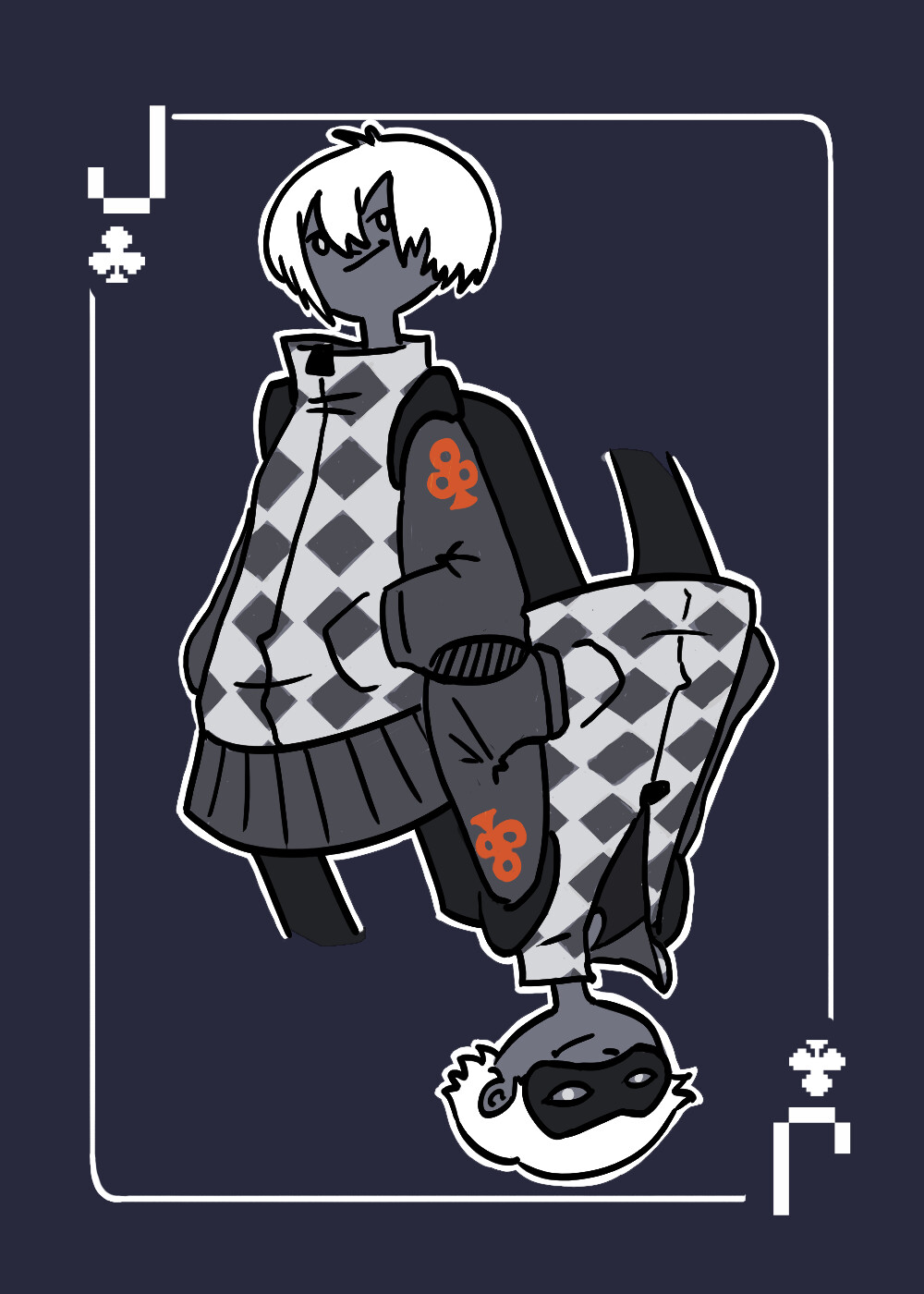

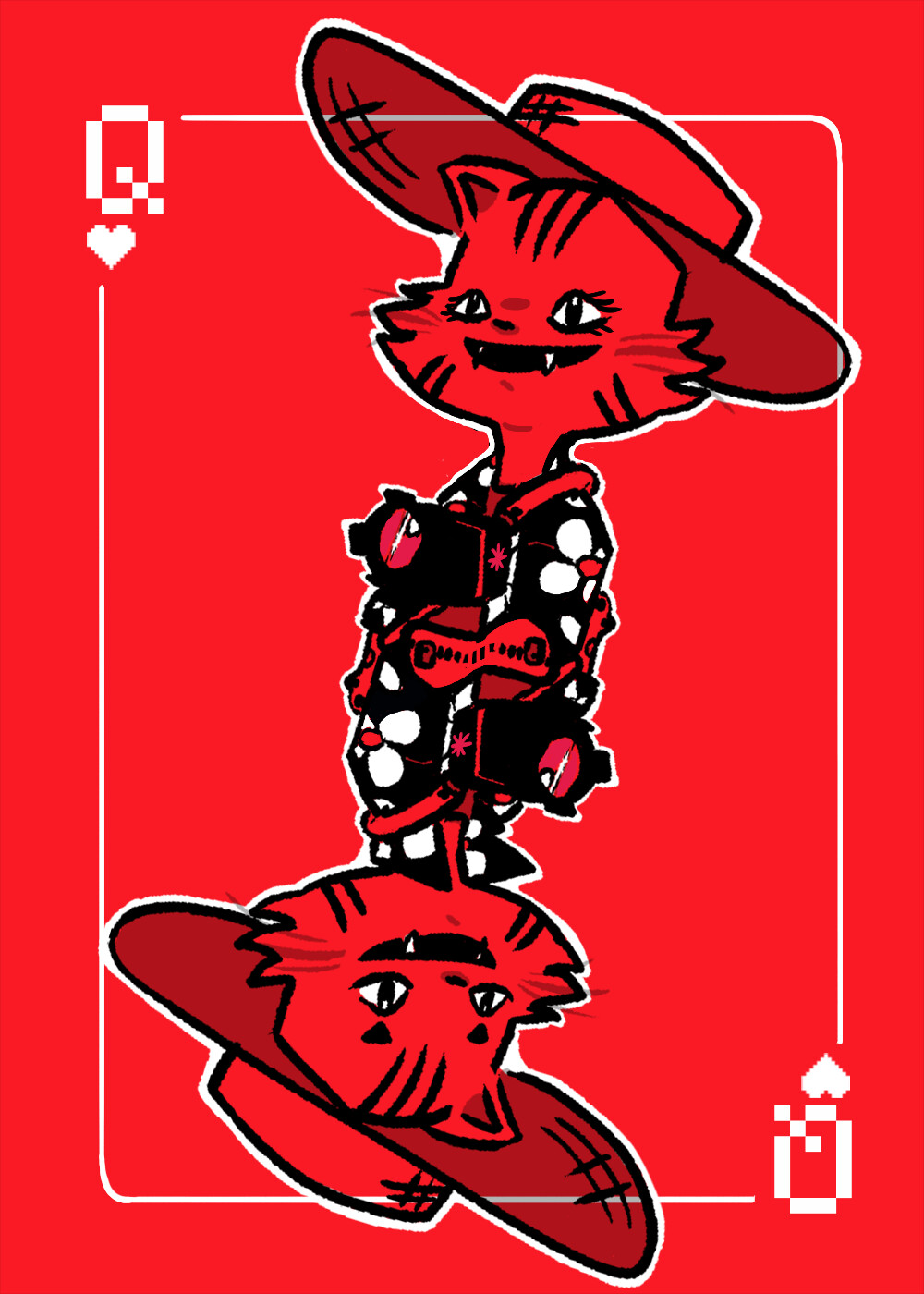

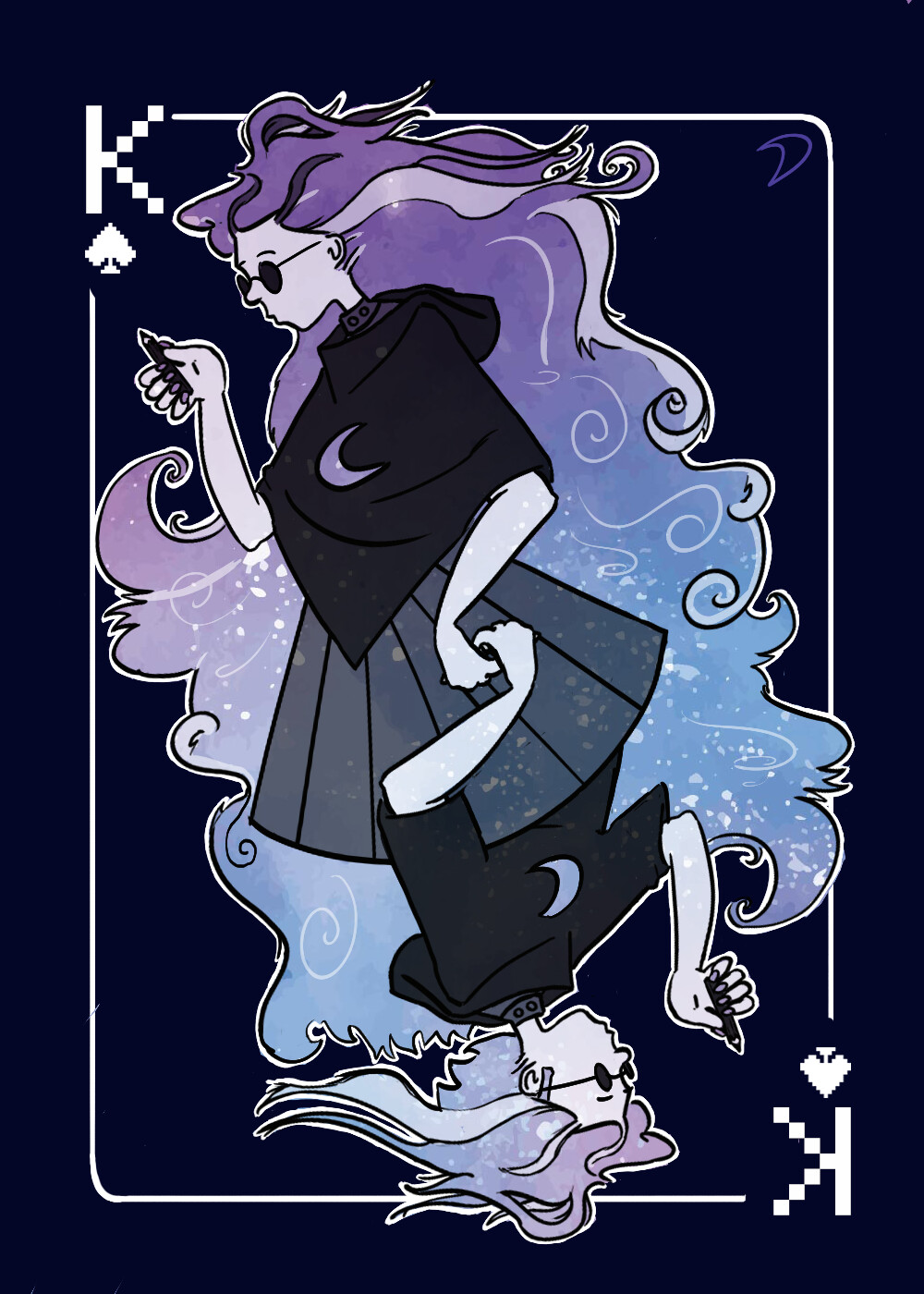
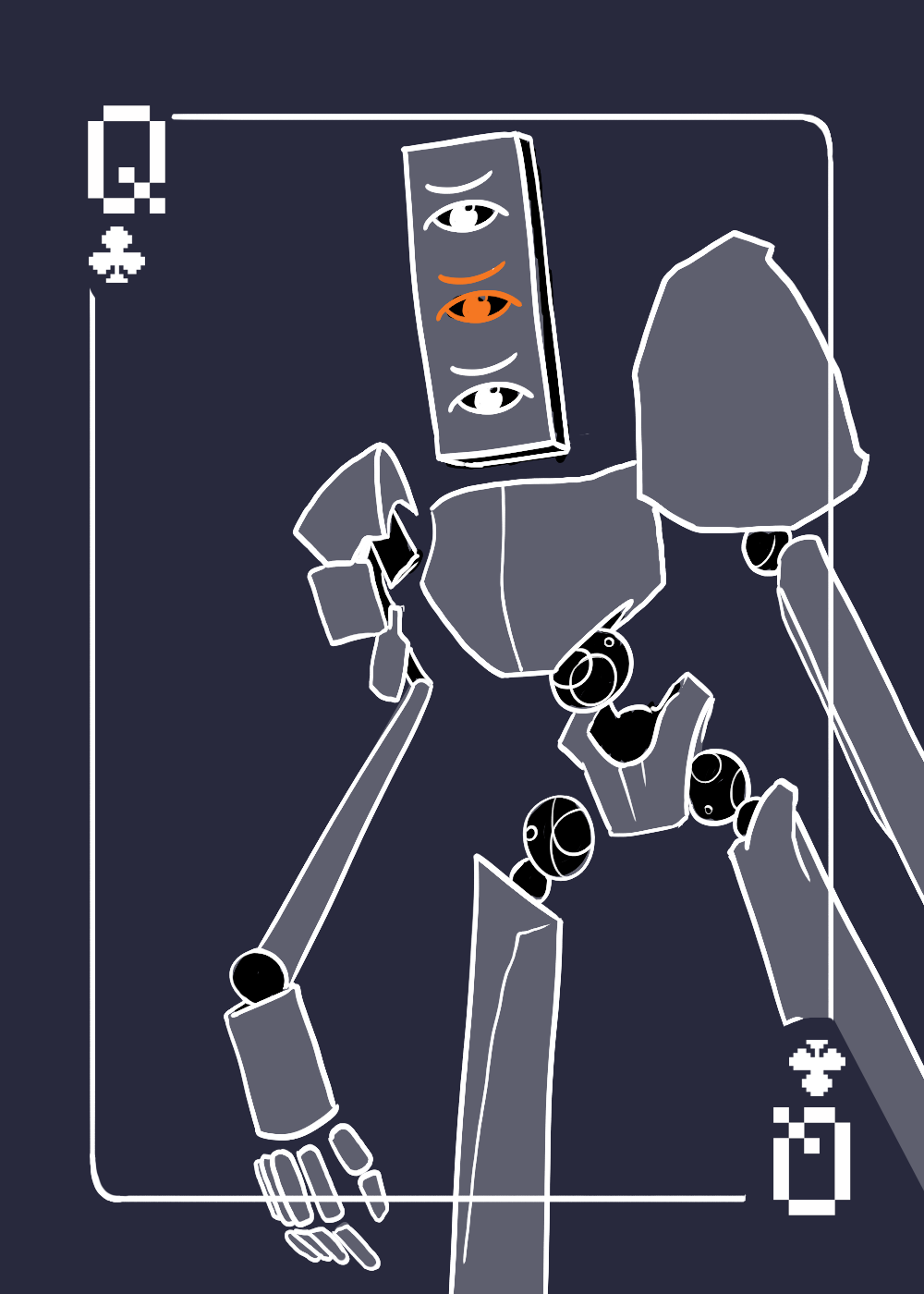
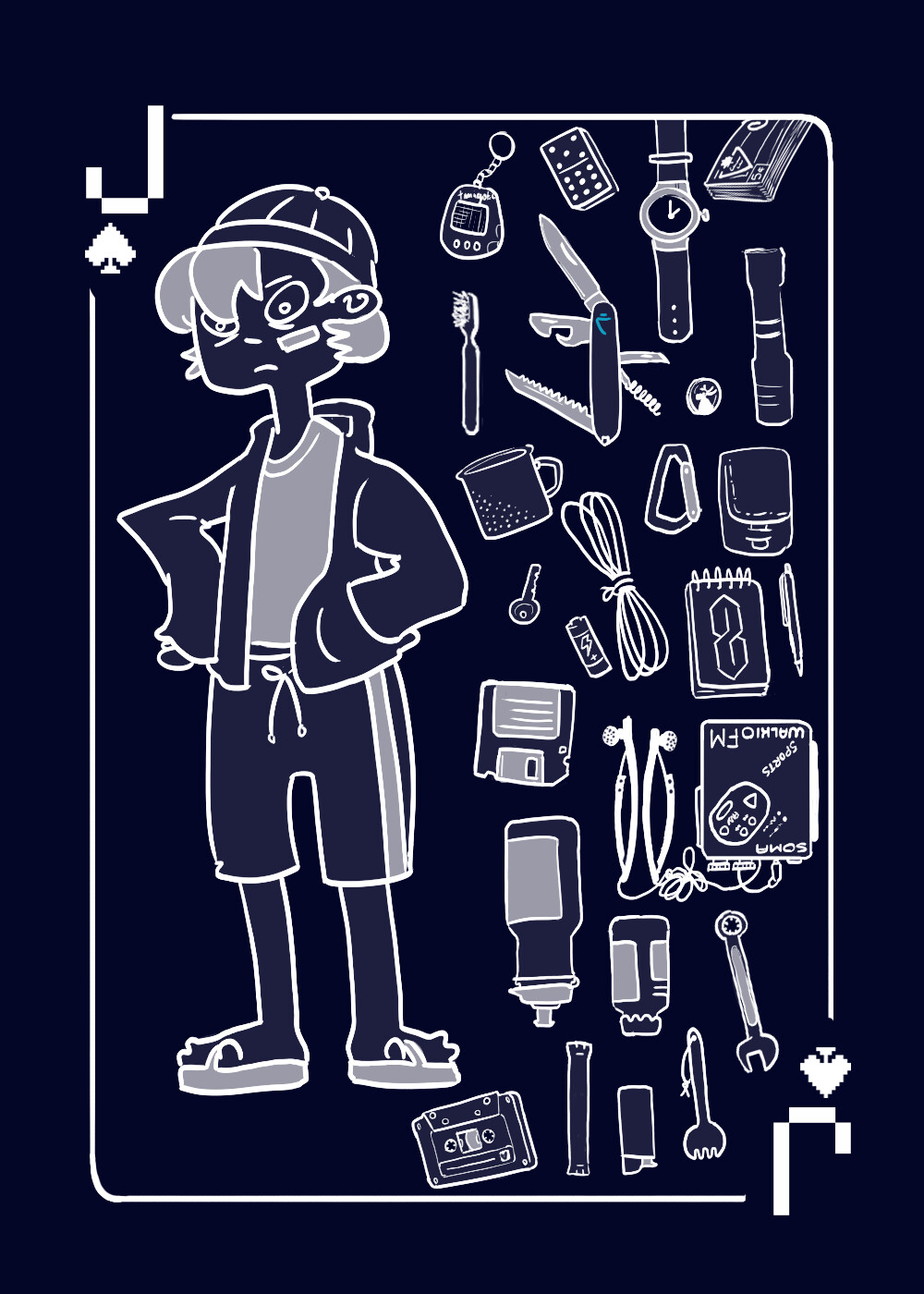

Sample Fantasy RPG Classes
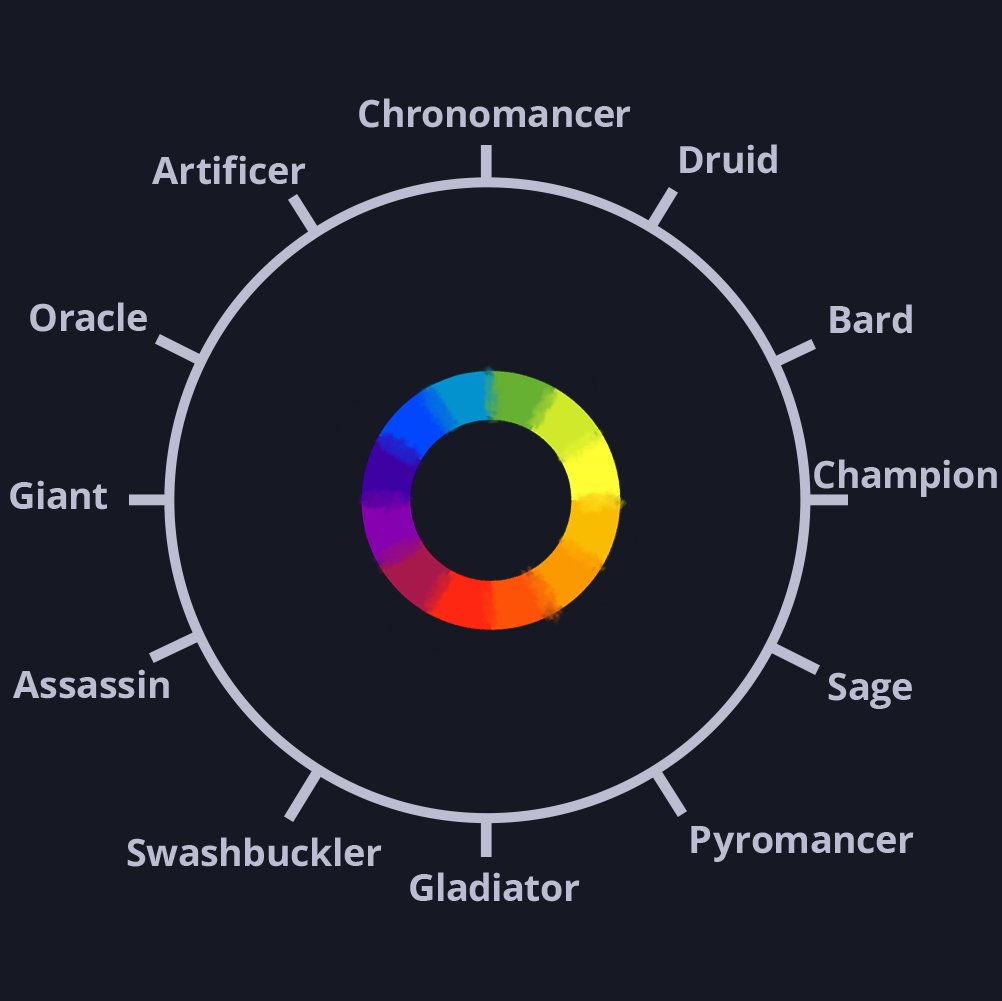
Druid
Primal and bound to nature, the druid controls plants, earth, and beasts.
This slow-moving but powerful class provides defense, healing, and connection to the animal and plant worlds.
Bard
They've brought an electric lute to a sword fight, which is dangerous on the face of it - but their explosion of noise makes them the center of focus on the battlefield.
The rare "low-HP tank", they protect their teammates by drawing focus while also being nearly impossible to hit.
Champion
A brave martial warrior for light and good, their devotion and restraint makes them one of the weakest overall fighters, but what they lack in raw strength they make up for with the power of friendship.
A frontline support class, they make everybody stronger by bolstering their courage.
Sage
Skilled, wise, and thoughtful, their experience makes them unusually effective. They do not hit hard or often, instead preferring a single perfect strike at their foe's weakest point at exactly the right time.
Pyromancer
They have brought so much fire to the party. Damaging friends and foes alike, sometimes it feels unclear whether or not they're helping, but ultimately their enormous damage output is probably a net positive.
Gladiator
Grim and bloody, the gladiator is hardened, strategic and very good with weapons of all kinds.
They have a couple of strong NPCs under their control that they use to bolster their effectiveness.
Swashbuckler
Not great at direct combat but great at tactically controlling the flow of combat, the Swashbuckler directs and shapes the fight to their (and their allies') advantage, making cover, creating vertical distance, and summoning allies to the fray.
They have a couple of weaker NPCs under their control that they use to bolster their effectiveness.
Assassin
Utterly harmless or utterly invisible until it is time to be seen, needing quite a bit of set-up time to strike, the assassin's skill is at picking off one particularly thorny adversary.
Giant
Much, much larger than anything else on the battlefield, most effects simply do not work on them due to their insurmountable size advantage. Can easily pick up and push around allies and opponents. Huge HP pool.
Oracle
Heavily dependent on randomness and inscrutable effects, the Oracle is playing a different game entirely from the rest of the classes: while everyone is deeply engaged in battle, they might be collecting shells or painting everything the color yellow.
If whatever they're trying to trigger comes to pass, victory is immediate, decisive, and crushing. Most of the time, however, they don't accomplish much at all.
Artificer
They brought a lot of useful items. Magic weapons, potions, rings of power, enchanted hats, they're the only class who can stack and combine magic items.
Chronomancer
Time is a terrible thing to waste. Their effects have a lot to do with repetition - retrying failed attacks, rolling back damage, and in the worst case scenario, restarting whole scenarios from the beginning in order to try again.
About
Version Information
This is Version 1.0.5 of the Groovelet: Portable Mythology.
It was last updated July 13, 2025.1
Despite its apparent age, I'm sure it's still relevant FAR IN THE FUTURE, when you're reading it. Hello, from the past! I hope you are enjoying your fun future things, like food pills and flying car that turns into a suitcase and a stable and competent government without even a hint of encroaching fascism. I'm rooting for you! Or dead! Definitely one of those two things!
Update Notes:
- July 11, 2025: GENESIS! CREATION! IT'S ALIVE! (there were lots of updates before this, but this is the first tracked update)
- July 12, 2025: Tidied up for formal launch. Spell-checked. Shared with co-workers, Mastodon.
- July 13, 2025: Attempted to post to
r/worldbuilding. Rebuffed because this document doesn't constitute "real worldbuilding", as it's a general characterful framework rather than a concrete WORLD with, like, locations and what-not. Pfft. PFFT I say. No tolerance for abstraction. Cleaned up the chapter containing the concrete worldbuilding based on Groovelet's mythology to resubmit. - July 13, 2025: The intro - first three chapters, describing what's going on - are described to me as dense, meta, difficult to understand how to use, and so self-effacing that it obscures the value and message. Rewritten and reorganized with more concrete examples, and more "here's how this book works".
- July 14, 2025: Editing & tightening pass on the Harmony and Element chapters.
- July 15, 2025: At a loss for things to do, added a "sample RPG classes" section to the Homework.
Generative AI Use Policy
None, zero, nada, zilch percent of this document was generated by AI2, but I did ask ChatGPT to check it for obvious spelling, grammatical, or consistency errors, and bring my attention to areas that were potentially unclear or confusing, so that I could rewrite them.
I would hope that would be obvious, from the tone.
Who Are You?
I'm Cube Drone, because I'm from an early age of the internet when everybody was pseudonymous all the time.
I've been a lead backend software developer at VRChat since 2016. I write comics, fiddle with software, write, and consume life-threatening amounts of coffee.
Groovelet is the sign of a deeply diseased mind that loves systems a little TOO much. The sort of person with a battered collection of Prima strategy guides for games he doesn't own. The sort of person who has read Fever Knights. The sort of person who's favorite game is the Dwarf Fortress wiki. Not the game. Just the wiki.


